Diploma in Conveyancing: Legal Procedures and Documentation
VerifiedAdded on 2023/06/10
|32
|13119
|266
AI Summary
This course covers legal requirements and procedures involved in property transactions, including conveyancing, real estate, personal and business transactions. It explains the types of properties, documentation, fees, taxes, and compliance requirements. The course also covers conflict of interest, internal control systems, and expert advice. The course is suitable for anyone interested in pursuing a career in conveyancing or real estate.
Contribute Materials
Your contribution can guide someone’s learning journey. Share your
documents today.

Diploma in Conveyancing
Secure Best Marks with AI Grader
Need help grading? Try our AI Grader for instant feedback on your assignments.
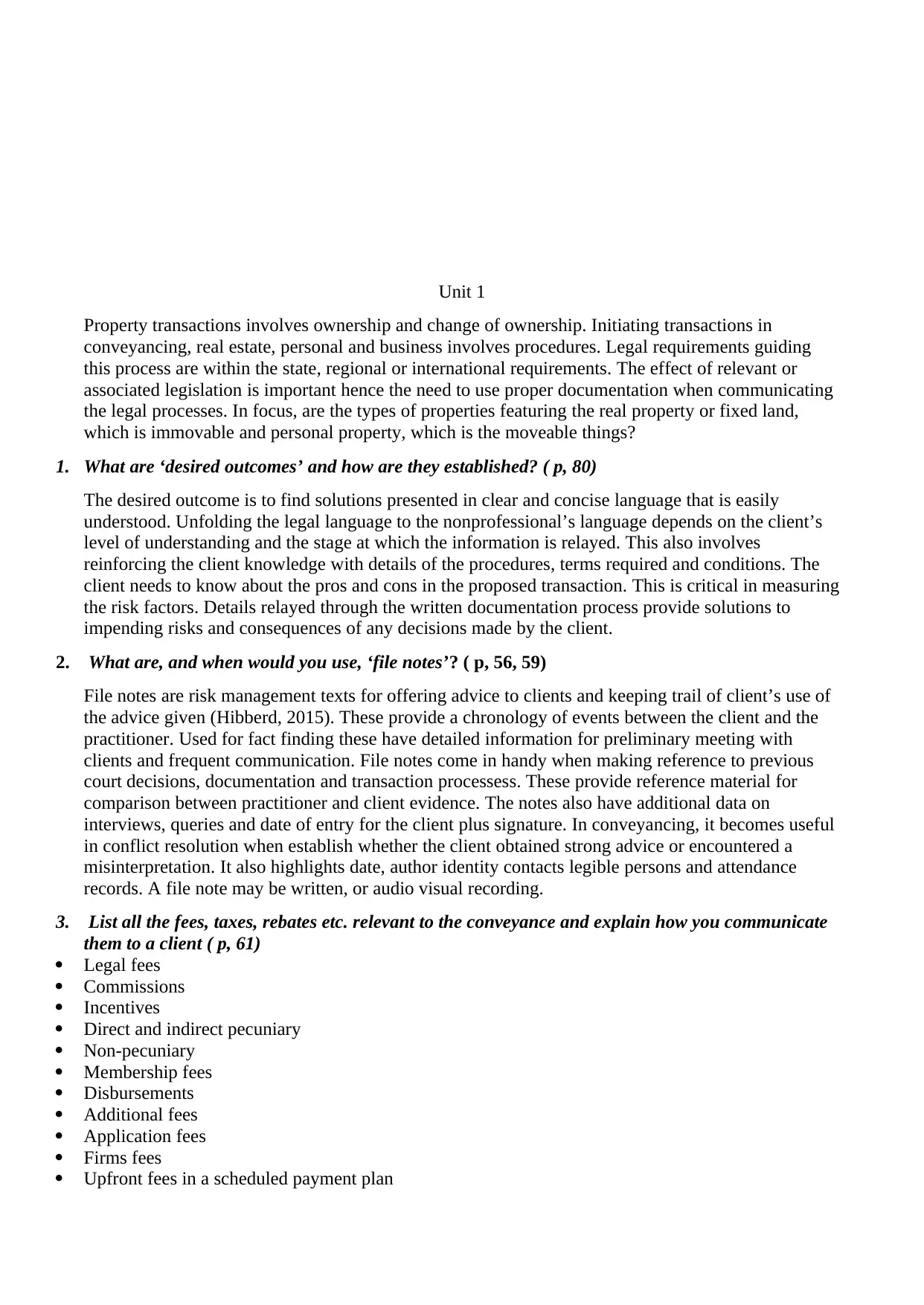
Unit 1
Property transactions involves ownership and change of ownership. Initiating transactions in
conveyancing, real estate, personal and business involves procedures. Legal requirements guiding
this process are within the state, regional or international requirements. The effect of relevant or
associated legislation is important hence the need to use proper documentation when communicating
the legal processes. In focus, are the types of properties featuring the real property or fixed land,
which is immovable and personal property, which is the moveable things?
1. What are ‘desired outcomes’ and how are they established? ( p, 80)
The desired outcome is to find solutions presented in clear and concise language that is easily
understood. Unfolding the legal language to the nonprofessional’s language depends on the client’s
level of understanding and the stage at which the information is relayed. This also involves
reinforcing the client knowledge with details of the procedures, terms required and conditions. The
client needs to know about the pros and cons in the proposed transaction. This is critical in measuring
the risk factors. Details relayed through the written documentation process provide solutions to
impending risks and consequences of any decisions made by the client.
2. What are, and when would you use, ‘file notes’? ( p, 56, 59)
File notes are risk management texts for offering advice to clients and keeping trail of client’s use of
the advice given (Hibberd, 2015). These provide a chronology of events between the client and the
practitioner. Used for fact finding these have detailed information for preliminary meeting with
clients and frequent communication. File notes come in handy when making reference to previous
court decisions, documentation and transaction processess. These provide reference material for
comparison between practitioner and client evidence. The notes also have additional data on
interviews, queries and date of entry for the client plus signature. In conveyancing, it becomes useful
in conflict resolution when establish whether the client obtained strong advice or encountered a
misinterpretation. It also highlights date, author identity contacts legible persons and attendance
records. A file note may be written, or audio visual recording.
3. List all the fees, taxes, rebates etc. relevant to the conveyance and explain how you communicate
them to a client ( p, 61)
Legal fees
Commissions
Incentives
Direct and indirect pecuniary
Non-pecuniary
Membership fees
Disbursements
Additional fees
Application fees
Firms fees
Upfront fees in a scheduled payment plan
Property transactions involves ownership and change of ownership. Initiating transactions in
conveyancing, real estate, personal and business involves procedures. Legal requirements guiding
this process are within the state, regional or international requirements. The effect of relevant or
associated legislation is important hence the need to use proper documentation when communicating
the legal processes. In focus, are the types of properties featuring the real property or fixed land,
which is immovable and personal property, which is the moveable things?
1. What are ‘desired outcomes’ and how are they established? ( p, 80)
The desired outcome is to find solutions presented in clear and concise language that is easily
understood. Unfolding the legal language to the nonprofessional’s language depends on the client’s
level of understanding and the stage at which the information is relayed. This also involves
reinforcing the client knowledge with details of the procedures, terms required and conditions. The
client needs to know about the pros and cons in the proposed transaction. This is critical in measuring
the risk factors. Details relayed through the written documentation process provide solutions to
impending risks and consequences of any decisions made by the client.
2. What are, and when would you use, ‘file notes’? ( p, 56, 59)
File notes are risk management texts for offering advice to clients and keeping trail of client’s use of
the advice given (Hibberd, 2015). These provide a chronology of events between the client and the
practitioner. Used for fact finding these have detailed information for preliminary meeting with
clients and frequent communication. File notes come in handy when making reference to previous
court decisions, documentation and transaction processess. These provide reference material for
comparison between practitioner and client evidence. The notes also have additional data on
interviews, queries and date of entry for the client plus signature. In conveyancing, it becomes useful
in conflict resolution when establish whether the client obtained strong advice or encountered a
misinterpretation. It also highlights date, author identity contacts legible persons and attendance
records. A file note may be written, or audio visual recording.
3. List all the fees, taxes, rebates etc. relevant to the conveyance and explain how you communicate
them to a client ( p, 61)
Legal fees
Commissions
Incentives
Direct and indirect pecuniary
Non-pecuniary
Membership fees
Disbursements
Additional fees
Application fees
Firms fees
Upfront fees in a scheduled payment plan
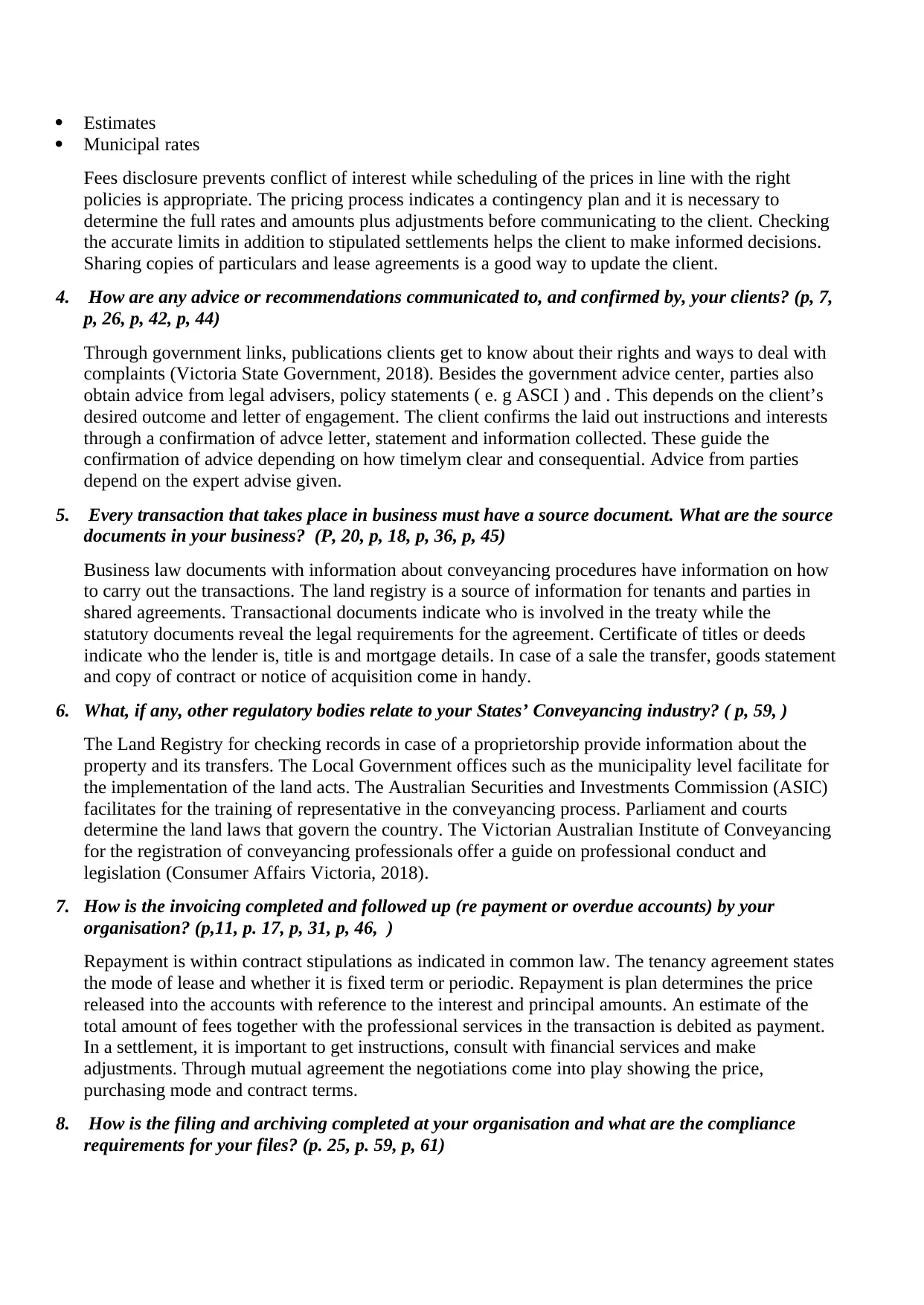
Estimates
Municipal rates
Fees disclosure prevents conflict of interest while scheduling of the prices in line with the right
policies is appropriate. The pricing process indicates a contingency plan and it is necessary to
determine the full rates and amounts plus adjustments before communicating to the client. Checking
the accurate limits in addition to stipulated settlements helps the client to make informed decisions.
Sharing copies of particulars and lease agreements is a good way to update the client.
4. How are any advice or recommendations communicated to, and confirmed by, your clients? (p, 7,
p, 26, p, 42, p, 44)
Through government links, publications clients get to know about their rights and ways to deal with
complaints (Victoria State Government, 2018). Besides the government advice center, parties also
obtain advice from legal advisers, policy statements ( e. g ASCI ) and . This depends on the client’s
desired outcome and letter of engagement. The client confirms the laid out instructions and interests
through a confirmation of advce letter, statement and information collected. These guide the
confirmation of advice depending on how timelym clear and consequential. Advice from parties
depend on the expert advise given.
5. Every transaction that takes place in business must have a source document. What are the source
documents in your business? (P, 20, p, 18, p, 36, p, 45)
Business law documents with information about conveyancing procedures have information on how
to carry out the transactions. The land registry is a source of information for tenants and parties in
shared agreements. Transactional documents indicate who is involved in the treaty while the
statutory documents reveal the legal requirements for the agreement. Certificate of titles or deeds
indicate who the lender is, title is and mortgage details. In case of a sale the transfer, goods statement
and copy of contract or notice of acquisition come in handy.
6. What, if any, other regulatory bodies relate to your States’ Conveyancing industry? ( p, 59, )
The Land Registry for checking records in case of a proprietorship provide information about the
property and its transfers. The Local Government offices such as the municipality level facilitate for
the implementation of the land acts. The Australian Securities and Investments Commission (ASIC)
facilitates for the training of representative in the conveyancing process. Parliament and courts
determine the land laws that govern the country. The Victorian Australian Institute of Conveyancing
for the registration of conveyancing professionals offer a guide on professional conduct and
legislation (Consumer Affairs Victoria, 2018).
7. How is the invoicing completed and followed up (re payment or overdue accounts) by your
organisation? (p,11, p. 17, p, 31, p, 46, )
Repayment is within contract stipulations as indicated in common law. The tenancy agreement states
the mode of lease and whether it is fixed term or periodic. Repayment is plan determines the price
released into the accounts with reference to the interest and principal amounts. An estimate of the
total amount of fees together with the professional services in the transaction is debited as payment.
In a settlement, it is important to get instructions, consult with financial services and make
adjustments. Through mutual agreement the negotiations come into play showing the price,
purchasing mode and contract terms.
8. How is the filing and archiving completed at your organisation and what are the compliance
requirements for your files? (p. 25, p. 59, p, 61)
Municipal rates
Fees disclosure prevents conflict of interest while scheduling of the prices in line with the right
policies is appropriate. The pricing process indicates a contingency plan and it is necessary to
determine the full rates and amounts plus adjustments before communicating to the client. Checking
the accurate limits in addition to stipulated settlements helps the client to make informed decisions.
Sharing copies of particulars and lease agreements is a good way to update the client.
4. How are any advice or recommendations communicated to, and confirmed by, your clients? (p, 7,
p, 26, p, 42, p, 44)
Through government links, publications clients get to know about their rights and ways to deal with
complaints (Victoria State Government, 2018). Besides the government advice center, parties also
obtain advice from legal advisers, policy statements ( e. g ASCI ) and . This depends on the client’s
desired outcome and letter of engagement. The client confirms the laid out instructions and interests
through a confirmation of advce letter, statement and information collected. These guide the
confirmation of advice depending on how timelym clear and consequential. Advice from parties
depend on the expert advise given.
5. Every transaction that takes place in business must have a source document. What are the source
documents in your business? (P, 20, p, 18, p, 36, p, 45)
Business law documents with information about conveyancing procedures have information on how
to carry out the transactions. The land registry is a source of information for tenants and parties in
shared agreements. Transactional documents indicate who is involved in the treaty while the
statutory documents reveal the legal requirements for the agreement. Certificate of titles or deeds
indicate who the lender is, title is and mortgage details. In case of a sale the transfer, goods statement
and copy of contract or notice of acquisition come in handy.
6. What, if any, other regulatory bodies relate to your States’ Conveyancing industry? ( p, 59, )
The Land Registry for checking records in case of a proprietorship provide information about the
property and its transfers. The Local Government offices such as the municipality level facilitate for
the implementation of the land acts. The Australian Securities and Investments Commission (ASIC)
facilitates for the training of representative in the conveyancing process. Parliament and courts
determine the land laws that govern the country. The Victorian Australian Institute of Conveyancing
for the registration of conveyancing professionals offer a guide on professional conduct and
legislation (Consumer Affairs Victoria, 2018).
7. How is the invoicing completed and followed up (re payment or overdue accounts) by your
organisation? (p,11, p. 17, p, 31, p, 46, )
Repayment is within contract stipulations as indicated in common law. The tenancy agreement states
the mode of lease and whether it is fixed term or periodic. Repayment is plan determines the price
released into the accounts with reference to the interest and principal amounts. An estimate of the
total amount of fees together with the professional services in the transaction is debited as payment.
In a settlement, it is important to get instructions, consult with financial services and make
adjustments. Through mutual agreement the negotiations come into play showing the price,
purchasing mode and contract terms.
8. How is the filing and archiving completed at your organisation and what are the compliance
requirements for your files? (p. 25, p. 59, p, 61)
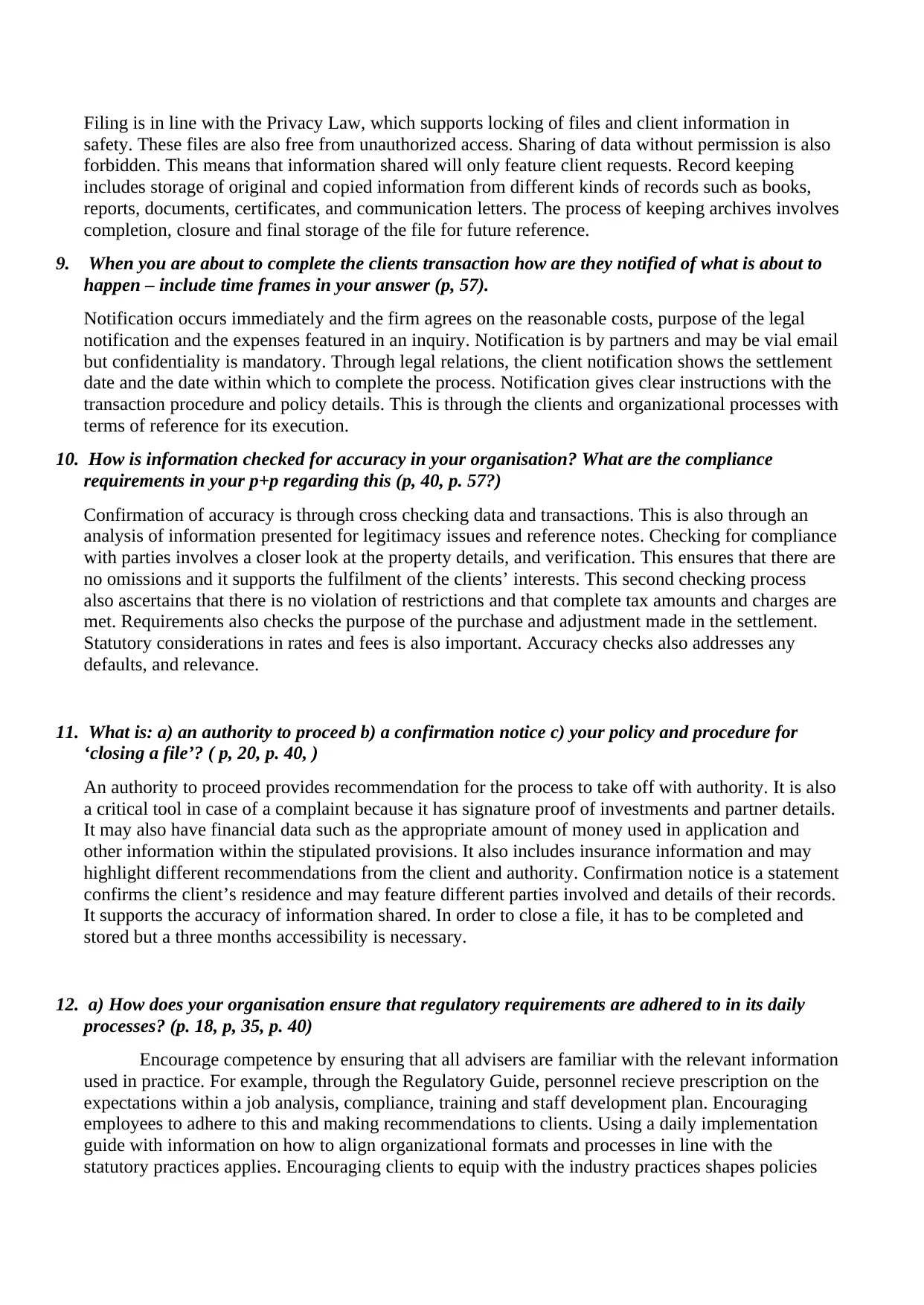
Filing is in line with the Privacy Law, which supports locking of files and client information in
safety. These files are also free from unauthorized access. Sharing of data without permission is also
forbidden. This means that information shared will only feature client requests. Record keeping
includes storage of original and copied information from different kinds of records such as books,
reports, documents, certificates, and communication letters. The process of keeping archives involves
completion, closure and final storage of the file for future reference.
9. When you are about to complete the clients transaction how are they notified of what is about to
happen – include time frames in your answer (p, 57).
Notification occurs immediately and the firm agrees on the reasonable costs, purpose of the legal
notification and the expenses featured in an inquiry. Notification is by partners and may be vial email
but confidentiality is mandatory. Through legal relations, the client notification shows the settlement
date and the date within which to complete the process. Notification gives clear instructions with the
transaction procedure and policy details. This is through the clients and organizational processes with
terms of reference for its execution.
10. How is information checked for accuracy in your organisation? What are the compliance
requirements in your p+p regarding this (p, 40, p. 57?)
Confirmation of accuracy is through cross checking data and transactions. This is also through an
analysis of information presented for legitimacy issues and reference notes. Checking for compliance
with parties involves a closer look at the property details, and verification. This ensures that there are
no omissions and it supports the fulfilment of the clients’ interests. This second checking process
also ascertains that there is no violation of restrictions and that complete tax amounts and charges are
met. Requirements also checks the purpose of the purchase and adjustment made in the settlement.
Statutory considerations in rates and fees is also important. Accuracy checks also addresses any
defaults, and relevance.
11. What is: a) an authority to proceed b) a confirmation notice c) your policy and procedure for
‘closing a file’? ( p, 20, p. 40, )
An authority to proceed provides recommendation for the process to take off with authority. It is also
a critical tool in case of a complaint because it has signature proof of investments and partner details.
It may also have financial data such as the appropriate amount of money used in application and
other information within the stipulated provisions. It also includes insurance information and may
highlight different recommendations from the client and authority. Confirmation notice is a statement
confirms the client’s residence and may feature different parties involved and details of their records.
It supports the accuracy of information shared. In order to close a file, it has to be completed and
stored but a three months accessibility is necessary.
12. a) How does your organisation ensure that regulatory requirements are adhered to in its daily
processes? (p. 18, p, 35, p. 40)
Encourage competence by ensuring that all advisers are familiar with the relevant information
used in practice. For example, through the Regulatory Guide, personnel recieve prescription on the
expectations within a job analysis, compliance, training and staff development plan. Encouraging
employees to adhere to this and making recommendations to clients. Using a daily implementation
guide with information on how to align organizational formats and processes in line with the
statutory practices applies. Encouraging clients to equip with the industry practices shapes policies
safety. These files are also free from unauthorized access. Sharing of data without permission is also
forbidden. This means that information shared will only feature client requests. Record keeping
includes storage of original and copied information from different kinds of records such as books,
reports, documents, certificates, and communication letters. The process of keeping archives involves
completion, closure and final storage of the file for future reference.
9. When you are about to complete the clients transaction how are they notified of what is about to
happen – include time frames in your answer (p, 57).
Notification occurs immediately and the firm agrees on the reasonable costs, purpose of the legal
notification and the expenses featured in an inquiry. Notification is by partners and may be vial email
but confidentiality is mandatory. Through legal relations, the client notification shows the settlement
date and the date within which to complete the process. Notification gives clear instructions with the
transaction procedure and policy details. This is through the clients and organizational processes with
terms of reference for its execution.
10. How is information checked for accuracy in your organisation? What are the compliance
requirements in your p+p regarding this (p, 40, p. 57?)
Confirmation of accuracy is through cross checking data and transactions. This is also through an
analysis of information presented for legitimacy issues and reference notes. Checking for compliance
with parties involves a closer look at the property details, and verification. This ensures that there are
no omissions and it supports the fulfilment of the clients’ interests. This second checking process
also ascertains that there is no violation of restrictions and that complete tax amounts and charges are
met. Requirements also checks the purpose of the purchase and adjustment made in the settlement.
Statutory considerations in rates and fees is also important. Accuracy checks also addresses any
defaults, and relevance.
11. What is: a) an authority to proceed b) a confirmation notice c) your policy and procedure for
‘closing a file’? ( p, 20, p. 40, )
An authority to proceed provides recommendation for the process to take off with authority. It is also
a critical tool in case of a complaint because it has signature proof of investments and partner details.
It may also have financial data such as the appropriate amount of money used in application and
other information within the stipulated provisions. It also includes insurance information and may
highlight different recommendations from the client and authority. Confirmation notice is a statement
confirms the client’s residence and may feature different parties involved and details of their records.
It supports the accuracy of information shared. In order to close a file, it has to be completed and
stored but a three months accessibility is necessary.
12. a) How does your organisation ensure that regulatory requirements are adhered to in its daily
processes? (p. 18, p, 35, p. 40)
Encourage competence by ensuring that all advisers are familiar with the relevant information
used in practice. For example, through the Regulatory Guide, personnel recieve prescription on the
expectations within a job analysis, compliance, training and staff development plan. Encouraging
employees to adhere to this and making recommendations to clients. Using a daily implementation
guide with information on how to align organizational formats and processes in line with the
statutory practices applies. Encouraging clients to equip with the industry practices shapes policies
Secure Best Marks with AI Grader
Need help grading? Try our AI Grader for instant feedback on your assignments.
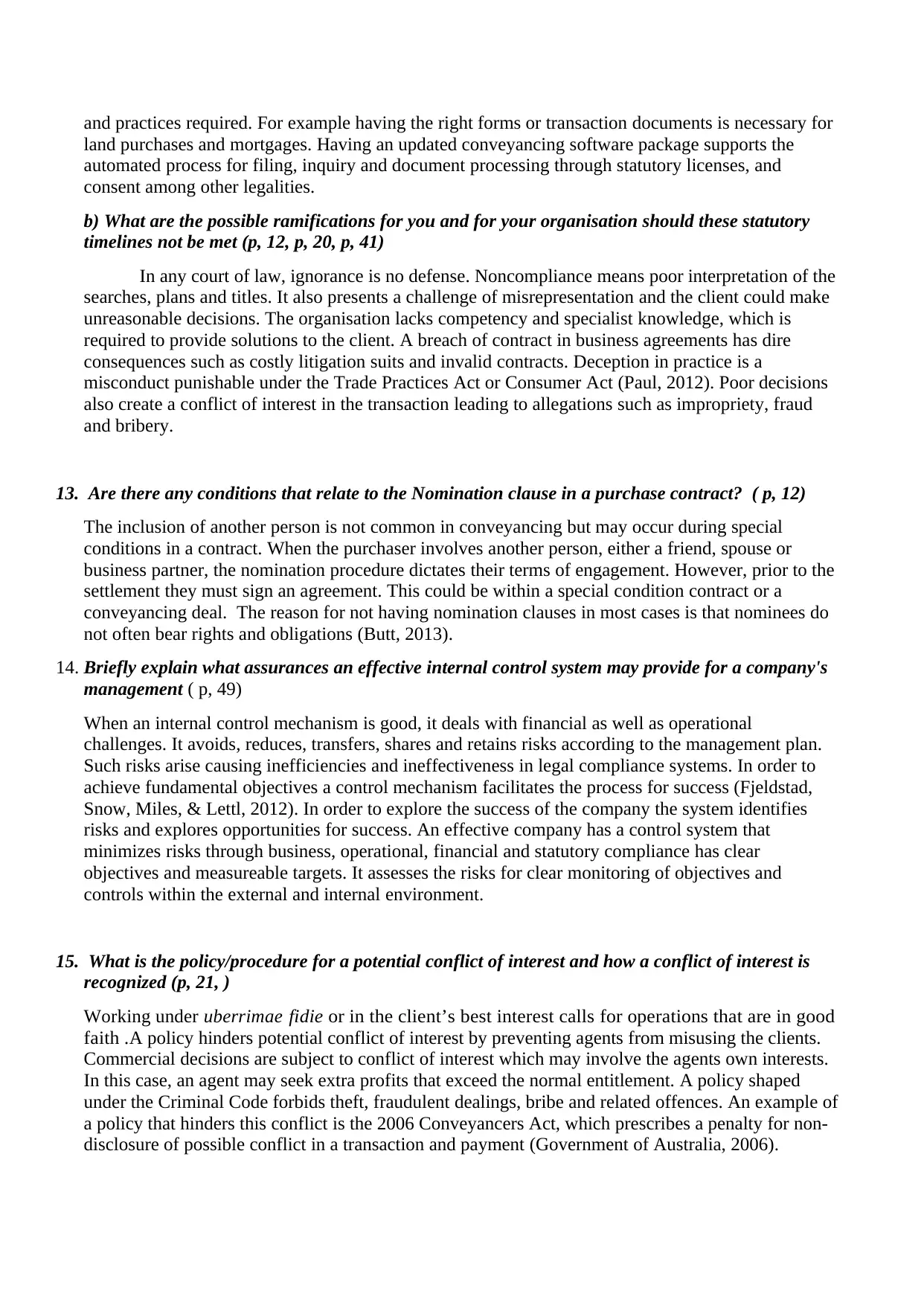
and practices required. For example having the right forms or transaction documents is necessary for
land purchases and mortgages. Having an updated conveyancing software package supports the
automated process for filing, inquiry and document processing through statutory licenses, and
consent among other legalities.
b) What are the possible ramifications for you and for your organisation should these statutory
timelines not be met (p, 12, p, 20, p, 41)
In any court of law, ignorance is no defense. Noncompliance means poor interpretation of the
searches, plans and titles. It also presents a challenge of misrepresentation and the client could make
unreasonable decisions. The organisation lacks competency and specialist knowledge, which is
required to provide solutions to the client. A breach of contract in business agreements has dire
consequences such as costly litigation suits and invalid contracts. Deception in practice is a
misconduct punishable under the Trade Practices Act or Consumer Act (Paul, 2012). Poor decisions
also create a conflict of interest in the transaction leading to allegations such as impropriety, fraud
and bribery.
13. Are there any conditions that relate to the Nomination clause in a purchase contract? ( p, 12)
The inclusion of another person is not common in conveyancing but may occur during special
conditions in a contract. When the purchaser involves another person, either a friend, spouse or
business partner, the nomination procedure dictates their terms of engagement. However, prior to the
settlement they must sign an agreement. This could be within a special condition contract or a
conveyancing deal. The reason for not having nomination clauses in most cases is that nominees do
not often bear rights and obligations (Butt, 2013).
14. Briefly explain what assurances an effective internal control system may provide for a company's
management ( p, 49)
When an internal control mechanism is good, it deals with financial as well as operational
challenges. It avoids, reduces, transfers, shares and retains risks according to the management plan.
Such risks arise causing inefficiencies and ineffectiveness in legal compliance systems. In order to
achieve fundamental objectives a control mechanism facilitates the process for success (Fjeldstad,
Snow, Miles, & Lettl, 2012). In order to explore the success of the company the system identifies
risks and explores opportunities for success. An effective company has a control system that
minimizes risks through business, operational, financial and statutory compliance has clear
objectives and measureable targets. It assesses the risks for clear monitoring of objectives and
controls within the external and internal environment.
15. What is the policy/procedure for a potential conflict of interest and how a conflict of interest is
recognized (p, 21, )
Working under uberrimae fi di e or in the client’s best interest calls for operations that are in good
faith .A policy hinders potential conflict of interest by preventing agents from misusing the clients.
Commercial decisions are subject to conflict of interest which may involve the agents own interests.
In this case, an agent may seek extra profits that exceed the normal entitlement. A policy shaped
under the Criminal Code forbids theft, fraudulent dealings, bribe and related offences. An example of
a policy that hinders this conflict is the 2006 Conveyancers Act, which prescribes a penalty for non-
disclosure of possible conflict in a transaction and payment (Government of Australia, 2006).
land purchases and mortgages. Having an updated conveyancing software package supports the
automated process for filing, inquiry and document processing through statutory licenses, and
consent among other legalities.
b) What are the possible ramifications for you and for your organisation should these statutory
timelines not be met (p, 12, p, 20, p, 41)
In any court of law, ignorance is no defense. Noncompliance means poor interpretation of the
searches, plans and titles. It also presents a challenge of misrepresentation and the client could make
unreasonable decisions. The organisation lacks competency and specialist knowledge, which is
required to provide solutions to the client. A breach of contract in business agreements has dire
consequences such as costly litigation suits and invalid contracts. Deception in practice is a
misconduct punishable under the Trade Practices Act or Consumer Act (Paul, 2012). Poor decisions
also create a conflict of interest in the transaction leading to allegations such as impropriety, fraud
and bribery.
13. Are there any conditions that relate to the Nomination clause in a purchase contract? ( p, 12)
The inclusion of another person is not common in conveyancing but may occur during special
conditions in a contract. When the purchaser involves another person, either a friend, spouse or
business partner, the nomination procedure dictates their terms of engagement. However, prior to the
settlement they must sign an agreement. This could be within a special condition contract or a
conveyancing deal. The reason for not having nomination clauses in most cases is that nominees do
not often bear rights and obligations (Butt, 2013).
14. Briefly explain what assurances an effective internal control system may provide for a company's
management ( p, 49)
When an internal control mechanism is good, it deals with financial as well as operational
challenges. It avoids, reduces, transfers, shares and retains risks according to the management plan.
Such risks arise causing inefficiencies and ineffectiveness in legal compliance systems. In order to
achieve fundamental objectives a control mechanism facilitates the process for success (Fjeldstad,
Snow, Miles, & Lettl, 2012). In order to explore the success of the company the system identifies
risks and explores opportunities for success. An effective company has a control system that
minimizes risks through business, operational, financial and statutory compliance has clear
objectives and measureable targets. It assesses the risks for clear monitoring of objectives and
controls within the external and internal environment.
15. What is the policy/procedure for a potential conflict of interest and how a conflict of interest is
recognized (p, 21, )
Working under uberrimae fi di e or in the client’s best interest calls for operations that are in good
faith .A policy hinders potential conflict of interest by preventing agents from misusing the clients.
Commercial decisions are subject to conflict of interest which may involve the agents own interests.
In this case, an agent may seek extra profits that exceed the normal entitlement. A policy shaped
under the Criminal Code forbids theft, fraudulent dealings, bribe and related offences. An example of
a policy that hinders this conflict is the 2006 Conveyancers Act, which prescribes a penalty for non-
disclosure of possible conflict in a transaction and payment (Government of Australia, 2006).
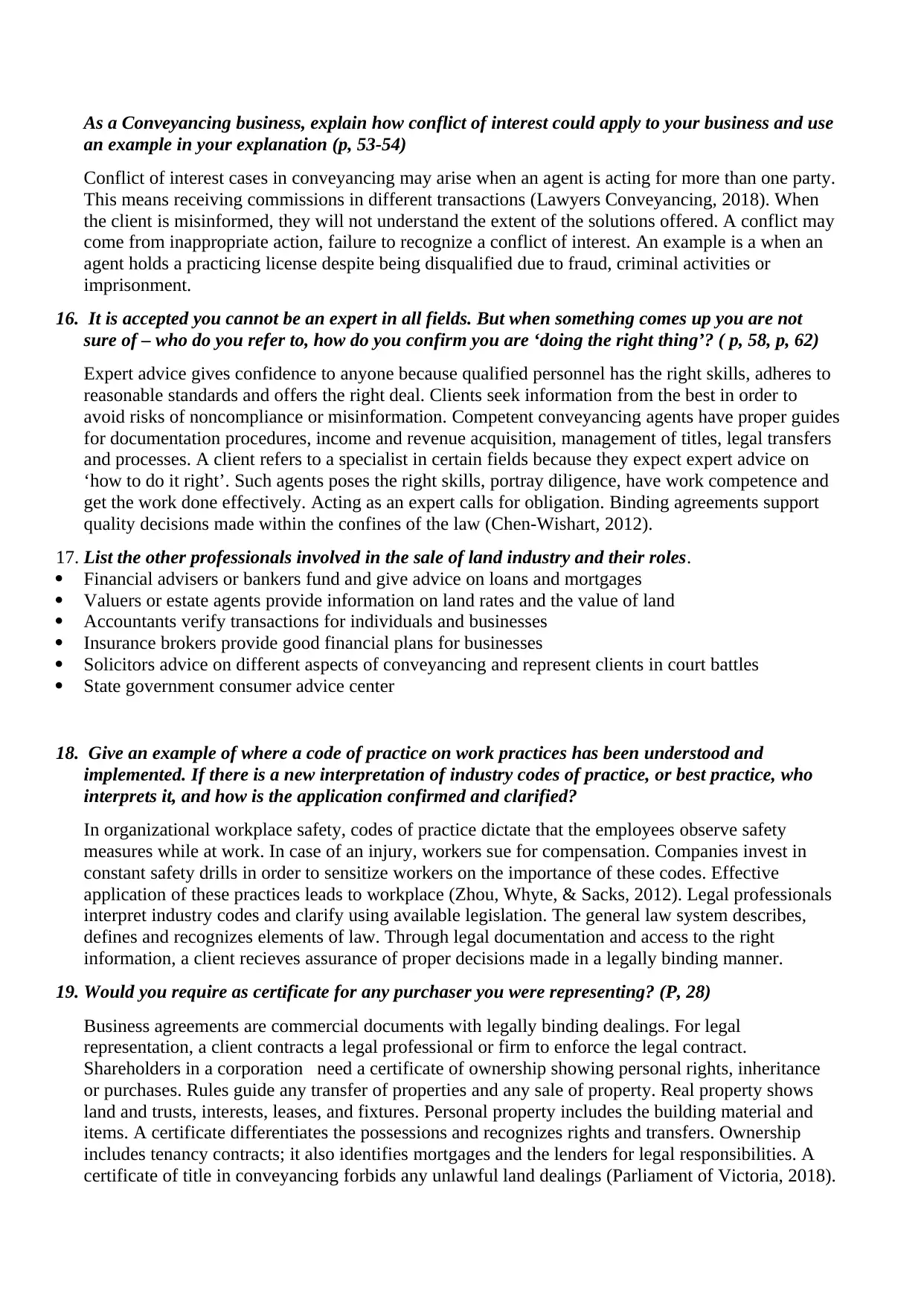
As a Conveyancing business, explain how conflict of interest could apply to your business and use
an example in your explanation (p, 53-54)
Conflict of interest cases in conveyancing may arise when an agent is acting for more than one party.
This means receiving commissions in different transactions (Lawyers Conveyancing, 2018). When
the client is misinformed, they will not understand the extent of the solutions offered. A conflict may
come from inappropriate action, failure to recognize a conflict of interest. An example is a when an
agent holds a practicing license despite being disqualified due to fraud, criminal activities or
imprisonment.
16. It is accepted you cannot be an expert in all fields. But when something comes up you are not
sure of – who do you refer to, how do you confirm you are ‘doing the right thing’? ( p, 58, p, 62)
Expert advice gives confidence to anyone because qualified personnel has the right skills, adheres to
reasonable standards and offers the right deal. Clients seek information from the best in order to
avoid risks of noncompliance or misinformation. Competent conveyancing agents have proper guides
for documentation procedures, income and revenue acquisition, management of titles, legal transfers
and processes. A client refers to a specialist in certain fields because they expect expert advice on
‘how to do it right’. Such agents poses the right skills, portray diligence, have work competence and
get the work done effectively. Acting as an expert calls for obligation. Binding agreements support
quality decisions made within the confines of the law (Chen-Wishart, 2012).
17. List the other professionals involved in the sale of land industry and their roles.
Financial advisers or bankers fund and give advice on loans and mortgages
Valuers or estate agents provide information on land rates and the value of land
Accountants verify transactions for individuals and businesses
Insurance brokers provide good financial plans for businesses
Solicitors advice on different aspects of conveyancing and represent clients in court battles
State government consumer advice center
18. Give an example of where a code of practice on work practices has been understood and
implemented. If there is a new interpretation of industry codes of practice, or best practice, who
interprets it, and how is the application confirmed and clarified?
In organizational workplace safety, codes of practice dictate that the employees observe safety
measures while at work. In case of an injury, workers sue for compensation. Companies invest in
constant safety drills in order to sensitize workers on the importance of these codes. Effective
application of these practices leads to workplace (Zhou, Whyte, & Sacks, 2012). Legal professionals
interpret industry codes and clarify using available legislation. The general law system describes,
defines and recognizes elements of law. Through legal documentation and access to the right
information, a client recieves assurance of proper decisions made in a legally binding manner.
19. Would you require as certificate for any purchaser you were representing? (P, 28)
Business agreements are commercial documents with legally binding dealings. For legal
representation, a client contracts a legal professional or firm to enforce the legal contract.
Shareholders in a corporation need a certificate of ownership showing personal rights, inheritance
or purchases. Rules guide any transfer of properties and any sale of property. Real property shows
land and trusts, interests, leases, and fixtures. Personal property includes the building material and
items. A certificate differentiates the possessions and recognizes rights and transfers. Ownership
includes tenancy contracts; it also identifies mortgages and the lenders for legal responsibilities. A
certificate of title in conveyancing forbids any unlawful land dealings (Parliament of Victoria, 2018).
an example in your explanation (p, 53-54)
Conflict of interest cases in conveyancing may arise when an agent is acting for more than one party.
This means receiving commissions in different transactions (Lawyers Conveyancing, 2018). When
the client is misinformed, they will not understand the extent of the solutions offered. A conflict may
come from inappropriate action, failure to recognize a conflict of interest. An example is a when an
agent holds a practicing license despite being disqualified due to fraud, criminal activities or
imprisonment.
16. It is accepted you cannot be an expert in all fields. But when something comes up you are not
sure of – who do you refer to, how do you confirm you are ‘doing the right thing’? ( p, 58, p, 62)
Expert advice gives confidence to anyone because qualified personnel has the right skills, adheres to
reasonable standards and offers the right deal. Clients seek information from the best in order to
avoid risks of noncompliance or misinformation. Competent conveyancing agents have proper guides
for documentation procedures, income and revenue acquisition, management of titles, legal transfers
and processes. A client refers to a specialist in certain fields because they expect expert advice on
‘how to do it right’. Such agents poses the right skills, portray diligence, have work competence and
get the work done effectively. Acting as an expert calls for obligation. Binding agreements support
quality decisions made within the confines of the law (Chen-Wishart, 2012).
17. List the other professionals involved in the sale of land industry and their roles.
Financial advisers or bankers fund and give advice on loans and mortgages
Valuers or estate agents provide information on land rates and the value of land
Accountants verify transactions for individuals and businesses
Insurance brokers provide good financial plans for businesses
Solicitors advice on different aspects of conveyancing and represent clients in court battles
State government consumer advice center
18. Give an example of where a code of practice on work practices has been understood and
implemented. If there is a new interpretation of industry codes of practice, or best practice, who
interprets it, and how is the application confirmed and clarified?
In organizational workplace safety, codes of practice dictate that the employees observe safety
measures while at work. In case of an injury, workers sue for compensation. Companies invest in
constant safety drills in order to sensitize workers on the importance of these codes. Effective
application of these practices leads to workplace (Zhou, Whyte, & Sacks, 2012). Legal professionals
interpret industry codes and clarify using available legislation. The general law system describes,
defines and recognizes elements of law. Through legal documentation and access to the right
information, a client recieves assurance of proper decisions made in a legally binding manner.
19. Would you require as certificate for any purchaser you were representing? (P, 28)
Business agreements are commercial documents with legally binding dealings. For legal
representation, a client contracts a legal professional or firm to enforce the legal contract.
Shareholders in a corporation need a certificate of ownership showing personal rights, inheritance
or purchases. Rules guide any transfer of properties and any sale of property. Real property shows
land and trusts, interests, leases, and fixtures. Personal property includes the building material and
items. A certificate differentiates the possessions and recognizes rights and transfers. Ownership
includes tenancy contracts; it also identifies mortgages and the lenders for legal responsibilities. A
certificate of title in conveyancing forbids any unlawful land dealings (Parliament of Victoria, 2018).
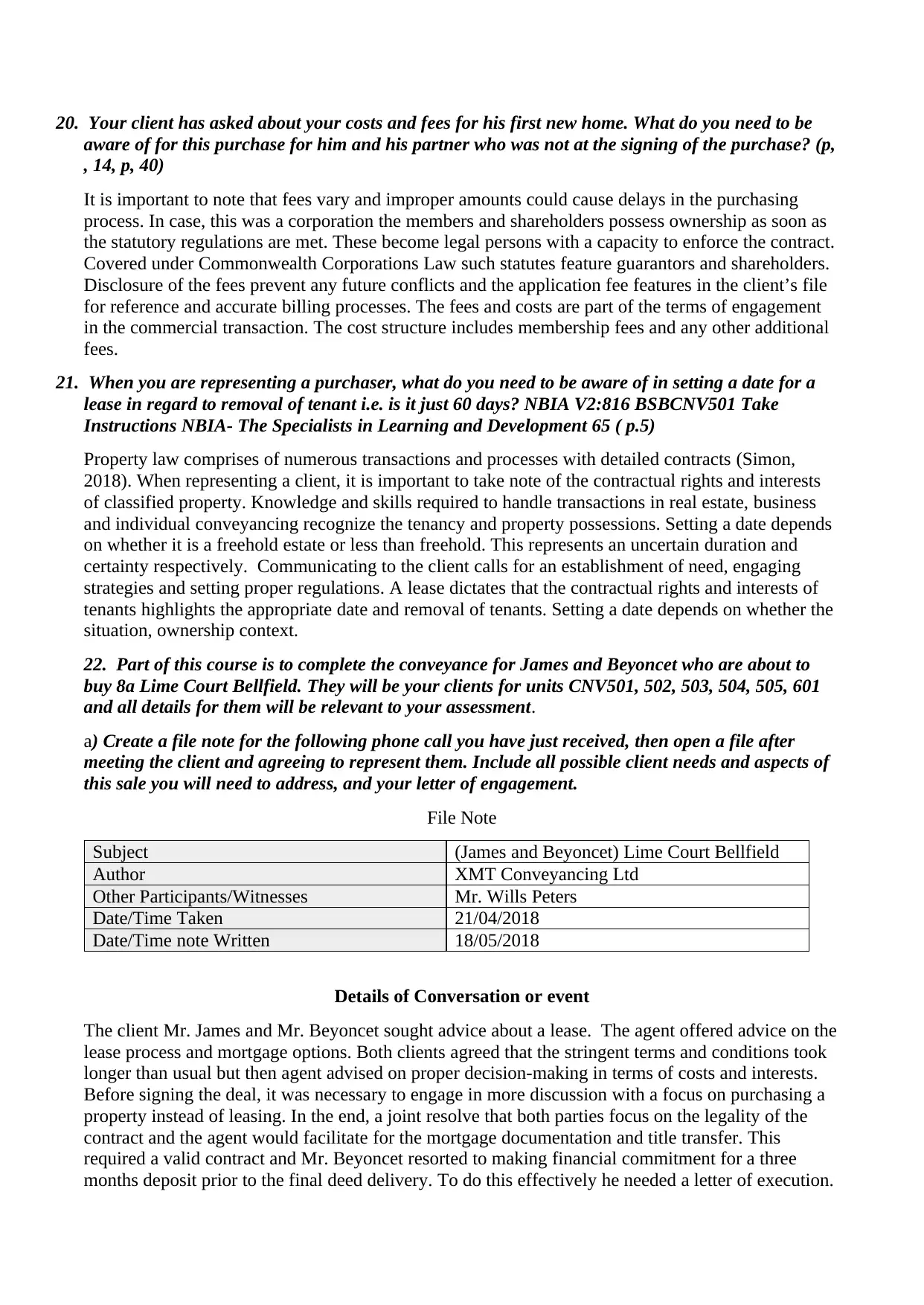
20. Your client has asked about your costs and fees for his first new home. What do you need to be
aware of for this purchase for him and his partner who was not at the signing of the purchase? (p,
, 14, p, 40)
It is important to note that fees vary and improper amounts could cause delays in the purchasing
process. In case, this was a corporation the members and shareholders possess ownership as soon as
the statutory regulations are met. These become legal persons with a capacity to enforce the contract.
Covered under Commonwealth Corporations Law such statutes feature guarantors and shareholders.
Disclosure of the fees prevent any future conflicts and the application fee features in the client’s file
for reference and accurate billing processes. The fees and costs are part of the terms of engagement
in the commercial transaction. The cost structure includes membership fees and any other additional
fees.
21. When you are representing a purchaser, what do you need to be aware of in setting a date for a
lease in regard to removal of tenant i.e. is it just 60 days? NBIA V2:816 BSBCNV501 Take
Instructions NBIA- The Specialists in Learning and Development 65 ( p.5)
Property law comprises of numerous transactions and processes with detailed contracts (Simon,
2018). When representing a client, it is important to take note of the contractual rights and interests
of classified property. Knowledge and skills required to handle transactions in real estate, business
and individual conveyancing recognize the tenancy and property possessions. Setting a date depends
on whether it is a freehold estate or less than freehold. This represents an uncertain duration and
certainty respectively. Communicating to the client calls for an establishment of need, engaging
strategies and setting proper regulations. A lease dictates that the contractual rights and interests of
tenants highlights the appropriate date and removal of tenants. Setting a date depends on whether the
situation, ownership context.
22. Part of this course is to complete the conveyance for James and Beyoncet who are about to
buy 8a Lime Court Bellfield. They will be your clients for units CNV501, 502, 503, 504, 505, 601
and all details for them will be relevant to your assessment.
a) Create a file note for the following phone call you have just received, then open a file after
meeting the client and agreeing to represent them. Include all possible client needs and aspects of
this sale you will need to address, and your letter of engagement.
File Note
Subject (James and Beyoncet) Lime Court Bellfield
Author XMT Conveyancing Ltd
Other Participants/Witnesses Mr. Wills Peters
Date/Time Taken 21/04/2018
Date/Time note Written 18/05/2018
Details of Conversation or event
The client Mr. James and Mr. Beyoncet sought advice about a lease. The agent offered advice on the
lease process and mortgage options. Both clients agreed that the stringent terms and conditions took
longer than usual but then agent advised on proper decision-making in terms of costs and interests.
Before signing the deal, it was necessary to engage in more discussion with a focus on purchasing a
property instead of leasing. In the end, a joint resolve that both parties focus on the legality of the
contract and the agent would facilitate for the mortgage documentation and title transfer. This
required a valid contract and Mr. Beyoncet resorted to making financial commitment for a three
months deposit prior to the final deed delivery. To do this effectively he needed a letter of execution.
aware of for this purchase for him and his partner who was not at the signing of the purchase? (p,
, 14, p, 40)
It is important to note that fees vary and improper amounts could cause delays in the purchasing
process. In case, this was a corporation the members and shareholders possess ownership as soon as
the statutory regulations are met. These become legal persons with a capacity to enforce the contract.
Covered under Commonwealth Corporations Law such statutes feature guarantors and shareholders.
Disclosure of the fees prevent any future conflicts and the application fee features in the client’s file
for reference and accurate billing processes. The fees and costs are part of the terms of engagement
in the commercial transaction. The cost structure includes membership fees and any other additional
fees.
21. When you are representing a purchaser, what do you need to be aware of in setting a date for a
lease in regard to removal of tenant i.e. is it just 60 days? NBIA V2:816 BSBCNV501 Take
Instructions NBIA- The Specialists in Learning and Development 65 ( p.5)
Property law comprises of numerous transactions and processes with detailed contracts (Simon,
2018). When representing a client, it is important to take note of the contractual rights and interests
of classified property. Knowledge and skills required to handle transactions in real estate, business
and individual conveyancing recognize the tenancy and property possessions. Setting a date depends
on whether it is a freehold estate or less than freehold. This represents an uncertain duration and
certainty respectively. Communicating to the client calls for an establishment of need, engaging
strategies and setting proper regulations. A lease dictates that the contractual rights and interests of
tenants highlights the appropriate date and removal of tenants. Setting a date depends on whether the
situation, ownership context.
22. Part of this course is to complete the conveyance for James and Beyoncet who are about to
buy 8a Lime Court Bellfield. They will be your clients for units CNV501, 502, 503, 504, 505, 601
and all details for them will be relevant to your assessment.
a) Create a file note for the following phone call you have just received, then open a file after
meeting the client and agreeing to represent them. Include all possible client needs and aspects of
this sale you will need to address, and your letter of engagement.
File Note
Subject (James and Beyoncet) Lime Court Bellfield
Author XMT Conveyancing Ltd
Other Participants/Witnesses Mr. Wills Peters
Date/Time Taken 21/04/2018
Date/Time note Written 18/05/2018
Details of Conversation or event
The client Mr. James and Mr. Beyoncet sought advice about a lease. The agent offered advice on the
lease process and mortgage options. Both clients agreed that the stringent terms and conditions took
longer than usual but then agent advised on proper decision-making in terms of costs and interests.
Before signing the deal, it was necessary to engage in more discussion with a focus on purchasing a
property instead of leasing. In the end, a joint resolve that both parties focus on the legality of the
contract and the agent would facilitate for the mortgage documentation and title transfer. This
required a valid contract and Mr. Beyoncet resorted to making financial commitment for a three
months deposit prior to the final deed delivery. To do this effectively he needed a letter of execution.
Paraphrase This Document
Need a fresh take? Get an instant paraphrase of this document with our AI Paraphraser
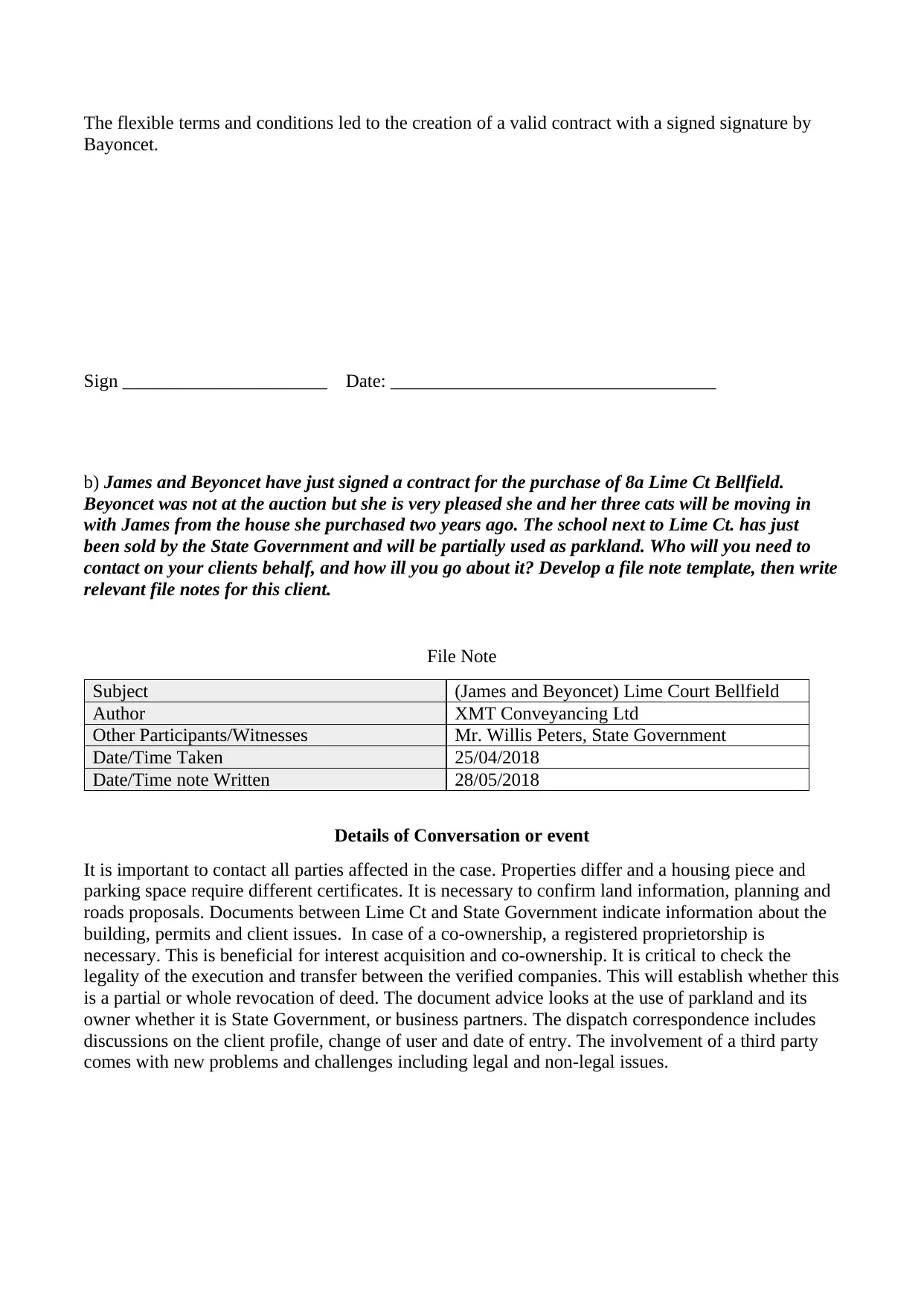
The flexible terms and conditions led to the creation of a valid contract with a signed signature by
Bayoncet.
Sign ______________________ Date: ___________________________________
b) James and Beyoncet have just signed a contract for the purchase of 8a Lime Ct Bellfield.
Beyoncet was not at the auction but she is very pleased she and her three cats will be moving in
with James from the house she purchased two years ago. The school next to Lime Ct. has just
been sold by the State Government and will be partially used as parkland. Who will you need to
contact on your clients behalf, and how ill you go about it? Develop a file note template, then write
relevant file notes for this client.
File Note
Subject (James and Beyoncet) Lime Court Bellfield
Author XMT Conveyancing Ltd
Other Participants/Witnesses Mr. Willis Peters, State Government
Date/Time Taken 25/04/2018
Date/Time note Written 28/05/2018
Details of Conversation or event
It is important to contact all parties affected in the case. Properties differ and a housing piece and
parking space require different certificates. It is necessary to confirm land information, planning and
roads proposals. Documents between Lime Ct and State Government indicate information about the
building, permits and client issues. In case of a co-ownership, a registered proprietorship is
necessary. This is beneficial for interest acquisition and co-ownership. It is critical to check the
legality of the execution and transfer between the verified companies. This will establish whether this
is a partial or whole revocation of deed. The document advice looks at the use of parkland and its
owner whether it is State Government, or business partners. The dispatch correspondence includes
discussions on the client profile, change of user and date of entry. The involvement of a third party
comes with new problems and challenges including legal and non-legal issues.
Bayoncet.
Sign ______________________ Date: ___________________________________
b) James and Beyoncet have just signed a contract for the purchase of 8a Lime Ct Bellfield.
Beyoncet was not at the auction but she is very pleased she and her three cats will be moving in
with James from the house she purchased two years ago. The school next to Lime Ct. has just
been sold by the State Government and will be partially used as parkland. Who will you need to
contact on your clients behalf, and how ill you go about it? Develop a file note template, then write
relevant file notes for this client.
File Note
Subject (James and Beyoncet) Lime Court Bellfield
Author XMT Conveyancing Ltd
Other Participants/Witnesses Mr. Willis Peters, State Government
Date/Time Taken 25/04/2018
Date/Time note Written 28/05/2018
Details of Conversation or event
It is important to contact all parties affected in the case. Properties differ and a housing piece and
parking space require different certificates. It is necessary to confirm land information, planning and
roads proposals. Documents between Lime Ct and State Government indicate information about the
building, permits and client issues. In case of a co-ownership, a registered proprietorship is
necessary. This is beneficial for interest acquisition and co-ownership. It is critical to check the
legality of the execution and transfer between the verified companies. This will establish whether this
is a partial or whole revocation of deed. The document advice looks at the use of parkland and its
owner whether it is State Government, or business partners. The dispatch correspondence includes
discussions on the client profile, change of user and date of entry. The involvement of a third party
comes with new problems and challenges including legal and non-legal issues.
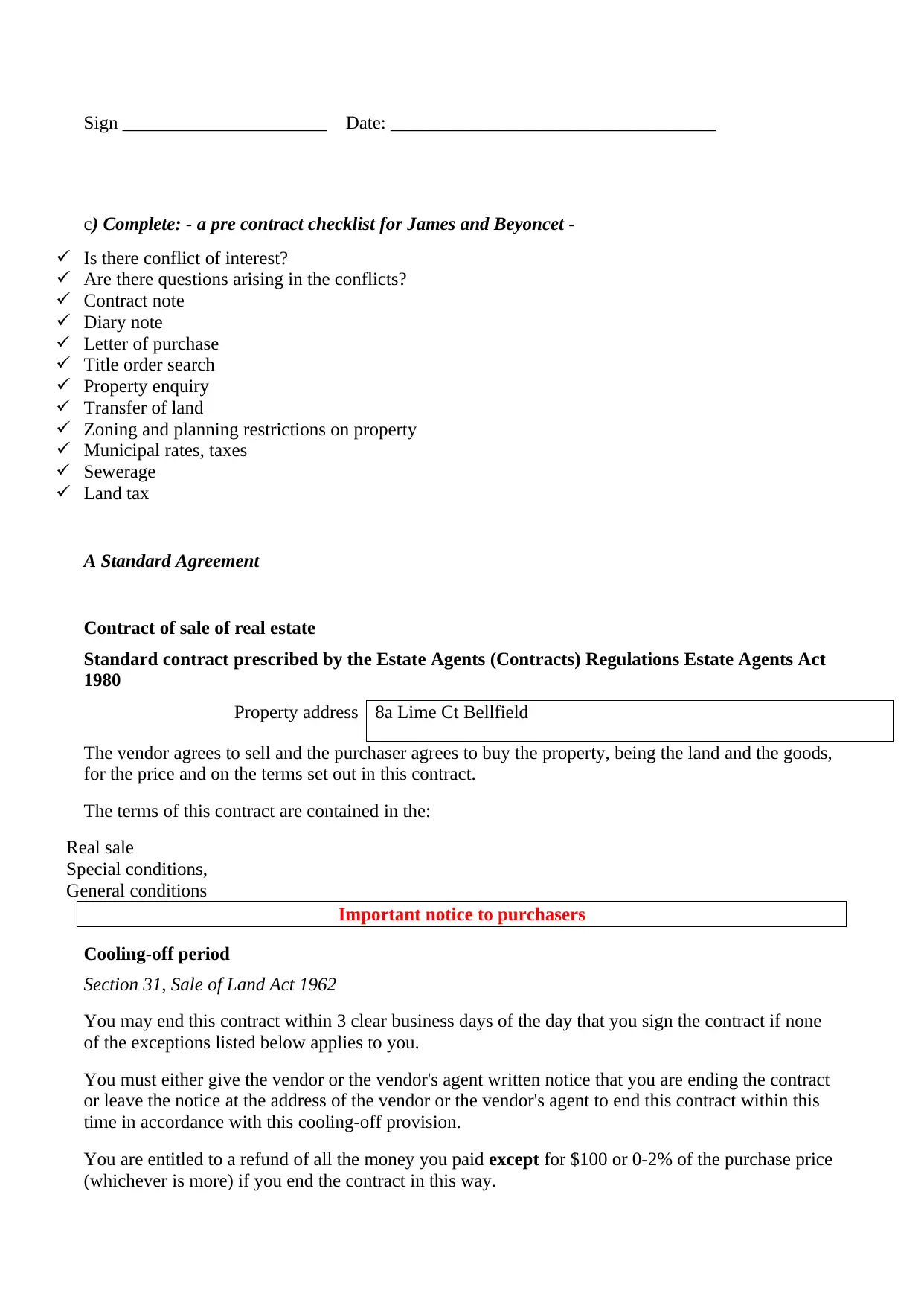
Sign ______________________ Date: ___________________________________
c) Complete: - a pre contract checklist for James and Beyoncet -
Is there conflict of interest?
Are there questions arising in the conflicts?
Contract note
Diary note
Letter of purchase
Title order search
Property enquiry
Transfer of land
Zoning and planning restrictions on property
Municipal rates, taxes
Sewerage
Land tax
A Standard Agreement
Contract of sale of real estate
Standard contract prescribed by the Estate Agents (Contracts) Regulations Estate Agents Act
1980
Property address 8a Lime Ct Bellfield
The vendor agrees to sell and the purchaser agrees to buy the property, being the land and the goods,
for the price and on the terms set out in this contract.
The terms of this contract are contained in the:
Real sale
Special conditions,
General conditions
Important notice to purchasers
Cooling-off period
Section 31, Sale of Land Act 1962
You may end this contract within 3 clear business days of the day that you sign the contract if none
of the exceptions listed below applies to you.
You must either give the vendor or the vendor's agent written notice that you are ending the contract
or leave the notice at the address of the vendor or the vendor's agent to end this contract within this
time in accordance with this cooling-off provision.
You are entitled to a refund of all the money you paid except for $100 or 0-2% of the purchase price
(whichever is more) if you end the contract in this way.
c) Complete: - a pre contract checklist for James and Beyoncet -
Is there conflict of interest?
Are there questions arising in the conflicts?
Contract note
Diary note
Letter of purchase
Title order search
Property enquiry
Transfer of land
Zoning and planning restrictions on property
Municipal rates, taxes
Sewerage
Land tax
A Standard Agreement
Contract of sale of real estate
Standard contract prescribed by the Estate Agents (Contracts) Regulations Estate Agents Act
1980
Property address 8a Lime Ct Bellfield
The vendor agrees to sell and the purchaser agrees to buy the property, being the land and the goods,
for the price and on the terms set out in this contract.
The terms of this contract are contained in the:
Real sale
Special conditions,
General conditions
Important notice to purchasers
Cooling-off period
Section 31, Sale of Land Act 1962
You may end this contract within 3 clear business days of the day that you sign the contract if none
of the exceptions listed below applies to you.
You must either give the vendor or the vendor's agent written notice that you are ending the contract
or leave the notice at the address of the vendor or the vendor's agent to end this contract within this
time in accordance with this cooling-off provision.
You are entitled to a refund of all the money you paid except for $100 or 0-2% of the purchase price
(whichever is more) if you end the contract in this way.
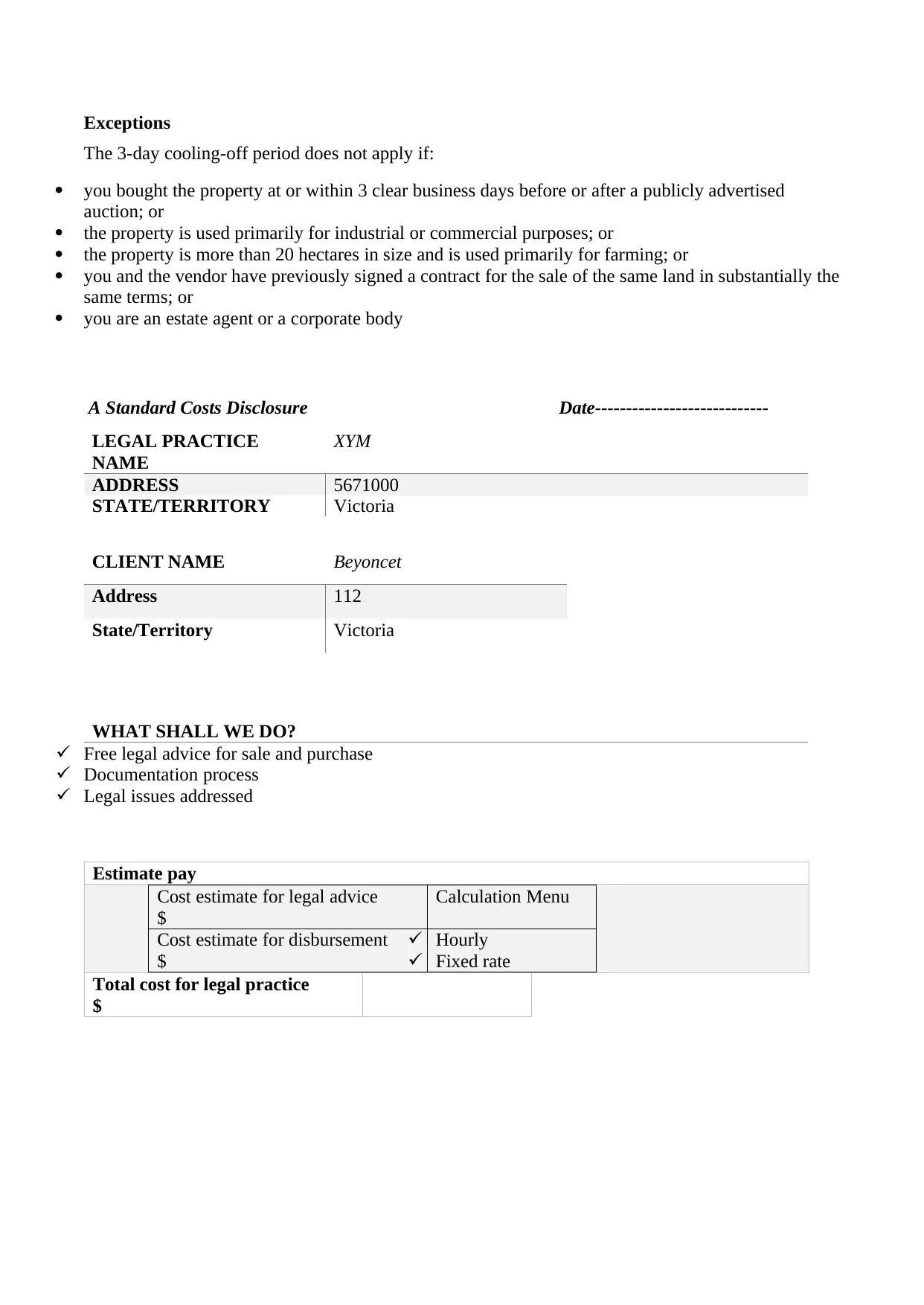
Exceptions
The 3-day cooling-off period does not apply if:
you bought the property at or within 3 clear business days before or after a publicly advertised
auction; or
the property is used primarily for industrial or commercial purposes; or
the property is more than 20 hectares in size and is used primarily for farming; or
you and the vendor have previously signed a contract for the sale of the same land in substantially the
same terms; or
you are an estate agent or a corporate body
A Standard Costs Disclosure Date----------------------------
LEGAL PRACTICE
NAME
XYM
ADDRESS 5671000
STATE/TERRITORY Victoria
CLIENT NAME Beyoncet
Address 112
State/Territory Victoria
WHAT SHALL WE DO?
Free legal advice for sale and purchase
Documentation process
Legal issues addressed
Estimate pay
Cost estimate for legal advice
$
Calculation Menu
Cost estimate for disbursement
$
Hourly
Fixed rate
Total cost for legal practice
$
The 3-day cooling-off period does not apply if:
you bought the property at or within 3 clear business days before or after a publicly advertised
auction; or
the property is used primarily for industrial or commercial purposes; or
the property is more than 20 hectares in size and is used primarily for farming; or
you and the vendor have previously signed a contract for the sale of the same land in substantially the
same terms; or
you are an estate agent or a corporate body
A Standard Costs Disclosure Date----------------------------
LEGAL PRACTICE
NAME
XYM
ADDRESS 5671000
STATE/TERRITORY Victoria
CLIENT NAME Beyoncet
Address 112
State/Territory Victoria
WHAT SHALL WE DO?
Free legal advice for sale and purchase
Documentation process
Legal issues addressed
Estimate pay
Cost estimate for legal advice
$
Calculation Menu
Cost estimate for disbursement
$
Hourly
Fixed rate
Total cost for legal practice
$
Secure Best Marks with AI Grader
Need help grading? Try our AI Grader for instant feedback on your assignments.
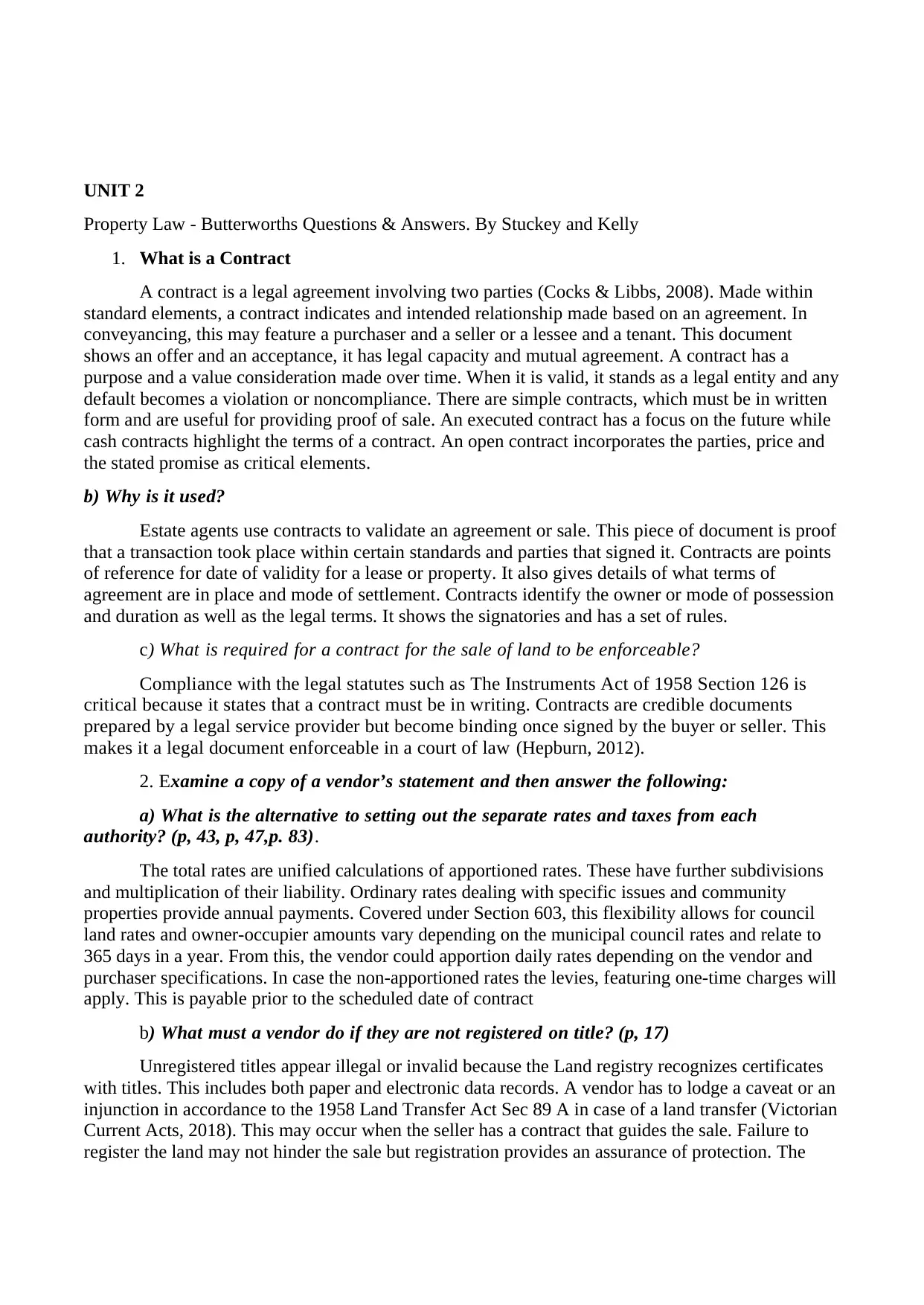
UNIT 2
Property Law - Butterworths Questions & Answers. By Stuckey and Kelly
1. What is a Contract
A contract is a legal agreement involving two parties (Cocks & Libbs, 2008). Made within
standard elements, a contract indicates and intended relationship made based on an agreement. In
conveyancing, this may feature a purchaser and a seller or a lessee and a tenant. This document
shows an offer and an acceptance, it has legal capacity and mutual agreement. A contract has a
purpose and a value consideration made over time. When it is valid, it stands as a legal entity and any
default becomes a violation or noncompliance. There are simple contracts, which must be in written
form and are useful for providing proof of sale. An executed contract has a focus on the future while
cash contracts highlight the terms of a contract. An open contract incorporates the parties, price and
the stated promise as critical elements.
b) Why is it us e d?
Estate agents use contracts to validate an agreement or sale. This piece of document is proof
that a transaction took place within certain standards and parties that signed it. Contracts are points
of reference for date of validity for a lease or property. It also gives details of what terms of
agreement are in place and mode of settlement. Contracts identify the owner or mode of possession
and duration as well as the legal terms. It shows the signatories and has a set of rules.
c) What is required for a contract for the sale of land to be enfor ceabl e?
Compliance with the legal statutes such as The Instruments Act of 1958 Section 126 is
critical because it states that a contract must be in writing. Contracts are credible documents
prepared by a legal service provider but become binding once signed by the buyer or seller. This
makes it a legal document enforceable in a court of law (Hepburn, 2012) .
2. Examine a copy of a vendor’s statement and then answer the fo llo wing :
a) What is the alternative to setting out the separate rates and taxes from each
a uthor it y? (p, 43, p, 47,p. 83).
The total rates are unified calculations of apportioned rates. These have further subdivisions
and multiplication of their liability. Ordinary rates dealing with specific issues and community
properties provide annual payments. Covered under Section 603, this flexibility allows for council
land rates and owner-occupier amounts vary depending on the municipal council rates and relate to
365 days in a year. From this, the vendor could apportion daily rates depending on the vendor and
purchaser specifications. In case the non-apportioned rates the levies, featuring one-time charges will
apply. This is payable prior to the scheduled date of contract
b) What must a vendor do if they are not registered on title? (p, 17)
Unregistered titles appear illegal or invalid because the Land registry recognizes certificates
with titles. This includes both paper and electronic data records. A vendor has to lodge a caveat or an
injunction in accordance to the 1958 Land Transfer Act Sec 89 A in case of a land transfer (Victorian
Current Acts, 2018). This may occur when the seller has a contract that guides the sale. Failure to
register the land may not hinder the sale but registration provides an assurance of protection. The
Property Law - Butterworths Questions & Answers. By Stuckey and Kelly
1. What is a Contract
A contract is a legal agreement involving two parties (Cocks & Libbs, 2008). Made within
standard elements, a contract indicates and intended relationship made based on an agreement. In
conveyancing, this may feature a purchaser and a seller or a lessee and a tenant. This document
shows an offer and an acceptance, it has legal capacity and mutual agreement. A contract has a
purpose and a value consideration made over time. When it is valid, it stands as a legal entity and any
default becomes a violation or noncompliance. There are simple contracts, which must be in written
form and are useful for providing proof of sale. An executed contract has a focus on the future while
cash contracts highlight the terms of a contract. An open contract incorporates the parties, price and
the stated promise as critical elements.
b) Why is it us e d?
Estate agents use contracts to validate an agreement or sale. This piece of document is proof
that a transaction took place within certain standards and parties that signed it. Contracts are points
of reference for date of validity for a lease or property. It also gives details of what terms of
agreement are in place and mode of settlement. Contracts identify the owner or mode of possession
and duration as well as the legal terms. It shows the signatories and has a set of rules.
c) What is required for a contract for the sale of land to be enfor ceabl e?
Compliance with the legal statutes such as The Instruments Act of 1958 Section 126 is
critical because it states that a contract must be in writing. Contracts are credible documents
prepared by a legal service provider but become binding once signed by the buyer or seller. This
makes it a legal document enforceable in a court of law (Hepburn, 2012) .
2. Examine a copy of a vendor’s statement and then answer the fo llo wing :
a) What is the alternative to setting out the separate rates and taxes from each
a uthor it y? (p, 43, p, 47,p. 83).
The total rates are unified calculations of apportioned rates. These have further subdivisions
and multiplication of their liability. Ordinary rates dealing with specific issues and community
properties provide annual payments. Covered under Section 603, this flexibility allows for council
land rates and owner-occupier amounts vary depending on the municipal council rates and relate to
365 days in a year. From this, the vendor could apportion daily rates depending on the vendor and
purchaser specifications. In case the non-apportioned rates the levies, featuring one-time charges will
apply. This is payable prior to the scheduled date of contract
b) What must a vendor do if they are not registered on title? (p, 17)
Unregistered titles appear illegal or invalid because the Land registry recognizes certificates
with titles. This includes both paper and electronic data records. A vendor has to lodge a caveat or an
injunction in accordance to the 1958 Land Transfer Act Sec 89 A in case of a land transfer (Victorian
Current Acts, 2018). This may occur when the seller has a contract that guides the sale. Failure to
register the land may not hinder the sale but registration provides an assurance of protection. The
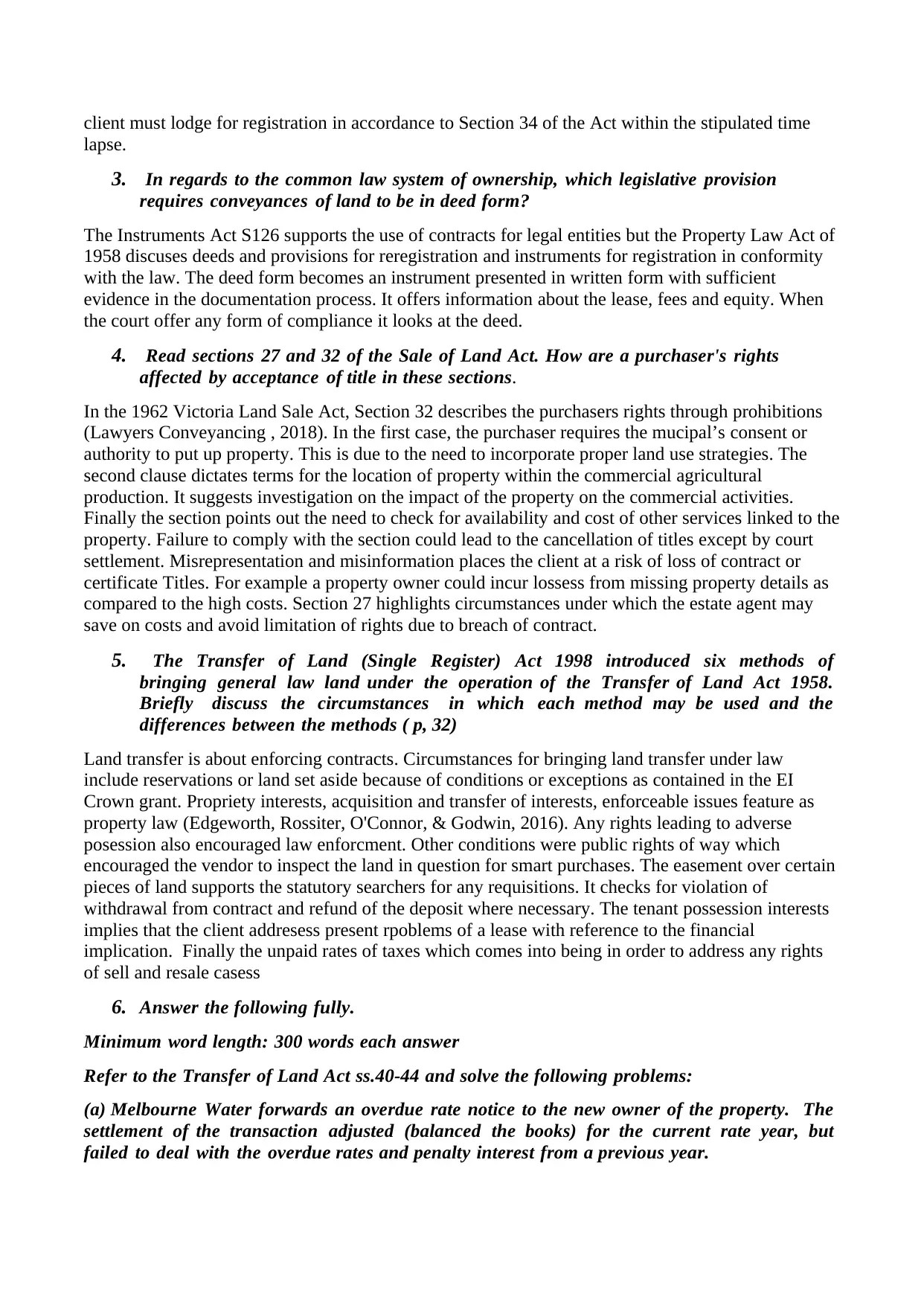
client must lodge for registration in accordance to Section 34 of the Act within the stipulated time
lapse.
3. In regards to the common law system of ownership, which legislative provision
requires conveyances of land to be in deed form ?
The Instruments Act S126 supports the use of contracts for legal entities but the Property Law Act of
1958 discuses deeds and provisions for reregistration and instruments for registration in conformity
with the law. The deed form becomes an instrument presented in written form with sufficient
evidence in the documentation process. It offers information about the lease, fees and equity. When
the court offer any form of compliance it looks at the deed.
4. Read sections 27 and 32 of the Sale of Land Act. How are a purchaser's rights
affected by acceptance of title in these s ectio ns.
In the 1962 Victoria Land Sale Act, Section 32 describes the purchasers rights through prohibitions
(Lawyers Conveyancing , 2018). In the first case, the purchaser requires the mucipal’s consent or
authority to put up property. This is due to the need to incorporate proper land use strategies. The
second clause dictates terms for the location of property within the commercial agricultural
production. It suggests investigation on the impact of the property on the commercial activities.
Finally the section points out the need to check for availability and cost of other services linked to the
property. Failure to comply with the section could lead to the cancellation of titles except by court
settlement. Misrepresentation and misinformation places the client at a risk of loss of contract or
certificate Titles. For example a property owner could incur lossess from missing property details as
compared to the high costs. Section 27 highlights circumstances under which the estate agent may
save on costs and avoid limitation of rights due to breach of contract.
5. The Transfer of Land (Single Register) Act 1998 introduced six methods of
bringing general law la nd under the operation of the Transfer of Land Act 1958.
Briefly discuss the circumstances in which eac h method may be used and the
differences between the m e thods ( p, 32)
Land transfer is about enforcing contracts. Circumstances for bringing land transfer under law
include reservations or land set aside because of conditions or exceptions as contained in the EI
Crown grant. Propriety interests, acquisition and transfer of interests, enforceable issues feature as
property law (Edgeworth, Rossiter, O'Connor, & Godwin, 2016). Any rights leading to adverse
posession also encouraged law enforcment. Other conditions were public rights of way which
encouraged the vendor to inspect the land in question for smart purchases. The easement over certain
pieces of land supports the statutory searchers for any requisitions. It checks for violation of
withdrawal from contract and refund of the deposit where necessary. The tenant possession interests
implies that the client addresess present rpoblems of a lease with reference to the financial
implication. Finally the unpaid rates of taxes which comes into being in order to address any rights
of sell and resale casess
6. Answer the following ful l y.
Minimum word length: 300 words each answ er
Refer to the Transfer of Land Act ss.40-44 and solve the following probl e ms :
(a) Melbourne Water forwards an overdue rate notice to the new owner of the property. The
settlement of the transaction adjusted (balanced the books) for the current rate year, but
failed to deal with the ov e rdu e rates and penalty interest from a previous y ea r.
lapse.
3. In regards to the common law system of ownership, which legislative provision
requires conveyances of land to be in deed form ?
The Instruments Act S126 supports the use of contracts for legal entities but the Property Law Act of
1958 discuses deeds and provisions for reregistration and instruments for registration in conformity
with the law. The deed form becomes an instrument presented in written form with sufficient
evidence in the documentation process. It offers information about the lease, fees and equity. When
the court offer any form of compliance it looks at the deed.
4. Read sections 27 and 32 of the Sale of Land Act. How are a purchaser's rights
affected by acceptance of title in these s ectio ns.
In the 1962 Victoria Land Sale Act, Section 32 describes the purchasers rights through prohibitions
(Lawyers Conveyancing , 2018). In the first case, the purchaser requires the mucipal’s consent or
authority to put up property. This is due to the need to incorporate proper land use strategies. The
second clause dictates terms for the location of property within the commercial agricultural
production. It suggests investigation on the impact of the property on the commercial activities.
Finally the section points out the need to check for availability and cost of other services linked to the
property. Failure to comply with the section could lead to the cancellation of titles except by court
settlement. Misrepresentation and misinformation places the client at a risk of loss of contract or
certificate Titles. For example a property owner could incur lossess from missing property details as
compared to the high costs. Section 27 highlights circumstances under which the estate agent may
save on costs and avoid limitation of rights due to breach of contract.
5. The Transfer of Land (Single Register) Act 1998 introduced six methods of
bringing general law la nd under the operation of the Transfer of Land Act 1958.
Briefly discuss the circumstances in which eac h method may be used and the
differences between the m e thods ( p, 32)
Land transfer is about enforcing contracts. Circumstances for bringing land transfer under law
include reservations or land set aside because of conditions or exceptions as contained in the EI
Crown grant. Propriety interests, acquisition and transfer of interests, enforceable issues feature as
property law (Edgeworth, Rossiter, O'Connor, & Godwin, 2016). Any rights leading to adverse
posession also encouraged law enforcment. Other conditions were public rights of way which
encouraged the vendor to inspect the land in question for smart purchases. The easement over certain
pieces of land supports the statutory searchers for any requisitions. It checks for violation of
withdrawal from contract and refund of the deposit where necessary. The tenant possession interests
implies that the client addresess present rpoblems of a lease with reference to the financial
implication. Finally the unpaid rates of taxes which comes into being in order to address any rights
of sell and resale casess
6. Answer the following ful l y.
Minimum word length: 300 words each answ er
Refer to the Transfer of Land Act ss.40-44 and solve the following probl e ms :
(a) Melbourne Water forwards an overdue rate notice to the new owner of the property. The
settlement of the transaction adjusted (balanced the books) for the current rate year, but
failed to deal with the ov e rdu e rates and penalty interest from a previous y ea r.
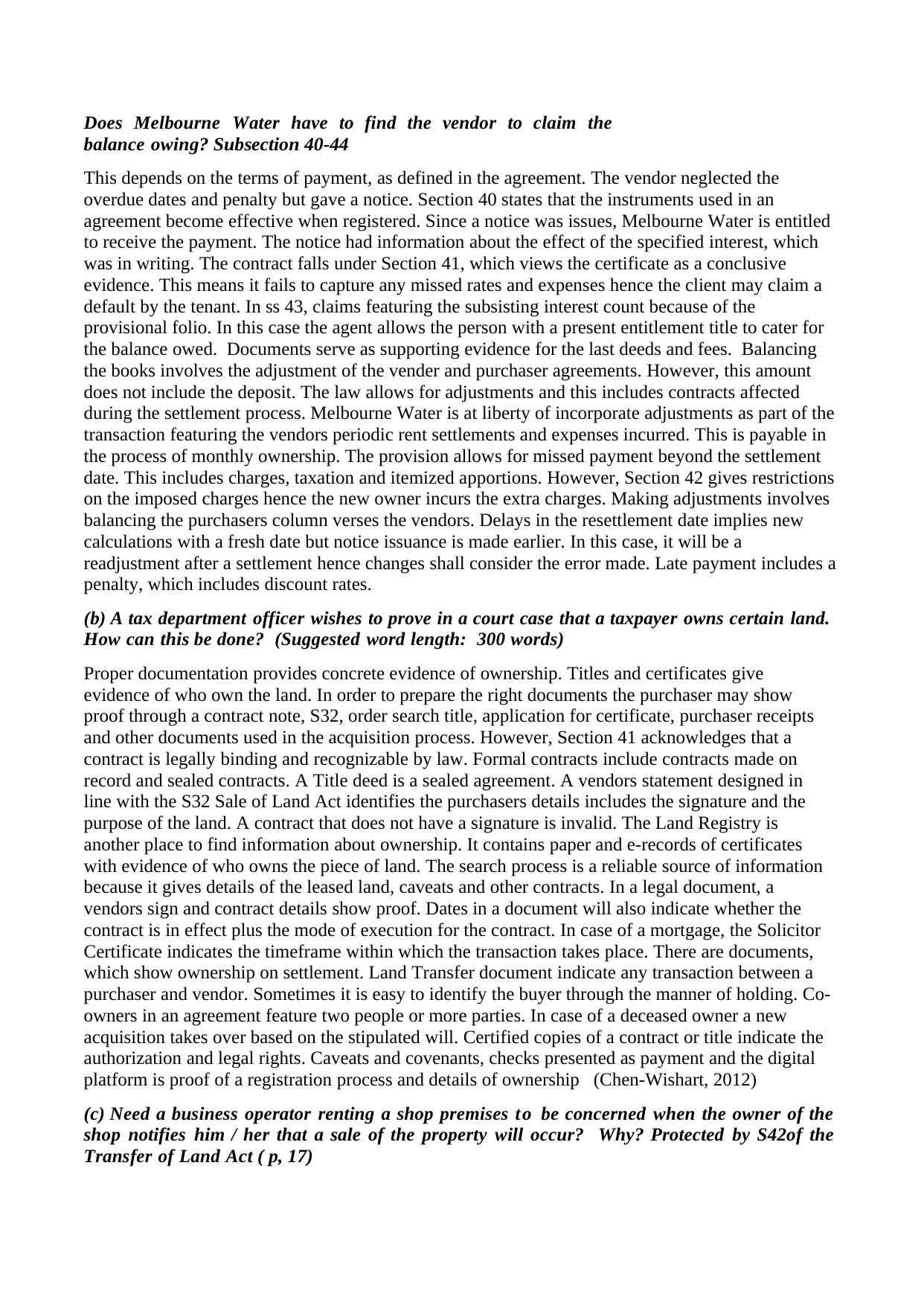
Does Melbourne Water have to find the vendor to claim the
balance owing ? Subsection 40-44
This depends on the terms of payment, as defined in the agreement. The vendor neglected the
overdue dates and penalty but gave a notice. Section 40 states that the instruments used in an
agreement become effective when registered. Since a notice was issues, Melbourne Water is entitled
to receive the payment. The notice had information about the effect of the specified interest, which
was in writing. The contract falls under Section 41, which views the certificate as a conclusive
evidence. This means it fails to capture any missed rates and expenses hence the client may claim a
default by the tenant. In ss 43, claims featuring the subsisting interest count because of the
provisional folio. In this case the agent allows the person with a present entitlement title to cater for
the balance owed. Documents serve as supporting evidence for the last deeds and fees. Balancing
the books involves the adjustment of the vender and purchaser agreements. However, this amount
does not include the deposit. The law allows for adjustments and this includes contracts affected
during the settlement process. Melbourne Water is at liberty of incorporate adjustments as part of the
transaction featuring the vendors periodic rent settlements and expenses incurred. This is payable in
the process of monthly ownership. The provision allows for missed payment beyond the settlement
date. This includes charges, taxation and itemized apportions. However, Section 42 gives restrictions
on the imposed charges hence the new owner incurs the extra charges. Making adjustments involves
balancing the purchasers column verses the vendors. Delays in the resettlement date implies new
calculations with a fresh date but notice issuance is made earlier. In this case, it will be a
readjustment after a settlement hence changes shall consider the error made. Late payment includes a
penalty, which includes discount rates.
(b) A tax department officer wishes to prove in a court case that a taxpayer owns certain land.
How can t h i s be done? (Suggested word length: 300 words)
Proper documentation provides concrete evidence of ownership. Titles and certificates give
evidence of who own the land. In order to prepare the right documents the purchaser may show
proof through a contract note, S32, order search title, application for certificate, purchaser receipts
and other documents used in the acquisition process. However, Section 41 acknowledges that a
contract is legally binding and recognizable by law. Formal contracts include contracts made on
record and sealed contracts. A Title deed is a sealed agreement. A vendors statement designed in
line with the S32 Sale of Land Act identifies the purchasers details includes the signature and the
purpose of the land. A contract that does not have a signature is invalid. The Land Registry is
another place to find information about ownership. It contains paper and e-records of certificates
with evidence of who owns the piece of land. The search process is a reliable source of information
because it gives details of the leased land, caveats and other contracts. In a legal document, a
vendors sign and contract details show proof. Dates in a document will also indicate whether the
contract is in effect plus the mode of execution for the contract. In case of a mortgage, the Solicitor
Certificate indicates the timeframe within which the transaction takes place. There are documents,
which show ownership on settlement. Land Transfer document indicate any transaction between a
purchaser and vendor. Sometimes it is easy to identify the buyer through the manner of holding. Co-
owners in an agreement feature two people or more parties. In case of a deceased owner a new
acquisition takes over based on the stipulated will. Certified copies of a contract or title indicate the
authorization and legal rights. Caveats and covenants, checks presented as payment and the digital
platform is proof of a registration process and details of ownership (Chen-Wishart, 2012)
(c) Need a business operator renting a shop premises t o be concerned when the owner of the
shop notifies h i m / her that a sale of the property will occur? Why ? Protected by S42of the
Transfer of Land A ct ( p, 17)
balance owing ? Subsection 40-44
This depends on the terms of payment, as defined in the agreement. The vendor neglected the
overdue dates and penalty but gave a notice. Section 40 states that the instruments used in an
agreement become effective when registered. Since a notice was issues, Melbourne Water is entitled
to receive the payment. The notice had information about the effect of the specified interest, which
was in writing. The contract falls under Section 41, which views the certificate as a conclusive
evidence. This means it fails to capture any missed rates and expenses hence the client may claim a
default by the tenant. In ss 43, claims featuring the subsisting interest count because of the
provisional folio. In this case the agent allows the person with a present entitlement title to cater for
the balance owed. Documents serve as supporting evidence for the last deeds and fees. Balancing
the books involves the adjustment of the vender and purchaser agreements. However, this amount
does not include the deposit. The law allows for adjustments and this includes contracts affected
during the settlement process. Melbourne Water is at liberty of incorporate adjustments as part of the
transaction featuring the vendors periodic rent settlements and expenses incurred. This is payable in
the process of monthly ownership. The provision allows for missed payment beyond the settlement
date. This includes charges, taxation and itemized apportions. However, Section 42 gives restrictions
on the imposed charges hence the new owner incurs the extra charges. Making adjustments involves
balancing the purchasers column verses the vendors. Delays in the resettlement date implies new
calculations with a fresh date but notice issuance is made earlier. In this case, it will be a
readjustment after a settlement hence changes shall consider the error made. Late payment includes a
penalty, which includes discount rates.
(b) A tax department officer wishes to prove in a court case that a taxpayer owns certain land.
How can t h i s be done? (Suggested word length: 300 words)
Proper documentation provides concrete evidence of ownership. Titles and certificates give
evidence of who own the land. In order to prepare the right documents the purchaser may show
proof through a contract note, S32, order search title, application for certificate, purchaser receipts
and other documents used in the acquisition process. However, Section 41 acknowledges that a
contract is legally binding and recognizable by law. Formal contracts include contracts made on
record and sealed contracts. A Title deed is a sealed agreement. A vendors statement designed in
line with the S32 Sale of Land Act identifies the purchasers details includes the signature and the
purpose of the land. A contract that does not have a signature is invalid. The Land Registry is
another place to find information about ownership. It contains paper and e-records of certificates
with evidence of who owns the piece of land. The search process is a reliable source of information
because it gives details of the leased land, caveats and other contracts. In a legal document, a
vendors sign and contract details show proof. Dates in a document will also indicate whether the
contract is in effect plus the mode of execution for the contract. In case of a mortgage, the Solicitor
Certificate indicates the timeframe within which the transaction takes place. There are documents,
which show ownership on settlement. Land Transfer document indicate any transaction between a
purchaser and vendor. Sometimes it is easy to identify the buyer through the manner of holding. Co-
owners in an agreement feature two people or more parties. In case of a deceased owner a new
acquisition takes over based on the stipulated will. Certified copies of a contract or title indicate the
authorization and legal rights. Caveats and covenants, checks presented as payment and the digital
platform is proof of a registration process and details of ownership (Chen-Wishart, 2012)
(c) Need a business operator renting a shop premises t o be concerned when the owner of the
shop notifies h i m / her that a sale of the property will occur? Why ? Protected by S42of the
Transfer of Land A ct ( p, 17)
Paraphrase This Document
Need a fresh take? Get an instant paraphrase of this document with our AI Paraphraser
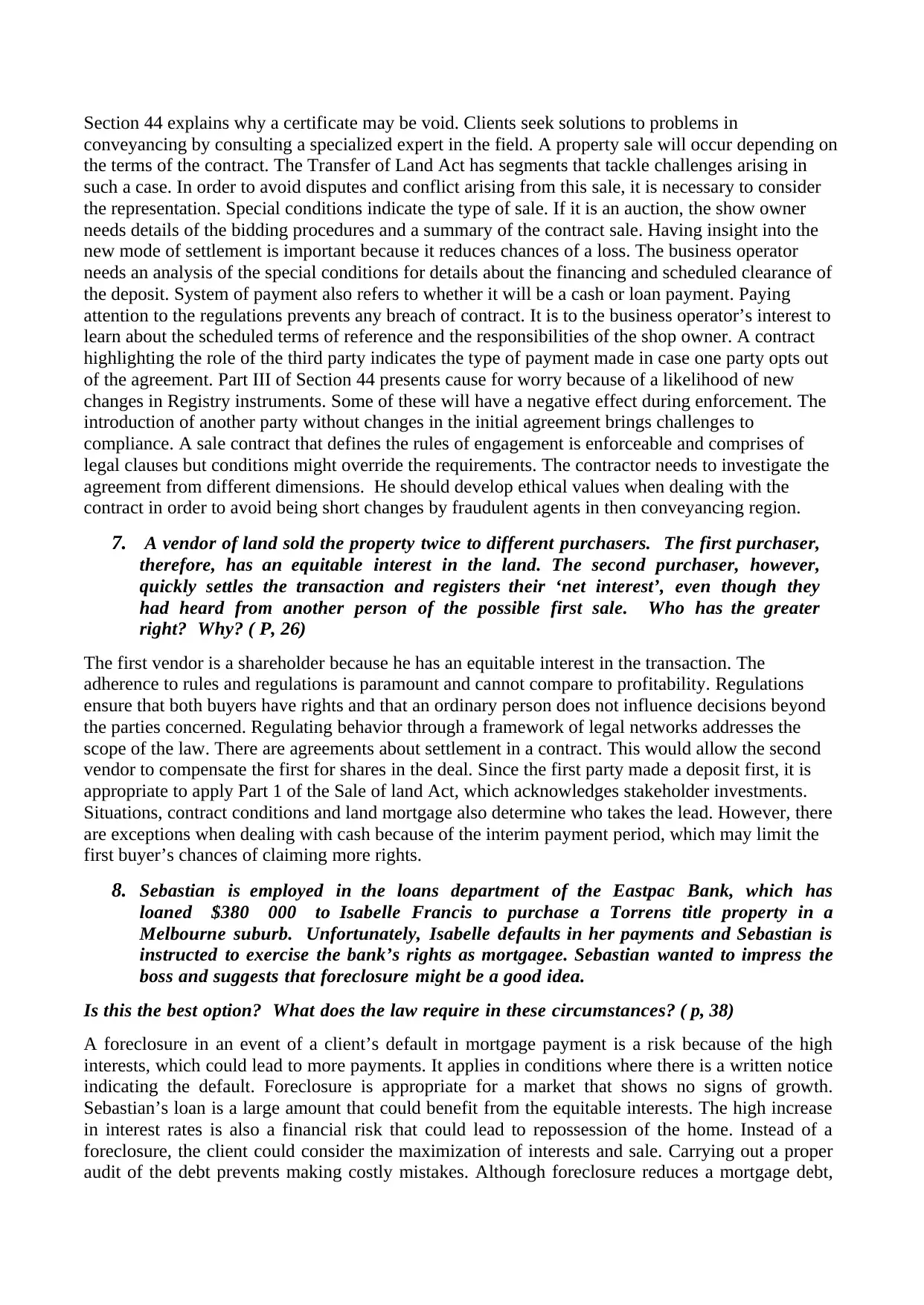
Section 44 explains why a certificate may be void. Clients seek solutions to problems in
conveyancing by consulting a specialized expert in the field. A property sale will occur depending on
the terms of the contract. The Transfer of Land Act has segments that tackle challenges arising in
such a case. In order to avoid disputes and conflict arising from this sale, it is necessary to consider
the representation. Special conditions indicate the type of sale. If it is an auction, the show owner
needs details of the bidding procedures and a summary of the contract sale. Having insight into the
new mode of settlement is important because it reduces chances of a loss. The business operator
needs an analysis of the special conditions for details about the financing and scheduled clearance of
the deposit. System of payment also refers to whether it will be a cash or loan payment. Paying
attention to the regulations prevents any breach of contract. It is to the business operator’s interest to
learn about the scheduled terms of reference and the responsibilities of the shop owner. A contract
highlighting the role of the third party indicates the type of payment made in case one party opts out
of the agreement. Part III of Section 44 presents cause for worry because of a likelihood of new
changes in Registry instruments. Some of these will have a negative effect during enforcement. The
introduction of another party without changes in the initial agreement brings challenges to
compliance. A sale contract that defines the rules of engagement is enforceable and comprises of
legal clauses but conditions might override the requirements. The contractor needs to investigate the
agreement from different dimensions. He should develop ethical values when dealing with the
contract in order to avoid being short changes by fraudulent agents in then conveyancing region.
7. A vendor of land sold the property twice to different purchasers. The first purchaser,
therefore, has a n equitable interest in the land. The second purchaser, however,
quickly settles the transaction and r e g iste rs their ‘net interest’, even though they
had heard from another person of the possible first sale. Who h a s the greater
right? Why ? ( P, 26)
The first vendor is a shareholder because he has an equitable interest in the transaction. The
adherence to rules and regulations is paramount and cannot compare to profitability. Regulations
ensure that both buyers have rights and that an ordinary person does not influence decisions beyond
the parties concerned. Regulating behavior through a framework of legal networks addresses the
scope of the law. There are agreements about settlement in a contract. This would allow the second
vendor to compensate the first for shares in the deal. Since the first party made a deposit first, it is
appropriate to apply Part 1 of the Sale of land Act, which acknowledges stakeholder investments.
Situations, contract conditions and land mortgage also determine who takes the lead. However, there
are exceptions when dealing with cash because of the interim payment period, which may limit the
first buyer’s chances of claiming more rights.
8. Sebastian is employed in the loans department of the Eastpac Bank, which has
loaned $380 000 t o Isabelle Francis to purchase a Torrens title property in a
Melbourne suburb. Unfortunately, Isabelle def a ul t s in her payments and Sebastian is
instructed to exercise the bank’s rights as mortgagee. Sebastian wanted t o impress the
boss and suggests that foreclosure might be a good i de a .
Is this the best option? What does the law require in these ci rcums ta n ce s ? ( p, 38)
A foreclosure in an event of a client’s default in mortgage payment is a risk because of the high
interests, which could lead to more payments. It applies in conditions where there is a written notice
indicating the default. Foreclosure is appropriate for a market that shows no signs of growth.
Sebastian’s loan is a large amount that could benefit from the equitable interests. The high increase
in interest rates is also a financial risk that could lead to repossession of the home. Instead of a
foreclosure, the client could consider the maximization of interests and sale. Carrying out a proper
audit of the debt prevents making costly mistakes. Although foreclosure reduces a mortgage debt,
conveyancing by consulting a specialized expert in the field. A property sale will occur depending on
the terms of the contract. The Transfer of Land Act has segments that tackle challenges arising in
such a case. In order to avoid disputes and conflict arising from this sale, it is necessary to consider
the representation. Special conditions indicate the type of sale. If it is an auction, the show owner
needs details of the bidding procedures and a summary of the contract sale. Having insight into the
new mode of settlement is important because it reduces chances of a loss. The business operator
needs an analysis of the special conditions for details about the financing and scheduled clearance of
the deposit. System of payment also refers to whether it will be a cash or loan payment. Paying
attention to the regulations prevents any breach of contract. It is to the business operator’s interest to
learn about the scheduled terms of reference and the responsibilities of the shop owner. A contract
highlighting the role of the third party indicates the type of payment made in case one party opts out
of the agreement. Part III of Section 44 presents cause for worry because of a likelihood of new
changes in Registry instruments. Some of these will have a negative effect during enforcement. The
introduction of another party without changes in the initial agreement brings challenges to
compliance. A sale contract that defines the rules of engagement is enforceable and comprises of
legal clauses but conditions might override the requirements. The contractor needs to investigate the
agreement from different dimensions. He should develop ethical values when dealing with the
contract in order to avoid being short changes by fraudulent agents in then conveyancing region.
7. A vendor of land sold the property twice to different purchasers. The first purchaser,
therefore, has a n equitable interest in the land. The second purchaser, however,
quickly settles the transaction and r e g iste rs their ‘net interest’, even though they
had heard from another person of the possible first sale. Who h a s the greater
right? Why ? ( P, 26)
The first vendor is a shareholder because he has an equitable interest in the transaction. The
adherence to rules and regulations is paramount and cannot compare to profitability. Regulations
ensure that both buyers have rights and that an ordinary person does not influence decisions beyond
the parties concerned. Regulating behavior through a framework of legal networks addresses the
scope of the law. There are agreements about settlement in a contract. This would allow the second
vendor to compensate the first for shares in the deal. Since the first party made a deposit first, it is
appropriate to apply Part 1 of the Sale of land Act, which acknowledges stakeholder investments.
Situations, contract conditions and land mortgage also determine who takes the lead. However, there
are exceptions when dealing with cash because of the interim payment period, which may limit the
first buyer’s chances of claiming more rights.
8. Sebastian is employed in the loans department of the Eastpac Bank, which has
loaned $380 000 t o Isabelle Francis to purchase a Torrens title property in a
Melbourne suburb. Unfortunately, Isabelle def a ul t s in her payments and Sebastian is
instructed to exercise the bank’s rights as mortgagee. Sebastian wanted t o impress the
boss and suggests that foreclosure might be a good i de a .
Is this the best option? What does the law require in these ci rcums ta n ce s ? ( p, 38)
A foreclosure in an event of a client’s default in mortgage payment is a risk because of the high
interests, which could lead to more payments. It applies in conditions where there is a written notice
indicating the default. Foreclosure is appropriate for a market that shows no signs of growth.
Sebastian’s loan is a large amount that could benefit from the equitable interests. The high increase
in interest rates is also a financial risk that could lead to repossession of the home. Instead of a
foreclosure, the client could consider the maximization of interests and sale. Carrying out a proper
audit of the debt prevents making costly mistakes. Although foreclosure reduces a mortgage debt,
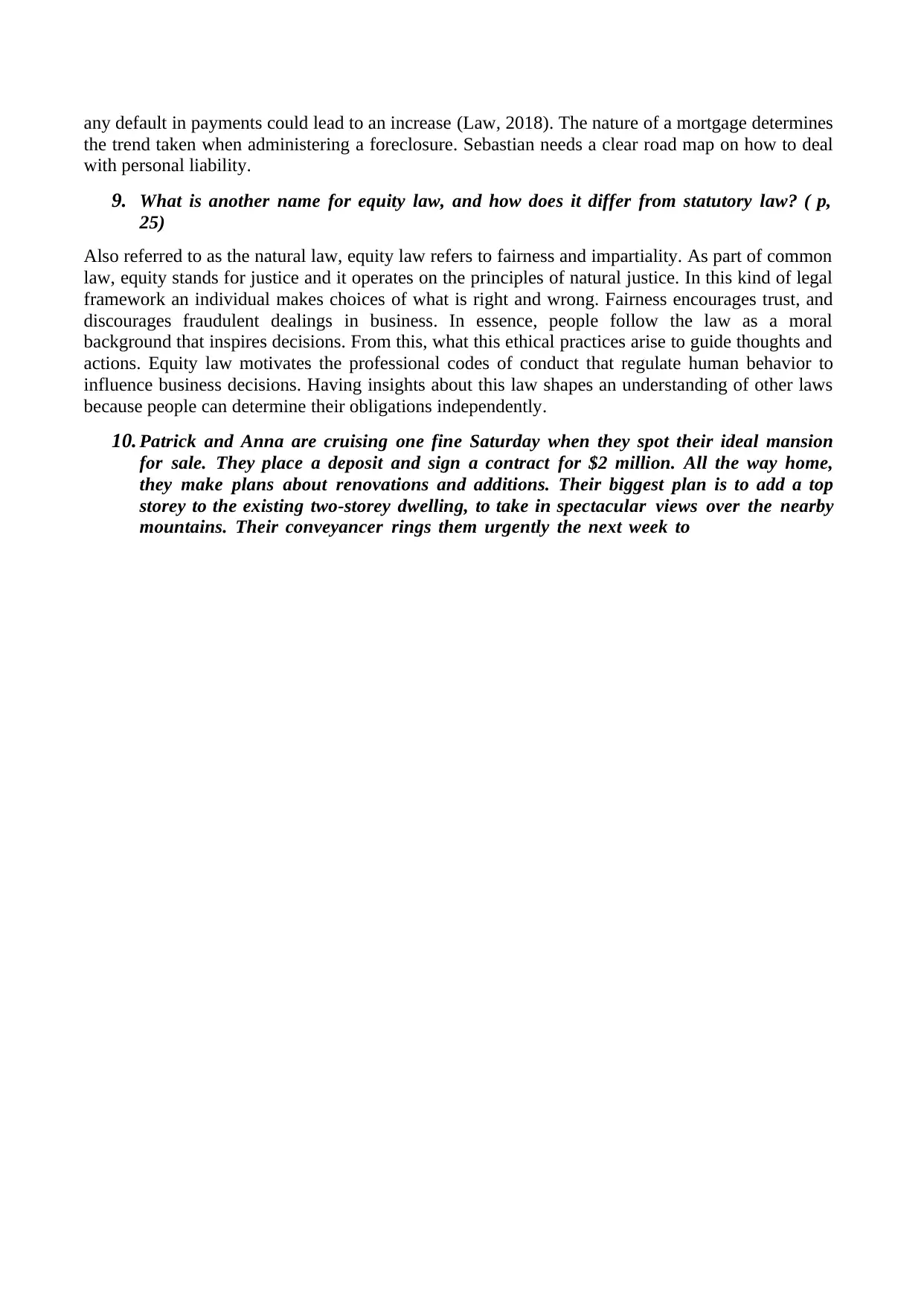
any default in payments could lead to an increase (Law, 2018). The nature of a mortgage determines
the trend taken when administering a foreclosure. Sebastian needs a clear road map on how to deal
with personal liability.
9. What is another name for equity law, and how does it differ from statutory la w ? ( p,
25)
Also referred to as the natural law, equity law refers to fairness and impartiality. As part of common
law, equity stands for justice and it operates on the principles of natural justice. In this kind of legal
framework an individual makes choices of what is right and wrong. Fairness encourages trust, and
discourages fraudulent dealings in business. In essence, people follow the law as a moral
background that inspires decisions. From this, what this ethical practices arise to guide thoughts and
actions. Equity law motivates the professional codes of conduct that regulate human behavior to
influence business decisions. Having insights about this law shapes an understanding of other laws
because people can determine their obligations independently.
10. Patrick and Anna are cruising one fine Saturday when they spot their ideal mansion
for sale. They place a deposit and sign a contract for $2 million. All the way home,
they make plans about r e nova ti ons and additions. Their biggest plan is to add a top
storey to the existing two-storey dwelling, to take i n spectacular views over the nearby
mountains. Their conveyancer rings them urgently the next week t o
the trend taken when administering a foreclosure. Sebastian needs a clear road map on how to deal
with personal liability.
9. What is another name for equity law, and how does it differ from statutory la w ? ( p,
25)
Also referred to as the natural law, equity law refers to fairness and impartiality. As part of common
law, equity stands for justice and it operates on the principles of natural justice. In this kind of legal
framework an individual makes choices of what is right and wrong. Fairness encourages trust, and
discourages fraudulent dealings in business. In essence, people follow the law as a moral
background that inspires decisions. From this, what this ethical practices arise to guide thoughts and
actions. Equity law motivates the professional codes of conduct that regulate human behavior to
influence business decisions. Having insights about this law shapes an understanding of other laws
because people can determine their obligations independently.
10. Patrick and Anna are cruising one fine Saturday when they spot their ideal mansion
for sale. They place a deposit and sign a contract for $2 million. All the way home,
they make plans about r e nova ti ons and additions. Their biggest plan is to add a top
storey to the existing two-storey dwelling, to take i n spectacular views over the nearby
mountains. Their conveyancer rings them urgently the next week t o
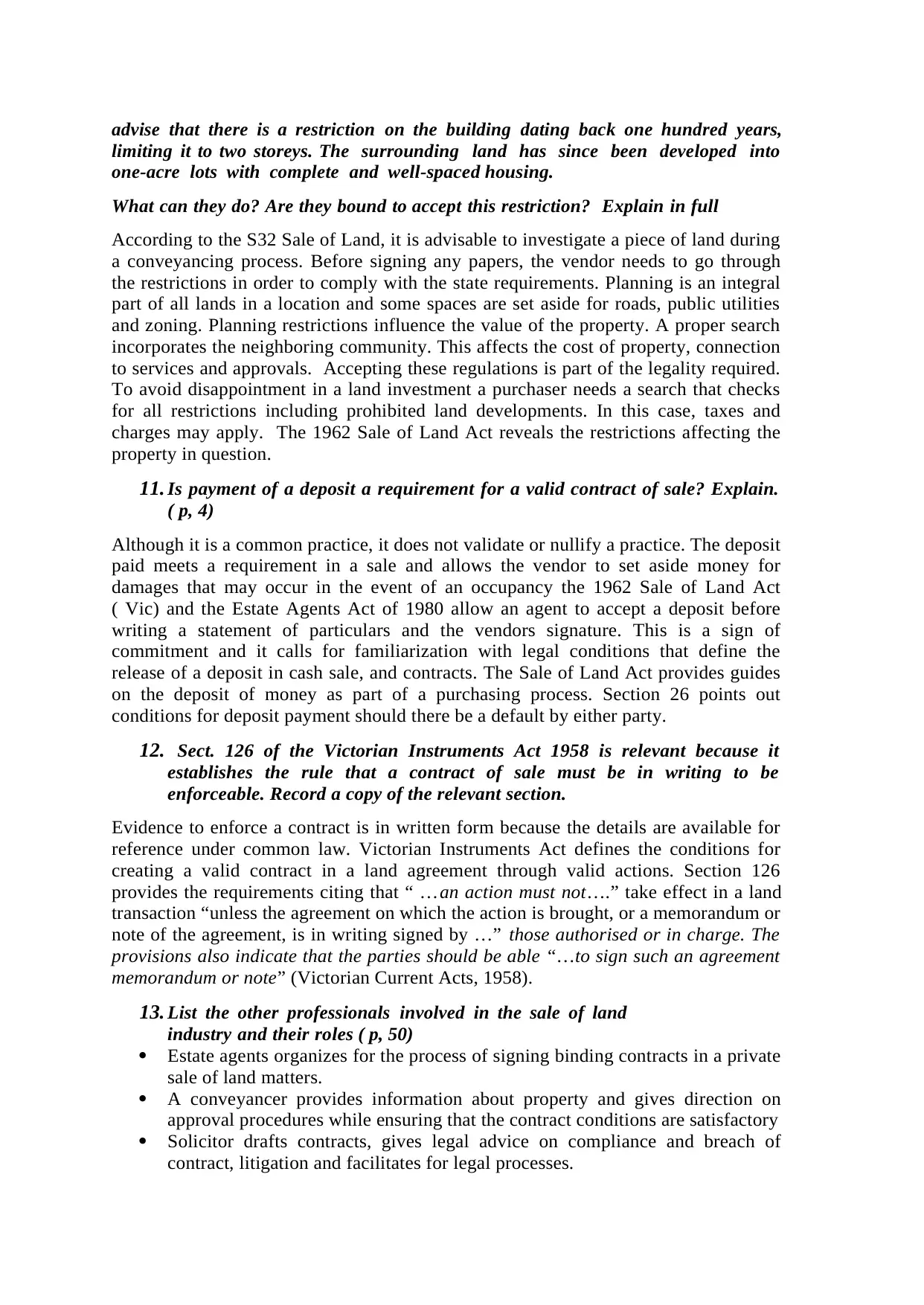
advise that there is a restriction on the building dating back one hundred years,
limiting it to two s t oreys. The surrounding land has since been developed into
one-acre lots with complete and w ell -sp ace d hous i ng.
What can they do? Are they bound to accept this restriction? Explain in full
According to the S32 Sale of Land, it is advisable to investigate a piece of land during
a conveyancing process. Before signing any papers, the vendor needs to go through
the restrictions in order to comply with the state requirements. Planning is an integral
part of all lands in a location and some spaces are set aside for roads, public utilities
and zoning. Planning restrictions influence the value of the property. A proper search
incorporates the neighboring community. This affects the cost of property, connection
to services and approvals. Accepting these regulations is part of the legality required.
To avoid disappointment in a land investment a purchaser needs a search that checks
for all restrictions including prohibited land developments. In this case, taxes and
charges may apply. The 1962 Sale of Land Act reveals the restrictions affecting the
property in question.
11. Is payment of a deposit a requirement for a valid contract of sale? Explain.
( p, 4)
Although it is a common practice, it does not validate or nullify a practice. The deposit
paid meets a requirement in a sale and allows the vendor to set aside money for
damages that may occur in the event of an occupancy the 1962 Sale of Land Act
( Vic) and the Estate Agents Act of 1980 allow an agent to accept a deposit before
writing a statement of particulars and the vendors signature. This is a sign of
commitment and it calls for familiarization with legal conditions that define the
release of a deposit in cash sale, and contracts. The Sale of Land Act provides guides
on the deposit of money as part of a purchasing process. Section 26 points out
conditions for deposit payment should there be a default by either party.
12. Sect. 126 of the Victorian Instruments Act 1958 is relevant because it
establishes the rule that a contract of sale must be in writing to be
enforceable. Record a copy of the relevant section.
Evidence to enforce a contract is in written form because the details are available for
reference under common law. Victorian Instruments Act defines the conditions for
creating a valid contract in a land agreement through valid actions. Section 126
provides the requirements citing that “ …an action must not….” take effect in a land
transaction “unless the agreement on which the action is brought, or a memorandum or
note of the agreement, is in writing signed by …” those authorised or in charge. The
provisions also indicate that the parties should be able “…to sign such an agreement
memorandum or note” (Victorian Current Acts, 1958).
13. List the other professionals involved in the sale of land
industry and their ro le s ( p, 50)
Estate agents organizes for the process of signing binding contracts in a private
sale of land matters.
A conveyancer provides information about property and gives direction on
approval procedures while ensuring that the contract conditions are satisfactory
Solicitor drafts contracts, gives legal advice on compliance and breach of
contract, litigation and facilitates for legal processes.
limiting it to two s t oreys. The surrounding land has since been developed into
one-acre lots with complete and w ell -sp ace d hous i ng.
What can they do? Are they bound to accept this restriction? Explain in full
According to the S32 Sale of Land, it is advisable to investigate a piece of land during
a conveyancing process. Before signing any papers, the vendor needs to go through
the restrictions in order to comply with the state requirements. Planning is an integral
part of all lands in a location and some spaces are set aside for roads, public utilities
and zoning. Planning restrictions influence the value of the property. A proper search
incorporates the neighboring community. This affects the cost of property, connection
to services and approvals. Accepting these regulations is part of the legality required.
To avoid disappointment in a land investment a purchaser needs a search that checks
for all restrictions including prohibited land developments. In this case, taxes and
charges may apply. The 1962 Sale of Land Act reveals the restrictions affecting the
property in question.
11. Is payment of a deposit a requirement for a valid contract of sale? Explain.
( p, 4)
Although it is a common practice, it does not validate or nullify a practice. The deposit
paid meets a requirement in a sale and allows the vendor to set aside money for
damages that may occur in the event of an occupancy the 1962 Sale of Land Act
( Vic) and the Estate Agents Act of 1980 allow an agent to accept a deposit before
writing a statement of particulars and the vendors signature. This is a sign of
commitment and it calls for familiarization with legal conditions that define the
release of a deposit in cash sale, and contracts. The Sale of Land Act provides guides
on the deposit of money as part of a purchasing process. Section 26 points out
conditions for deposit payment should there be a default by either party.
12. Sect. 126 of the Victorian Instruments Act 1958 is relevant because it
establishes the rule that a contract of sale must be in writing to be
enforceable. Record a copy of the relevant section.
Evidence to enforce a contract is in written form because the details are available for
reference under common law. Victorian Instruments Act defines the conditions for
creating a valid contract in a land agreement through valid actions. Section 126
provides the requirements citing that “ …an action must not….” take effect in a land
transaction “unless the agreement on which the action is brought, or a memorandum or
note of the agreement, is in writing signed by …” those authorised or in charge. The
provisions also indicate that the parties should be able “…to sign such an agreement
memorandum or note” (Victorian Current Acts, 1958).
13. List the other professionals involved in the sale of land
industry and their ro le s ( p, 50)
Estate agents organizes for the process of signing binding contracts in a private
sale of land matters.
A conveyancer provides information about property and gives direction on
approval procedures while ensuring that the contract conditions are satisfactory
Solicitor drafts contracts, gives legal advice on compliance and breach of
contract, litigation and facilitates for legal processes.
Secure Best Marks with AI Grader
Need help grading? Try our AI Grader for instant feedback on your assignments.

An accountant facilitates for the accounting process in a transaction
A banker offers advice on mortgages, available financing opportunities and
risks involved
A real estate agent helps to place a property in the market, sell and distribute
forms during a sale process.
A banker offers advice on mortgages, available financing opportunities and
risks involved
A real estate agent helps to place a property in the market, sell and distribute
forms during a sale process.
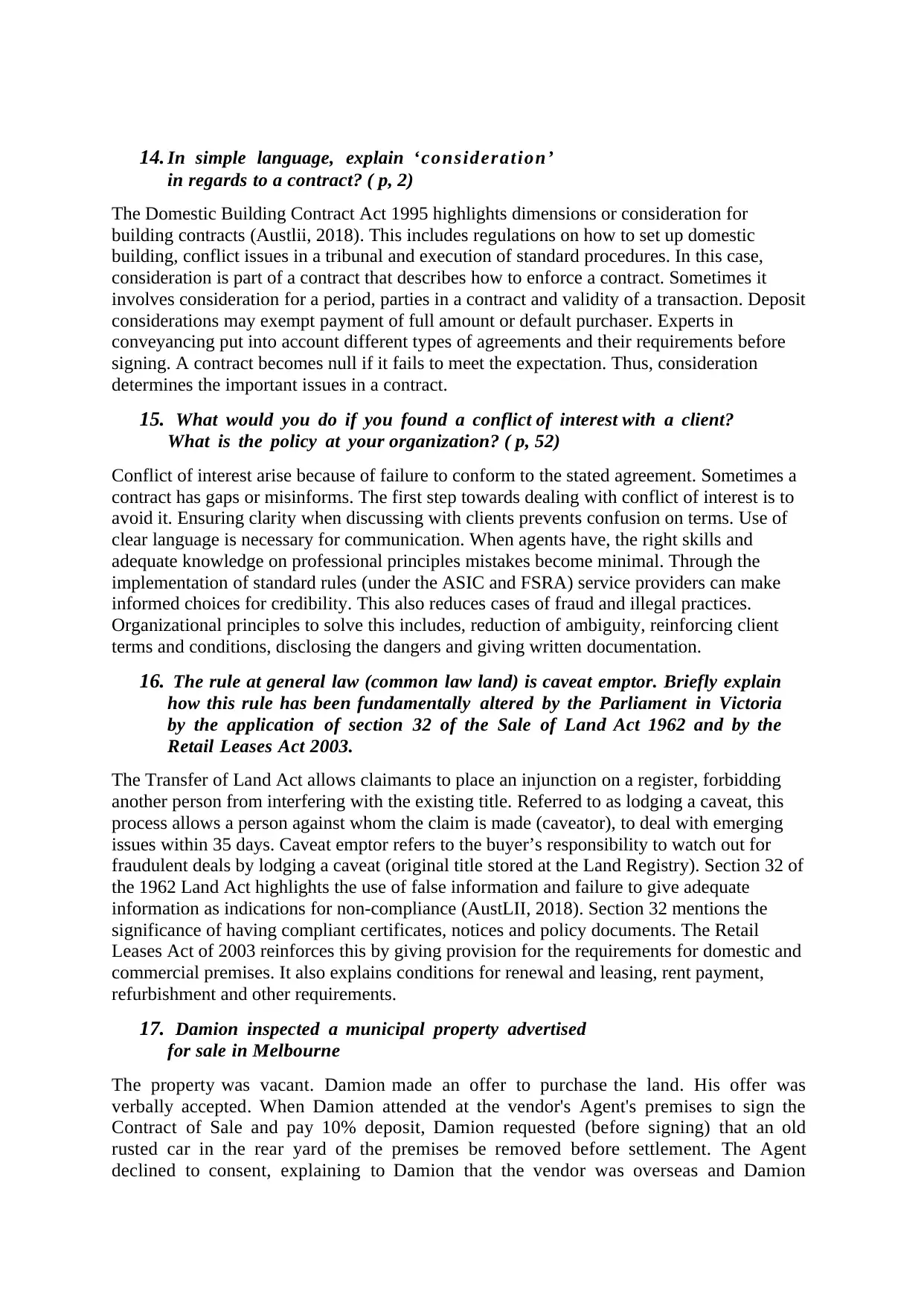
14. In simple language, explain ‘consideration’
in regards to a c on t ra ct? ( p, 2)
The Domestic Building Contract Act 1995 highlights dimensions or consideration for
building contracts (Austlii, 2018). This includes regulations on how to set up domestic
building, conflict issues in a tribunal and execution of standard procedures. In this case,
consideration is part of a contract that describes how to enforce a contract. Sometimes it
involves consideration for a period, parties in a contract and validity of a transaction. Deposit
considerations may exempt payment of full amount or default purchaser. Experts in
conveyancing put into account different types of agreements and their requirements before
signing. A contract becomes null if it fails to meet the expectation. Thus, consideration
determines the important issues in a contract.
15. What would you do if you found a conflict of interest with a client?
What is the policy at your organi zati on? ( p, 52)
Conflict of interest arise because of failure to conform to the stated agreement. Sometimes a
contract has gaps or misinforms. The first step towards dealing with conflict of interest is to
avoid it. Ensuring clarity when discussing with clients prevents confusion on terms. Use of
clear language is necessary for communication. When agents have, the right skills and
adequate knowledge on professional principles mistakes become minimal. Through the
implementation of standard rules (under the ASIC and FSRA) service providers can make
informed choices for credibility. This also reduces cases of fraud and illegal practices.
Organizational principles to solve this includes, reduction of ambiguity, reinforcing client
terms and conditions, disclosing the dangers and giving written documentation.
16. The rule at general law (common law land) is caveat emptor. Briefly explain
how this rule has b ee n fundamentally altered by the Parliament in Victoria
by the application of section 32 of the Sale of L a nd Act 1962 and by the
Retail Leases Act 2003.
The Transfer of Land Act allows claimants to place an injunction on a register, forbidding
another person from interfering with the existing title. Referred to as lodging a caveat, this
process allows a person against whom the claim is made (caveator), to deal with emerging
issues within 35 days. Caveat emptor refers to the buyer’s responsibility to watch out for
fraudulent deals by lodging a caveat (original title stored at the Land Registry). Section 32 of
the 1962 Land Act highlights the use of false information and failure to give adequate
information as indications for non-compliance (AustLII, 2018). Section 32 mentions the
significance of having compliant certificates, notices and policy documents. The Retail
Leases Act of 2003 reinforces this by giving provision for the requirements for domestic and
commercial premises. It also explains conditions for renewal and leasing, rent payment,
refurbishment and other requirements.
17. Damion inspected a municipal property advertised
for sale in Me l bourn e
The property was vacant. Damion made an offer to purchase the land. His offer was
verbally accepted . When Damion attended at the vendor's Agent's premises to sign the
Contract of Sale and pay 10% d e pos it , Damion requested (before signing) that an old
rusted car in the rear yard of the premises be removed befor e settlement. The Agent
declined to consent, explaining to Damion that the vendor was overseas and Dam i on
in regards to a c on t ra ct? ( p, 2)
The Domestic Building Contract Act 1995 highlights dimensions or consideration for
building contracts (Austlii, 2018). This includes regulations on how to set up domestic
building, conflict issues in a tribunal and execution of standard procedures. In this case,
consideration is part of a contract that describes how to enforce a contract. Sometimes it
involves consideration for a period, parties in a contract and validity of a transaction. Deposit
considerations may exempt payment of full amount or default purchaser. Experts in
conveyancing put into account different types of agreements and their requirements before
signing. A contract becomes null if it fails to meet the expectation. Thus, consideration
determines the important issues in a contract.
15. What would you do if you found a conflict of interest with a client?
What is the policy at your organi zati on? ( p, 52)
Conflict of interest arise because of failure to conform to the stated agreement. Sometimes a
contract has gaps or misinforms. The first step towards dealing with conflict of interest is to
avoid it. Ensuring clarity when discussing with clients prevents confusion on terms. Use of
clear language is necessary for communication. When agents have, the right skills and
adequate knowledge on professional principles mistakes become minimal. Through the
implementation of standard rules (under the ASIC and FSRA) service providers can make
informed choices for credibility. This also reduces cases of fraud and illegal practices.
Organizational principles to solve this includes, reduction of ambiguity, reinforcing client
terms and conditions, disclosing the dangers and giving written documentation.
16. The rule at general law (common law land) is caveat emptor. Briefly explain
how this rule has b ee n fundamentally altered by the Parliament in Victoria
by the application of section 32 of the Sale of L a nd Act 1962 and by the
Retail Leases Act 2003.
The Transfer of Land Act allows claimants to place an injunction on a register, forbidding
another person from interfering with the existing title. Referred to as lodging a caveat, this
process allows a person against whom the claim is made (caveator), to deal with emerging
issues within 35 days. Caveat emptor refers to the buyer’s responsibility to watch out for
fraudulent deals by lodging a caveat (original title stored at the Land Registry). Section 32 of
the 1962 Land Act highlights the use of false information and failure to give adequate
information as indications for non-compliance (AustLII, 2018). Section 32 mentions the
significance of having compliant certificates, notices and policy documents. The Retail
Leases Act of 2003 reinforces this by giving provision for the requirements for domestic and
commercial premises. It also explains conditions for renewal and leasing, rent payment,
refurbishment and other requirements.
17. Damion inspected a municipal property advertised
for sale in Me l bourn e
The property was vacant. Damion made an offer to purchase the land. His offer was
verbally accepted . When Damion attended at the vendor's Agent's premises to sign the
Contract of Sale and pay 10% d e pos it , Damion requested (before signing) that an old
rusted car in the rear yard of the premises be removed befor e settlement. The Agent
declined to consent, explaining to Damion that the vendor was overseas and Dam i on
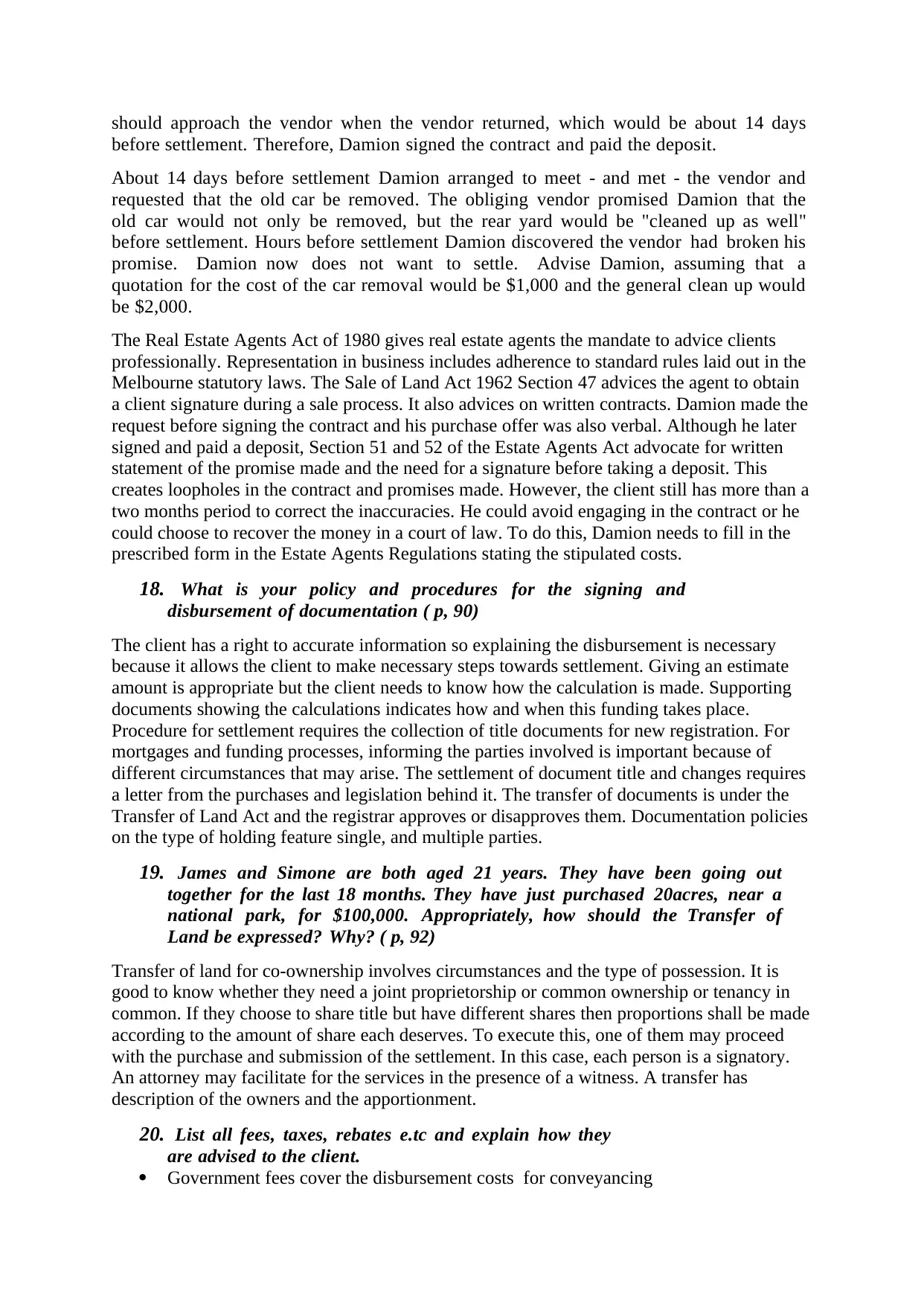
should approach the vendor when the vendor returned, which would be about 14 days
before settlement. Therefore, Damion signed the contract and paid the d e pos it.
About 14 days before settlement Damion arranged to meet - and met - the vendor and
requested that the o l d car be removed. The obliging vendor promised Damion that the
old car would not only be removed, but t he rear yard would be "cleaned up as well"
before settlement. Hours before settlement Damion discovered t h e vendor had broken his
promise. Damion now does not want to settle. Advise Damion, assuming that a
quotation for the cost of the car removal would be $1,000 and the general clean up would
be $2,000.
The Real Estate Agents Act of 1980 gives real estate agents the mandate to advice clients
professionally. Representation in business includes adherence to standard rules laid out in the
Melbourne statutory laws. The Sale of Land Act 1962 Section 47 advices the agent to obtain
a client signature during a sale process. It also advices on written contracts. Damion made the
request before signing the contract and his purchase offer was also verbal. Although he later
signed and paid a deposit, Section 51 and 52 of the Estate Agents Act advocate for written
statement of the promise made and the need for a signature before taking a deposit. This
creates loopholes in the contract and promises made. However, the client still has more than a
two months period to correct the inaccuracies. He could avoid engaging in the contract or he
could choose to recover the money in a court of law. To do this, Damion needs to fill in the
prescribed form in the Estate Agents Regulations stating the stipulated costs.
18. What is your policy and procedures for the signing and
disbursement of docum e nt ati on ( p, 90)
The client has a right to accurate information so explaining the disbursement is necessary
because it allows the client to make necessary steps towards settlement. Giving an estimate
amount is appropriate but the client needs to know how the calculation is made. Supporting
documents showing the calculations indicates how and when this funding takes place.
Procedure for settlement requires the collection of title documents for new registration. For
mortgages and funding processes, informing the parties involved is important because of
different circumstances that may arise. The settlement of document title and changes requires
a letter from the purchases and legislation behind it. The transfer of documents is under the
Transfer of Land Act and the registrar approves or disapproves them. Documentation policies
on the type of holding feature single, and multiple parties.
19. James and Simone are both aged 21 years. They have been going out
together for the last 18 mon t hs. They have just purchased 20acres, near a
national park, for $100,000. Appropriately, how should th e Transfer of
Land be expressed? Why ? ( p, 92)
Transfer of land for co-ownership involves circumstances and the type of possession. It is
good to know whether they need a joint proprietorship or common ownership or tenancy in
common. If they choose to share title but have different shares then proportions shall be made
according to the amount of share each deserves. To execute this, one of them may proceed
with the purchase and submission of the settlement. In this case, each person is a signatory.
An attorney may facilitate for the services in the presence of a witness. A transfer has
description of the owners and the apportionment.
20. List all fees, taxes, rebates e.tc and explain how they
are advised to the clie n t .
Government fees cover the disbursement costs for conveyancing
before settlement. Therefore, Damion signed the contract and paid the d e pos it.
About 14 days before settlement Damion arranged to meet - and met - the vendor and
requested that the o l d car be removed. The obliging vendor promised Damion that the
old car would not only be removed, but t he rear yard would be "cleaned up as well"
before settlement. Hours before settlement Damion discovered t h e vendor had broken his
promise. Damion now does not want to settle. Advise Damion, assuming that a
quotation for the cost of the car removal would be $1,000 and the general clean up would
be $2,000.
The Real Estate Agents Act of 1980 gives real estate agents the mandate to advice clients
professionally. Representation in business includes adherence to standard rules laid out in the
Melbourne statutory laws. The Sale of Land Act 1962 Section 47 advices the agent to obtain
a client signature during a sale process. It also advices on written contracts. Damion made the
request before signing the contract and his purchase offer was also verbal. Although he later
signed and paid a deposit, Section 51 and 52 of the Estate Agents Act advocate for written
statement of the promise made and the need for a signature before taking a deposit. This
creates loopholes in the contract and promises made. However, the client still has more than a
two months period to correct the inaccuracies. He could avoid engaging in the contract or he
could choose to recover the money in a court of law. To do this, Damion needs to fill in the
prescribed form in the Estate Agents Regulations stating the stipulated costs.
18. What is your policy and procedures for the signing and
disbursement of docum e nt ati on ( p, 90)
The client has a right to accurate information so explaining the disbursement is necessary
because it allows the client to make necessary steps towards settlement. Giving an estimate
amount is appropriate but the client needs to know how the calculation is made. Supporting
documents showing the calculations indicates how and when this funding takes place.
Procedure for settlement requires the collection of title documents for new registration. For
mortgages and funding processes, informing the parties involved is important because of
different circumstances that may arise. The settlement of document title and changes requires
a letter from the purchases and legislation behind it. The transfer of documents is under the
Transfer of Land Act and the registrar approves or disapproves them. Documentation policies
on the type of holding feature single, and multiple parties.
19. James and Simone are both aged 21 years. They have been going out
together for the last 18 mon t hs. They have just purchased 20acres, near a
national park, for $100,000. Appropriately, how should th e Transfer of
Land be expressed? Why ? ( p, 92)
Transfer of land for co-ownership involves circumstances and the type of possession. It is
good to know whether they need a joint proprietorship or common ownership or tenancy in
common. If they choose to share title but have different shares then proportions shall be made
according to the amount of share each deserves. To execute this, one of them may proceed
with the purchase and submission of the settlement. In this case, each person is a signatory.
An attorney may facilitate for the services in the presence of a witness. A transfer has
description of the owners and the apportionment.
20. List all fees, taxes, rebates e.tc and explain how they
are advised to the clie n t .
Government fees cover the disbursement costs for conveyancing
Paraphrase This Document
Need a fresh take? Get an instant paraphrase of this document with our AI Paraphraser
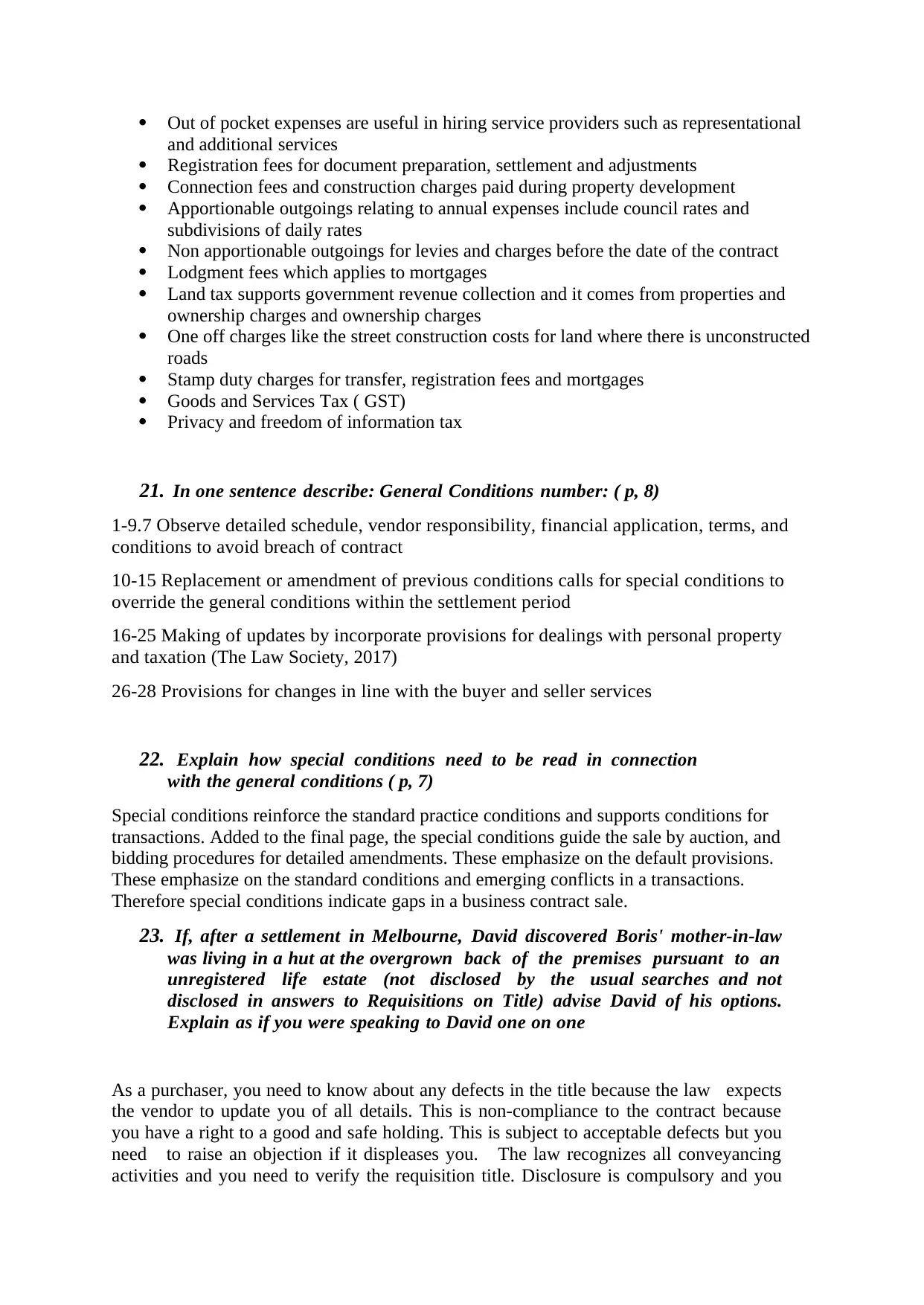
Out of pocket expenses are useful in hiring service providers such as representational
and additional services
Registration fees for document preparation, settlement and adjustments
Connection fees and construction charges paid during property development
Apportionable outgoings relating to annual expenses include council rates and
subdivisions of daily rates
Non apportionable outgoings for levies and charges before the date of the contract
Lodgment fees which applies to mortgages
Land tax supports government revenue collection and it comes from properties and
ownership charges and ownership charges
One off charges like the street construction costs for land where there is unconstructed
roads
Stamp duty charges for transfer, registration fees and mortgages
Goods and Services Tax ( GST)
Privacy and freedom of information tax
21. In one sentence d e s c r i be : General Conditions numb e r : ( p, 8)
1-9.7 Observe detailed schedule, vendor responsibility, financial application, terms, and
conditions to avoid breach of contract
10-15 Replacement or amendment of previous conditions calls for special conditions to
override the general conditions within the settlement period
16-25 Making of updates by incorporate provisions for dealings with personal property
and taxation (The Law Society, 2017)
26-28 Provisions for changes in line with the buyer and seller services
22. Explain how special conditions need to be read in connection
with the general c ondi ti ons ( p, 7)
Special conditions reinforce the standard practice conditions and supports conditions for
transactions. Added to the final page, the special conditions guide the sale by auction, and
bidding procedures for detailed amendments. These emphasize on the default provisions.
These emphasize on the standard conditions and emerging conflicts in a transactions.
Therefore special conditions indicate gaps in a business contract sale.
23. If, after a settlement in Melbourne, David discovered Boris' mother-in-law
was living in a hut at th e overgrown back of the premises pursuant to an
unregistered life estate (not disclosed by the usu al searches and not
disclosed in answers to Requisitions on Title) advise David of his options.
Explain as i f you were speaking to David one on one
As a purchaser, you need to know about any defects in the title because the law expects
the vendor to update you of all details. This is non-compliance to the contract because
you have a right to a good and safe holding. This is subject to acceptable defects but you
need to raise an objection if it displeases you. The law recognizes all conveyancing
activities and you need to verify the requisition title. Disclosure is compulsory and you
and additional services
Registration fees for document preparation, settlement and adjustments
Connection fees and construction charges paid during property development
Apportionable outgoings relating to annual expenses include council rates and
subdivisions of daily rates
Non apportionable outgoings for levies and charges before the date of the contract
Lodgment fees which applies to mortgages
Land tax supports government revenue collection and it comes from properties and
ownership charges and ownership charges
One off charges like the street construction costs for land where there is unconstructed
roads
Stamp duty charges for transfer, registration fees and mortgages
Goods and Services Tax ( GST)
Privacy and freedom of information tax
21. In one sentence d e s c r i be : General Conditions numb e r : ( p, 8)
1-9.7 Observe detailed schedule, vendor responsibility, financial application, terms, and
conditions to avoid breach of contract
10-15 Replacement or amendment of previous conditions calls for special conditions to
override the general conditions within the settlement period
16-25 Making of updates by incorporate provisions for dealings with personal property
and taxation (The Law Society, 2017)
26-28 Provisions for changes in line with the buyer and seller services
22. Explain how special conditions need to be read in connection
with the general c ondi ti ons ( p, 7)
Special conditions reinforce the standard practice conditions and supports conditions for
transactions. Added to the final page, the special conditions guide the sale by auction, and
bidding procedures for detailed amendments. These emphasize on the default provisions.
These emphasize on the standard conditions and emerging conflicts in a transactions.
Therefore special conditions indicate gaps in a business contract sale.
23. If, after a settlement in Melbourne, David discovered Boris' mother-in-law
was living in a hut at th e overgrown back of the premises pursuant to an
unregistered life estate (not disclosed by the usu al searches and not
disclosed in answers to Requisitions on Title) advise David of his options.
Explain as i f you were speaking to David one on one
As a purchaser, you need to know about any defects in the title because the law expects
the vendor to update you of all details. This is non-compliance to the contract because
you have a right to a good and safe holding. This is subject to acceptable defects but you
need to raise an objection if it displeases you. The law recognizes all conveyancing
activities and you need to verify the requisition title. Disclosure is compulsory and you

are to identify the land correctly. It should appear in the search. You should be able to
identify pipe water systems, electricity, gas and plans affecting this piece of land.
Accurate details are important because you signed a contract with a declaration. The
disclosure should contain any special conditions and details about the neighborhood.
Non-disclosure is a violation of the Sale of Land Act 1962 Section 32 clause 7, which
gives you the power to penalize the vendor or reject the contract. There is probable
breach of contract because it deviates from the contract.
identify pipe water systems, electricity, gas and plans affecting this piece of land.
Accurate details are important because you signed a contract with a declaration. The
disclosure should contain any special conditions and details about the neighborhood.
Non-disclosure is a violation of the Sale of Land Act 1962 Section 32 clause 7, which
gives you the power to penalize the vendor or reject the contract. There is probable
breach of contract because it deviates from the contract.
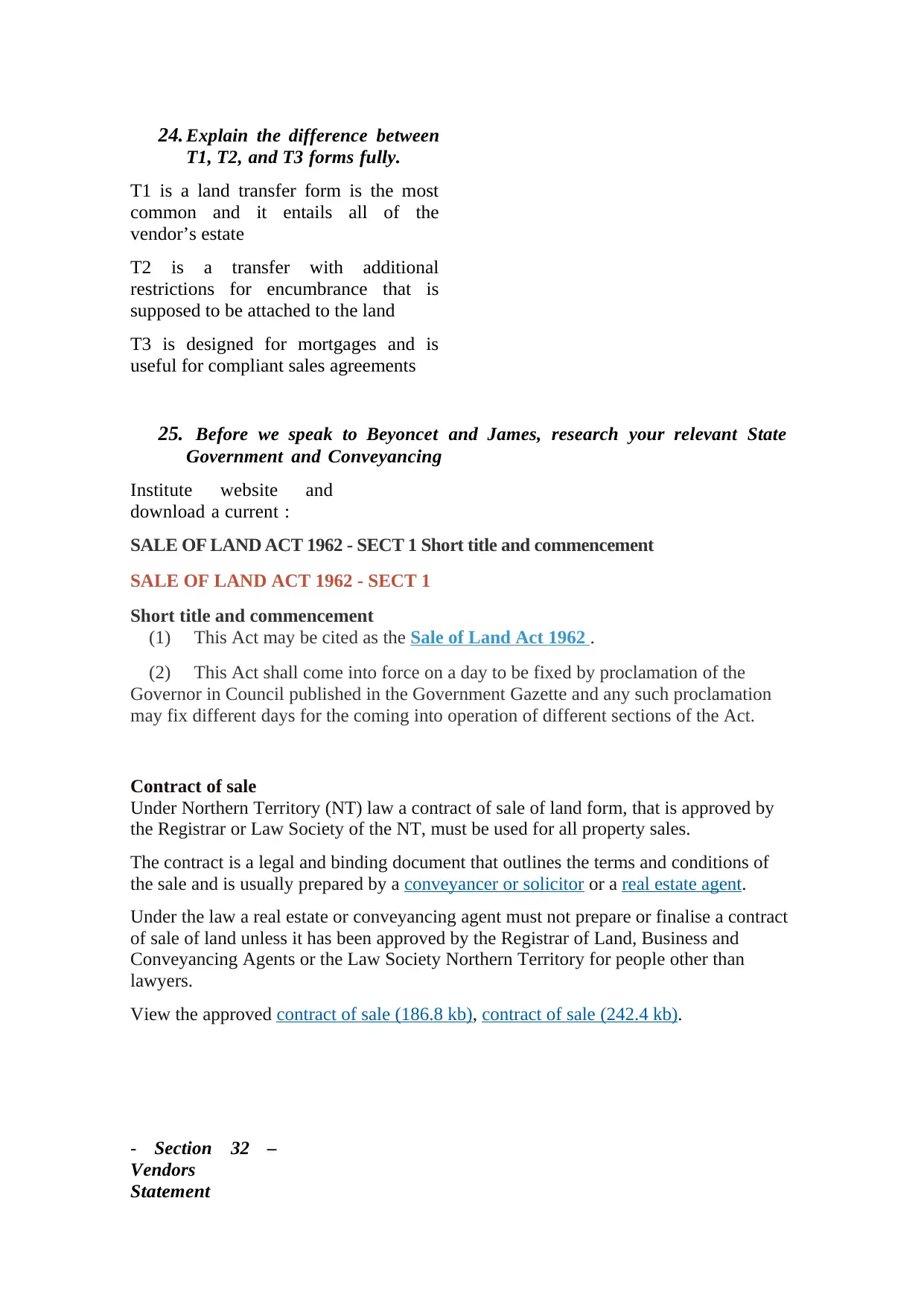
24. Explain the difference between
T1, T2, and T3 forms fu ll y.
T1 is a land transfer form is the most
common and it entails all of the
vendor’s estate
T2 is a transfer with additional
restrictions for encumbrance that is
supposed to be attached to the land
T3 is designed for mortgages and is
useful for compliant sales agreements
25. Before we speak to Beyoncet and James, research your relevant State
Government and C onv e y a n ci ng
Institute website and
download a current :
SALE OF LAND ACT 1962 - SECT 1 Short title and commencement
SALE OF LAND ACT 1962 - SECT 1
Short title and commencement
(1) This Act may be cited as the Sale of Land Act 1962 .
(2) This Act shall come into force on a day to be fixed by proclamation of the
Governor in Council published in the Government Gazette and any such proclamation
may fix different days for the coming into operation of different sections of the Act.
Contract of sale
Under Northern Territory (NT) law a contract of sale of land form, that is approved by
the Registrar or Law Society of the NT, must be used for all property sales.
The contract is a legal and binding document that outlines the terms and conditions of
the sale and is usually prepared by a conveyancer or solicitor or a real estate agent.
Under the law a real estate or conveyancing agent must not prepare or finalise a contract
of sale of land unless it has been approved by the Registrar of Land, Business and
Conveyancing Agents or the Law Society Northern Territory for people other than
lawyers.
View the approved contract of sale (186.8 kb), contract of sale (242.4 kb).
- Section 32 –
Vendors
S tate m e n t
T1, T2, and T3 forms fu ll y.
T1 is a land transfer form is the most
common and it entails all of the
vendor’s estate
T2 is a transfer with additional
restrictions for encumbrance that is
supposed to be attached to the land
T3 is designed for mortgages and is
useful for compliant sales agreements
25. Before we speak to Beyoncet and James, research your relevant State
Government and C onv e y a n ci ng
Institute website and
download a current :
SALE OF LAND ACT 1962 - SECT 1 Short title and commencement
SALE OF LAND ACT 1962 - SECT 1
Short title and commencement
(1) This Act may be cited as the Sale of Land Act 1962 .
(2) This Act shall come into force on a day to be fixed by proclamation of the
Governor in Council published in the Government Gazette and any such proclamation
may fix different days for the coming into operation of different sections of the Act.
Contract of sale
Under Northern Territory (NT) law a contract of sale of land form, that is approved by
the Registrar or Law Society of the NT, must be used for all property sales.
The contract is a legal and binding document that outlines the terms and conditions of
the sale and is usually prepared by a conveyancer or solicitor or a real estate agent.
Under the law a real estate or conveyancing agent must not prepare or finalise a contract
of sale of land unless it has been approved by the Registrar of Land, Business and
Conveyancing Agents or the Law Society Northern Territory for people other than
lawyers.
View the approved contract of sale (186.8 kb), contract of sale (242.4 kb).
- Section 32 –
Vendors
S tate m e n t
Secure Best Marks with AI Grader
Need help grading? Try our AI Grader for instant feedback on your assignments.
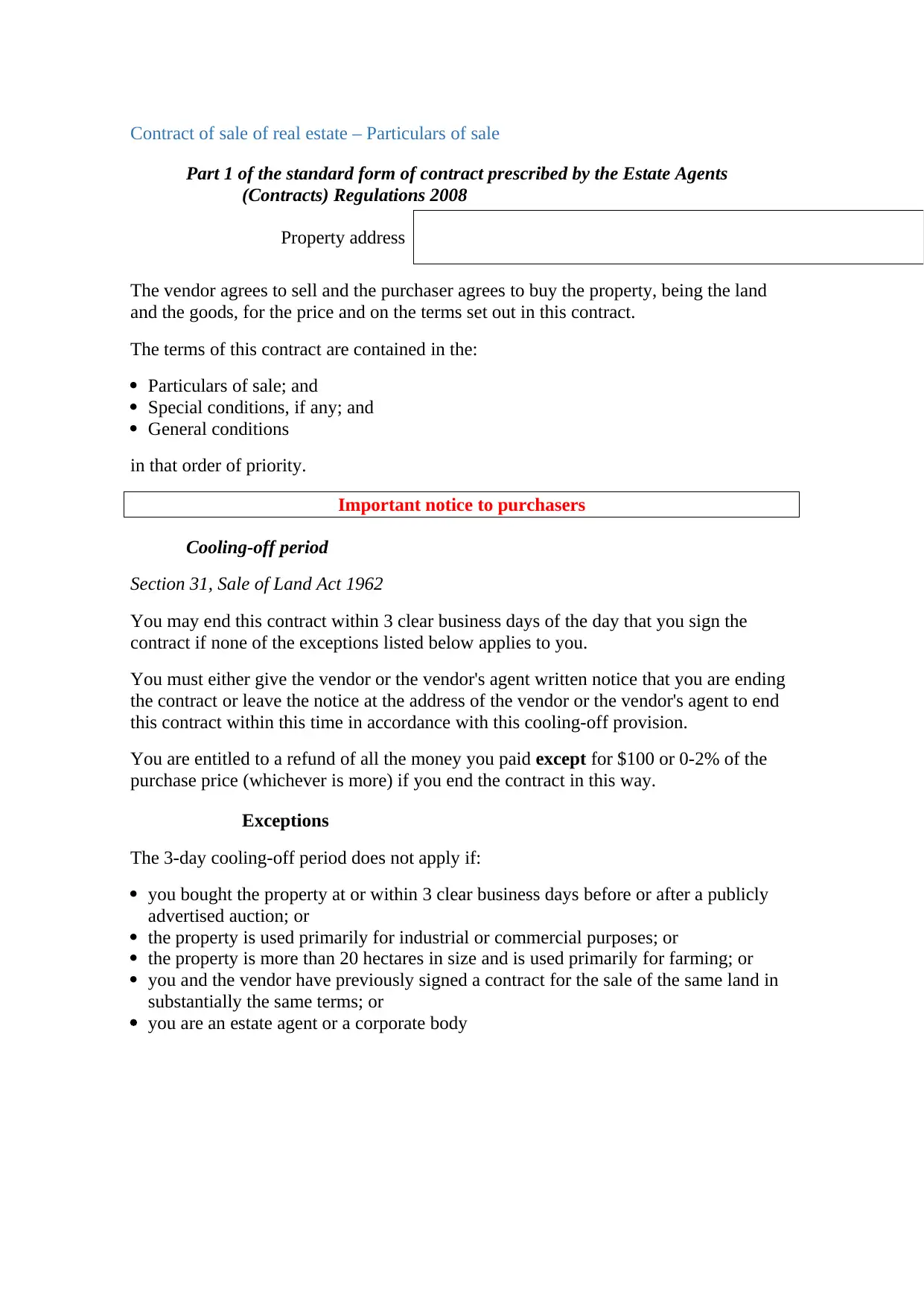
Contract of sale of real estate – Particulars of sale
Part 1 of the standard form of contract prescribed by the Estate Agents
(Contracts) Regulations 2008
Property address
The vendor agrees to sell and the purchaser agrees to buy the property, being the land
and the goods, for the price and on the terms set out in this contract.
The terms of this contract are contained in the:
Particulars of sale; and
Special conditions, if any; and
General conditions
in that order of priority.
Important notice to purchasers
Cooling-off period
Section 31, Sale of Land Act 1962
You may end this contract within 3 clear business days of the day that you sign the
contract if none of the exceptions listed below applies to you.
You must either give the vendor or the vendor's agent written notice that you are ending
the contract or leave the notice at the address of the vendor or the vendor's agent to end
this contract within this time in accordance with this cooling-off provision.
You are entitled to a refund of all the money you paid except for $100 or 0-2% of the
purchase price (whichever is more) if you end the contract in this way.
Exceptions
The 3-day cooling-off period does not apply if:
you bought the property at or within 3 clear business days before or after a publicly
advertised auction; or
the property is used primarily for industrial or commercial purposes; or
the property is more than 20 hectares in size and is used primarily for farming; or
you and the vendor have previously signed a contract for the sale of the same land in
substantially the same terms; or
you are an estate agent or a corporate body
Part 1 of the standard form of contract prescribed by the Estate Agents
(Contracts) Regulations 2008
Property address
The vendor agrees to sell and the purchaser agrees to buy the property, being the land
and the goods, for the price and on the terms set out in this contract.
The terms of this contract are contained in the:
Particulars of sale; and
Special conditions, if any; and
General conditions
in that order of priority.
Important notice to purchasers
Cooling-off period
Section 31, Sale of Land Act 1962
You may end this contract within 3 clear business days of the day that you sign the
contract if none of the exceptions listed below applies to you.
You must either give the vendor or the vendor's agent written notice that you are ending
the contract or leave the notice at the address of the vendor or the vendor's agent to end
this contract within this time in accordance with this cooling-off provision.
You are entitled to a refund of all the money you paid except for $100 or 0-2% of the
purchase price (whichever is more) if you end the contract in this way.
Exceptions
The 3-day cooling-off period does not apply if:
you bought the property at or within 3 clear business days before or after a publicly
advertised auction; or
the property is used primarily for industrial or commercial purposes; or
the property is more than 20 hectares in size and is used primarily for farming; or
you and the vendor have previously signed a contract for the sale of the same land in
substantially the same terms; or
you are an estate agent or a corporate body
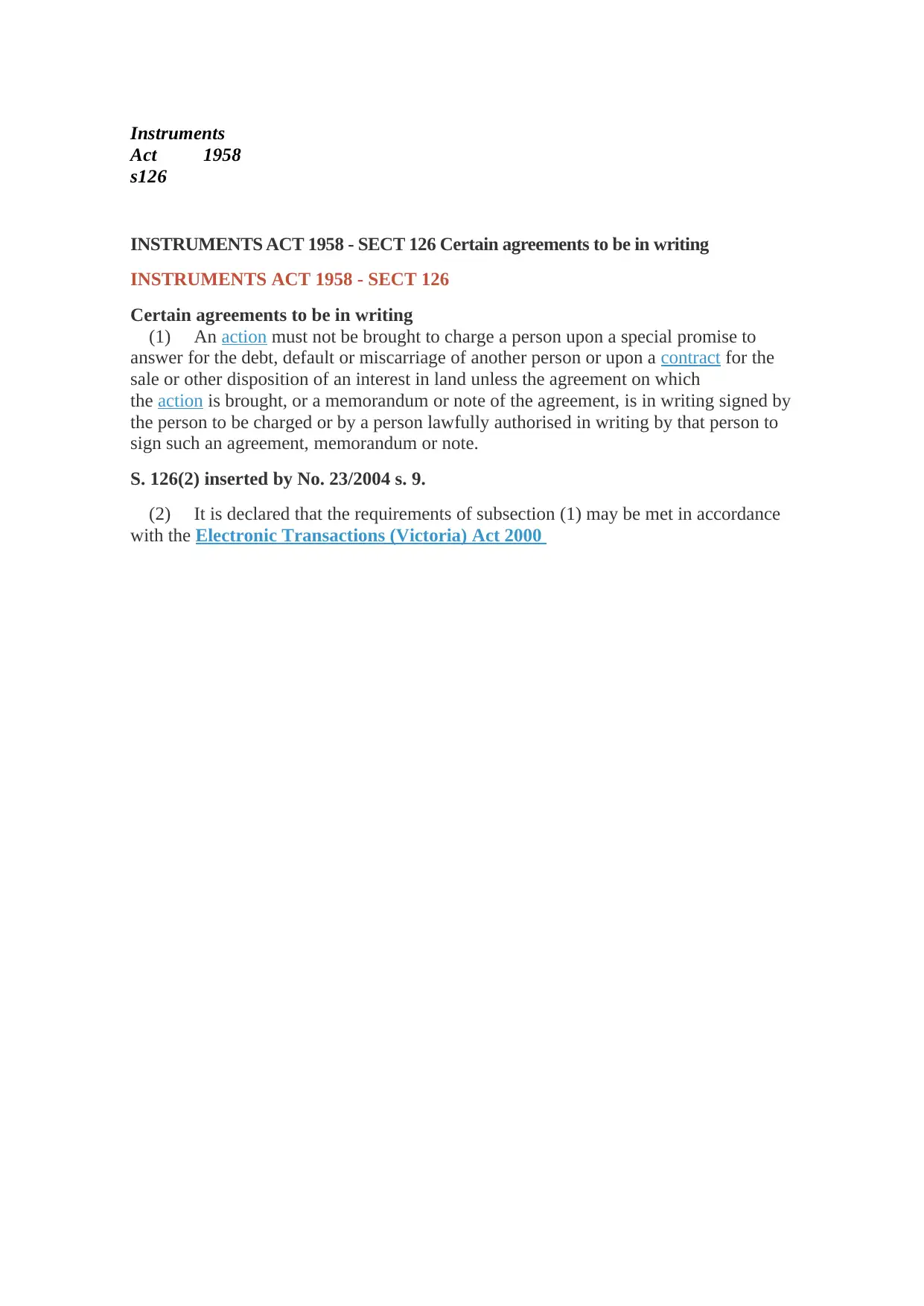
Instruments
Act 1958
s126
INSTRUMENTS ACT 1958 - SECT 126 Certain agreements to be in writing
INSTRUMENTS ACT 1958 - SECT 126
Certain agreements to be in writing
(1) An action must not be brought to charge a person upon a special promise to
answer for the debt, default or miscarriage of another person or upon a contract for the
sale or other disposition of an interest in land unless the agreement on which
the action is brought, or a memorandum or note of the agreement, is in writing signed by
the person to be charged or by a person lawfully authorised in writing by that person to
sign such an agreement, memorandum or note.
S. 126(2) inserted by No. 23/2004 s. 9.
(2) It is declared that the requirements of subsection (1) may be met in accordance
with the Electronic Transactions (Victoria) Act 2000
Act 1958
s126
INSTRUMENTS ACT 1958 - SECT 126 Certain agreements to be in writing
INSTRUMENTS ACT 1958 - SECT 126
Certain agreements to be in writing
(1) An action must not be brought to charge a person upon a special promise to
answer for the debt, default or miscarriage of another person or upon a contract for the
sale or other disposition of an interest in land unless the agreement on which
the action is brought, or a memorandum or note of the agreement, is in writing signed by
the person to be charged or by a person lawfully authorised in writing by that person to
sign such an agreement, memorandum or note.
S. 126(2) inserted by No. 23/2004 s. 9.
(2) It is declared that the requirements of subsection (1) may be met in accordance
with the Electronic Transactions (Victoria) Act 2000
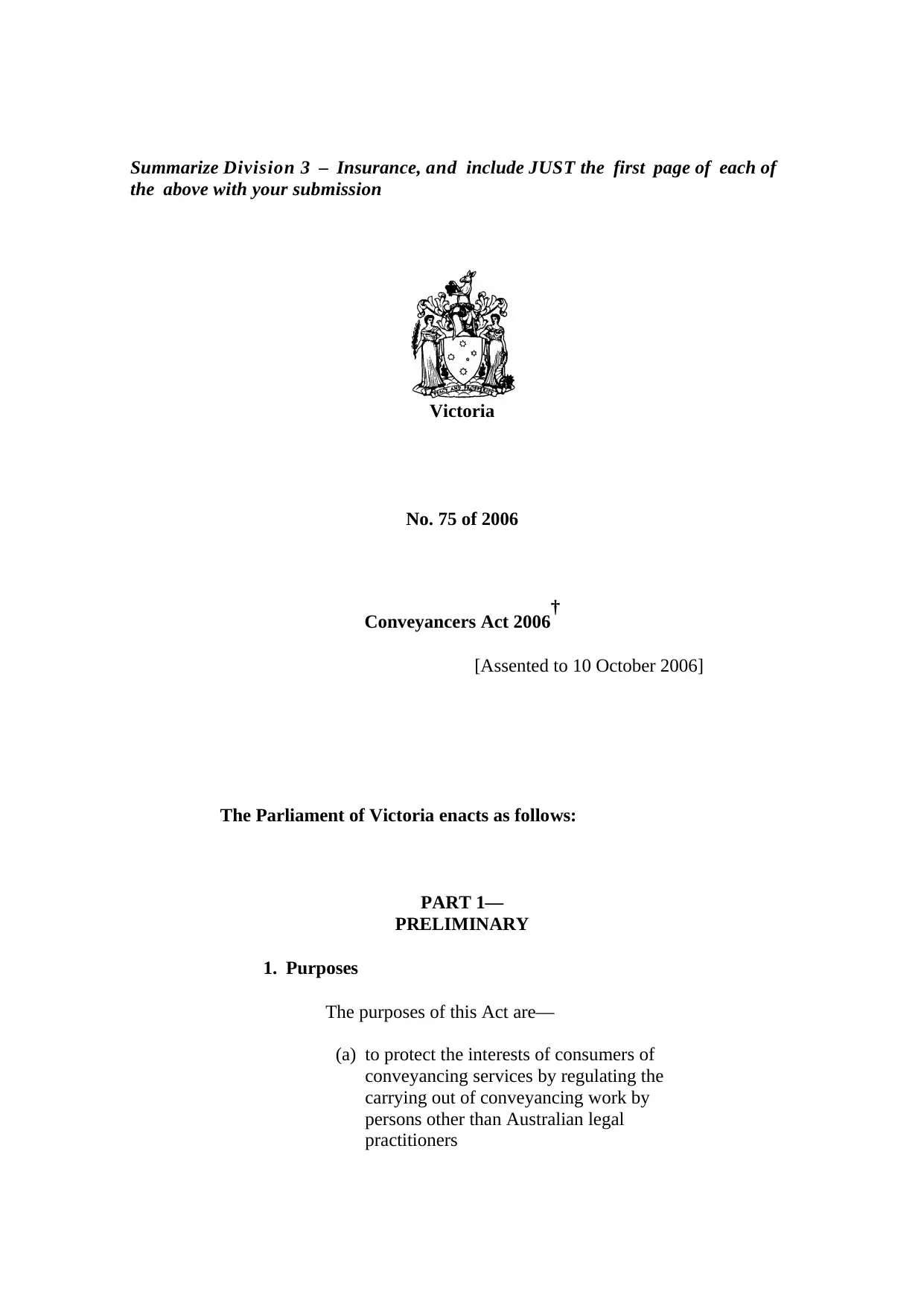
Summarize Division 3 – Insurance, and include JUST the first page of each of
the above with your subm i ssion
Victoria
No. 75 of 2006
Conveyancers Act 2006†
[Assented to 10 October 2006]
The Parliament of Victoria enacts as follows:
PART 1—
PRELIMINARY
1. Purposes
The purposes of this Act are—
(a) to protect the interests of consumers of
conveyancing services by regulating the
carrying out of conveyancing work by
persons other than Australian legal
practitioners
the above with your subm i ssion
Victoria
No. 75 of 2006
Conveyancers Act 2006†
[Assented to 10 October 2006]
The Parliament of Victoria enacts as follows:
PART 1—
PRELIMINARY
1. Purposes
The purposes of this Act are—
(a) to protect the interests of consumers of
conveyancing services by regulating the
carrying out of conveyancing work by
persons other than Australian legal
practitioners
Paraphrase This Document
Need a fresh take? Get an instant paraphrase of this document with our AI Paraphraser
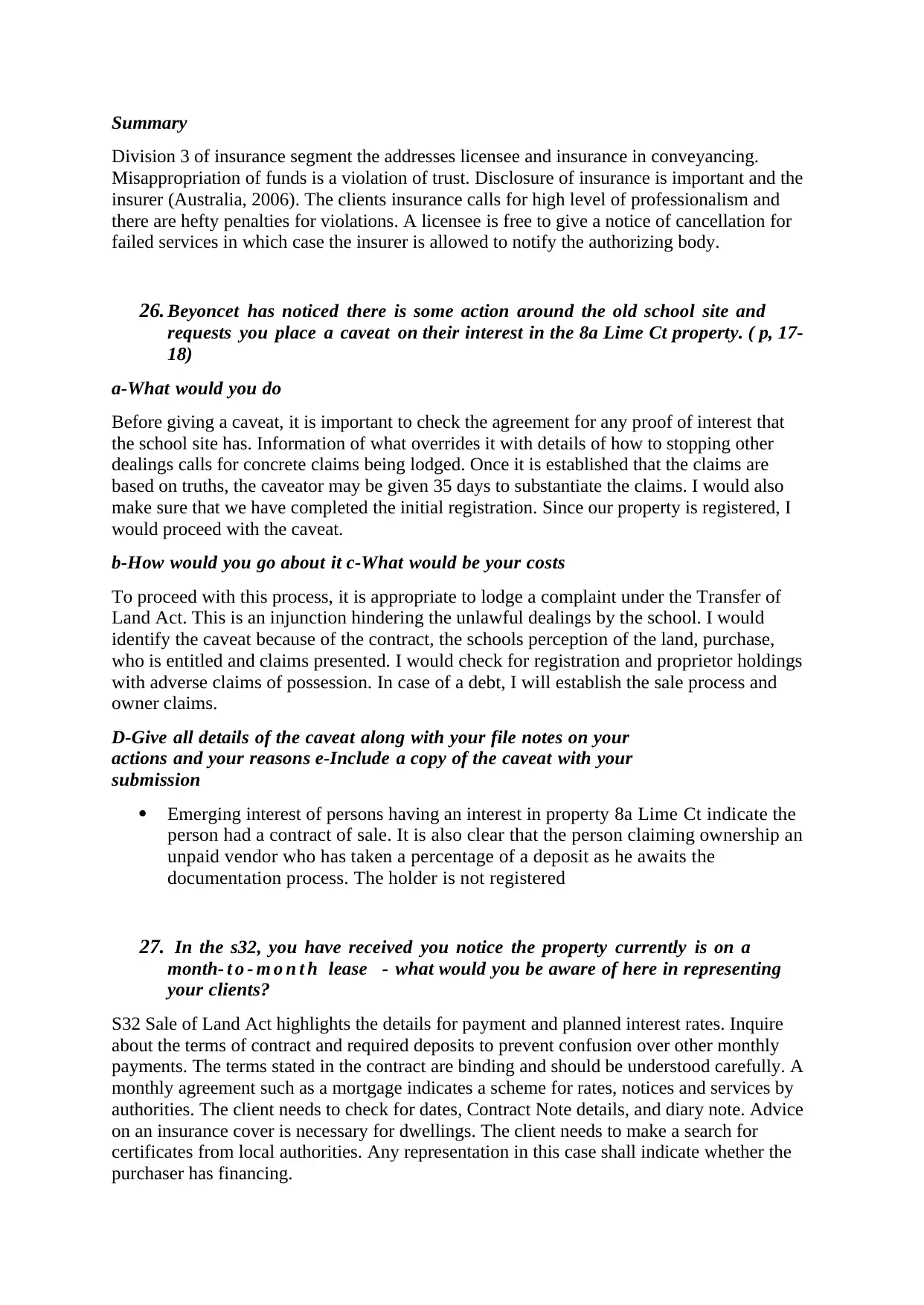
Summary
Division 3 of insurance segment the addresses licensee and insurance in conveyancing.
Misappropriation of funds is a violation of trust. Disclosure of insurance is important and the
insurer (Australia, 2006). The clients insurance calls for high level of professionalism and
there are hefty penalties for violations. A licensee is free to give a notice of cancellation for
failed services in which case the insurer is allowed to notify the authorizing body.
26. Beyoncet has noticed there is some action around the old school site and
requests you place a caveat on their interest in the 8a Lime Ct prop e rty. ( p, 17-
18)
a-What would you do
Before giving a caveat, it is important to check the agreement for any proof of interest that
the school site has. Information of what overrides it with details of how to stopping other
dealings calls for concrete claims being lodged. Once it is established that the claims are
based on truths, the caveator may be given 35 days to substantiate the claims. I would also
make sure that we have completed the initial registration. Since our property is registered, I
would proceed with the caveat.
b-How would you go about it c-What would be your c os t s
To proceed with this process, it is appropriate to lodge a complaint under the Transfer of
Land Act. This is an injunction hindering the unlawful dealings by the school. I would
identify the caveat because of the contract, the schools perception of the land, purchase,
who is entitled and claims presented. I would check for registration and proprietor holdings
with adverse claims of possession. In case of a debt, I will establish the sale process and
owner claims.
D-Give all details of the caveat along with your file notes on your
actions and your r ea sons e-Include a copy of the caveat with your
subm i ss i on
Emerging interest of persons having an interest in property 8a Lime Ct indicate the
person had a contract of sale. It is also clear that the person claiming ownership an
unpaid vendor who has taken a percentage of a deposit as he awaits the
documentation process. The holder is not registered
27. In the s32, you have received you notice the property currently is on a
month- t o - m o n t h lease - wh at would you be aware of here in representing
your clie n t s ?
S32 Sale of Land Act highlights the details for payment and planned interest rates. Inquire
about the terms of contract and required deposits to prevent confusion over other monthly
payments. The terms stated in the contract are binding and should be understood carefully. A
monthly agreement such as a mortgage indicates a scheme for rates, notices and services by
authorities. The client needs to check for dates, Contract Note details, and diary note. Advice
on an insurance cover is necessary for dwellings. The client needs to make a search for
certificates from local authorities. Any representation in this case shall indicate whether the
purchaser has financing.
Division 3 of insurance segment the addresses licensee and insurance in conveyancing.
Misappropriation of funds is a violation of trust. Disclosure of insurance is important and the
insurer (Australia, 2006). The clients insurance calls for high level of professionalism and
there are hefty penalties for violations. A licensee is free to give a notice of cancellation for
failed services in which case the insurer is allowed to notify the authorizing body.
26. Beyoncet has noticed there is some action around the old school site and
requests you place a caveat on their interest in the 8a Lime Ct prop e rty. ( p, 17-
18)
a-What would you do
Before giving a caveat, it is important to check the agreement for any proof of interest that
the school site has. Information of what overrides it with details of how to stopping other
dealings calls for concrete claims being lodged. Once it is established that the claims are
based on truths, the caveator may be given 35 days to substantiate the claims. I would also
make sure that we have completed the initial registration. Since our property is registered, I
would proceed with the caveat.
b-How would you go about it c-What would be your c os t s
To proceed with this process, it is appropriate to lodge a complaint under the Transfer of
Land Act. This is an injunction hindering the unlawful dealings by the school. I would
identify the caveat because of the contract, the schools perception of the land, purchase,
who is entitled and claims presented. I would check for registration and proprietor holdings
with adverse claims of possession. In case of a debt, I will establish the sale process and
owner claims.
D-Give all details of the caveat along with your file notes on your
actions and your r ea sons e-Include a copy of the caveat with your
subm i ss i on
Emerging interest of persons having an interest in property 8a Lime Ct indicate the
person had a contract of sale. It is also clear that the person claiming ownership an
unpaid vendor who has taken a percentage of a deposit as he awaits the
documentation process. The holder is not registered
27. In the s32, you have received you notice the property currently is on a
month- t o - m o n t h lease - wh at would you be aware of here in representing
your clie n t s ?
S32 Sale of Land Act highlights the details for payment and planned interest rates. Inquire
about the terms of contract and required deposits to prevent confusion over other monthly
payments. The terms stated in the contract are binding and should be understood carefully. A
monthly agreement such as a mortgage indicates a scheme for rates, notices and services by
authorities. The client needs to check for dates, Contract Note details, and diary note. Advice
on an insurance cover is necessary for dwellings. The client needs to make a search for
certificates from local authorities. Any representation in this case shall indicate whether the
purchaser has financing.
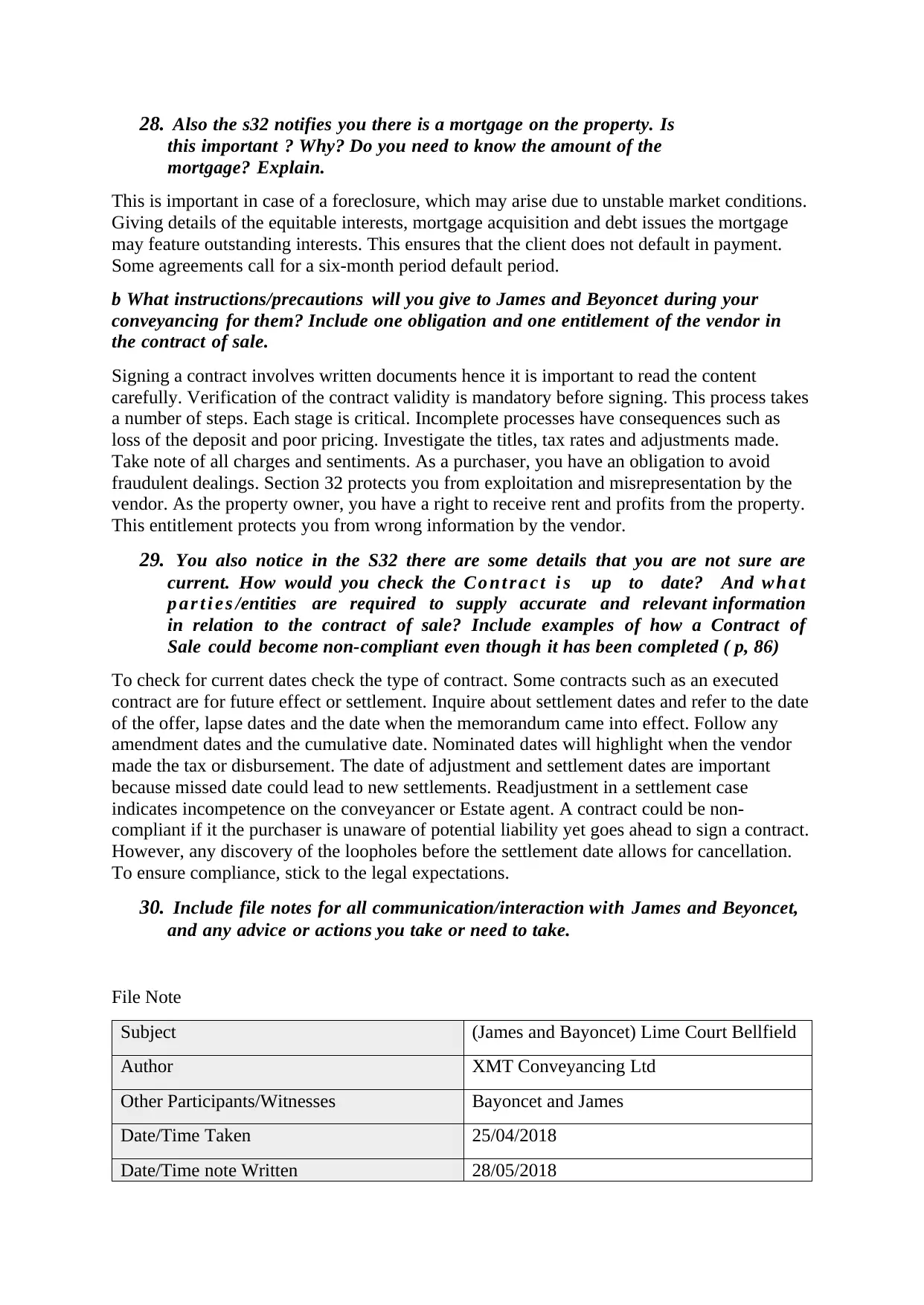
28. Also the s32 notifies you there is a mortgage on the property. Is
this important ? Why ? Do you need to know the amount of the
mortgage? Exp la in.
This is important in case of a foreclosure, which may arise due to unstable market conditions.
Giving details of the equitable interests, mortgage acquisition and debt issues the mortgage
may feature outstanding interests. This ensures that the client does not default in payment.
Some agreements call for a six-month period default period.
b What instructions/precautions will you give to James and Beyoncet during your
conveyancing for th e m ? Include one obligation and one entitlement of the vendor in
the contract of s ale .
Signing a contract involves written documents hence it is important to read the content
carefully. Verification of the contract validity is mandatory before signing. This process takes
a number of steps. Each stage is critical. Incomplete processes have consequences such as
loss of the deposit and poor pricing. Investigate the titles, tax rates and adjustments made.
Take note of all charges and sentiments. As a purchaser, you have an obligation to avoid
fraudulent dealings. Section 32 protects you from exploitation and misrepresentation by the
vendor. As the property owner, you have a right to receive rent and profits from the property.
This entitlement protects you from wrong information by the vendor.
29. You also notice in the S32 there are some details that you are not sure are
current. How would you check the C o n t r a c t i s up to date? And w h a t
p a r t i e s /entities are required to supply accurate and r ele v a n t information
in relation to the contract of sale? Include examples of how a Contract of
Sale could becom e non-compliant even though it has been c ompl ete d ( p, 86)
To check for current dates check the type of contract. Some contracts such as an executed
contract are for future effect or settlement. Inquire about settlement dates and refer to the date
of the offer, lapse dates and the date when the memorandum came into effect. Follow any
amendment dates and the cumulative date. Nominated dates will highlight when the vendor
made the tax or disbursement. The date of adjustment and settlement dates are important
because missed date could lead to new settlements. Readjustment in a settlement case
indicates incompetence on the conveyancer or Estate agent. A contract could be non-
compliant if it the purchaser is unaware of potential liability yet goes ahead to sign a contract.
However, any discovery of the loopholes before the settlement date allows for cancellation.
To ensure compliance, stick to the legal expectations.
30. Include file notes for all communication/interaction with James and Beyoncet,
and any advice or acti ons you take or need to ta ke.
File Note
Subject (James and Bayoncet) Lime Court Bellfield
Author XMT Conveyancing Ltd
Other Participants/Witnesses Bayoncet and James
Date/Time Taken 25/04/2018
Date/Time note Written 28/05/2018
this important ? Why ? Do you need to know the amount of the
mortgage? Exp la in.
This is important in case of a foreclosure, which may arise due to unstable market conditions.
Giving details of the equitable interests, mortgage acquisition and debt issues the mortgage
may feature outstanding interests. This ensures that the client does not default in payment.
Some agreements call for a six-month period default period.
b What instructions/precautions will you give to James and Beyoncet during your
conveyancing for th e m ? Include one obligation and one entitlement of the vendor in
the contract of s ale .
Signing a contract involves written documents hence it is important to read the content
carefully. Verification of the contract validity is mandatory before signing. This process takes
a number of steps. Each stage is critical. Incomplete processes have consequences such as
loss of the deposit and poor pricing. Investigate the titles, tax rates and adjustments made.
Take note of all charges and sentiments. As a purchaser, you have an obligation to avoid
fraudulent dealings. Section 32 protects you from exploitation and misrepresentation by the
vendor. As the property owner, you have a right to receive rent and profits from the property.
This entitlement protects you from wrong information by the vendor.
29. You also notice in the S32 there are some details that you are not sure are
current. How would you check the C o n t r a c t i s up to date? And w h a t
p a r t i e s /entities are required to supply accurate and r ele v a n t information
in relation to the contract of sale? Include examples of how a Contract of
Sale could becom e non-compliant even though it has been c ompl ete d ( p, 86)
To check for current dates check the type of contract. Some contracts such as an executed
contract are for future effect or settlement. Inquire about settlement dates and refer to the date
of the offer, lapse dates and the date when the memorandum came into effect. Follow any
amendment dates and the cumulative date. Nominated dates will highlight when the vendor
made the tax or disbursement. The date of adjustment and settlement dates are important
because missed date could lead to new settlements. Readjustment in a settlement case
indicates incompetence on the conveyancer or Estate agent. A contract could be non-
compliant if it the purchaser is unaware of potential liability yet goes ahead to sign a contract.
However, any discovery of the loopholes before the settlement date allows for cancellation.
To ensure compliance, stick to the legal expectations.
30. Include file notes for all communication/interaction with James and Beyoncet,
and any advice or acti ons you take or need to ta ke.
File Note
Subject (James and Bayoncet) Lime Court Bellfield
Author XMT Conveyancing Ltd
Other Participants/Witnesses Bayoncet and James
Date/Time Taken 25/04/2018
Date/Time note Written 28/05/2018
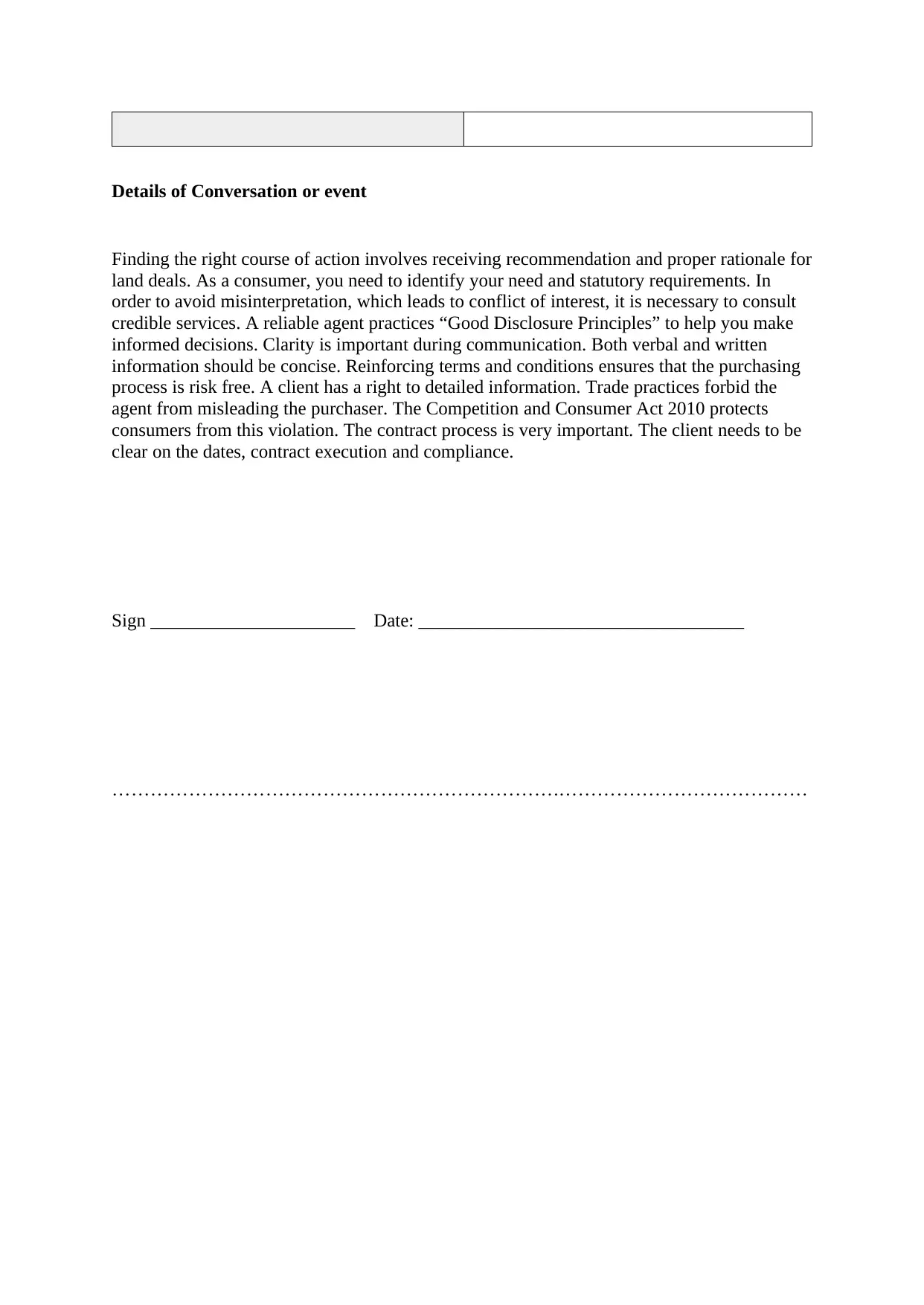
Details of Conversation or event
Finding the right course of action involves receiving recommendation and proper rationale for
land deals. As a consumer, you need to identify your need and statutory requirements. In
order to avoid misinterpretation, which leads to conflict of interest, it is necessary to consult
credible services. A reliable agent practices “Good Disclosure Principles” to help you make
informed decisions. Clarity is important during communication. Both verbal and written
information should be concise. Reinforcing terms and conditions ensures that the purchasing
process is risk free. A client has a right to detailed information. Trade practices forbid the
agent from misleading the purchaser. The Competition and Consumer Act 2010 protects
consumers from this violation. The contract process is very important. The client needs to be
clear on the dates, contract execution and compliance.
Sign ______________________ Date: ___________________________________
…………………………………………………………….…………………………………
Finding the right course of action involves receiving recommendation and proper rationale for
land deals. As a consumer, you need to identify your need and statutory requirements. In
order to avoid misinterpretation, which leads to conflict of interest, it is necessary to consult
credible services. A reliable agent practices “Good Disclosure Principles” to help you make
informed decisions. Clarity is important during communication. Both verbal and written
information should be concise. Reinforcing terms and conditions ensures that the purchasing
process is risk free. A client has a right to detailed information. Trade practices forbid the
agent from misleading the purchaser. The Competition and Consumer Act 2010 protects
consumers from this violation. The contract process is very important. The client needs to be
clear on the dates, contract execution and compliance.
Sign ______________________ Date: ___________________________________
…………………………………………………………….…………………………………
Secure Best Marks with AI Grader
Need help grading? Try our AI Grader for instant feedback on your assignments.
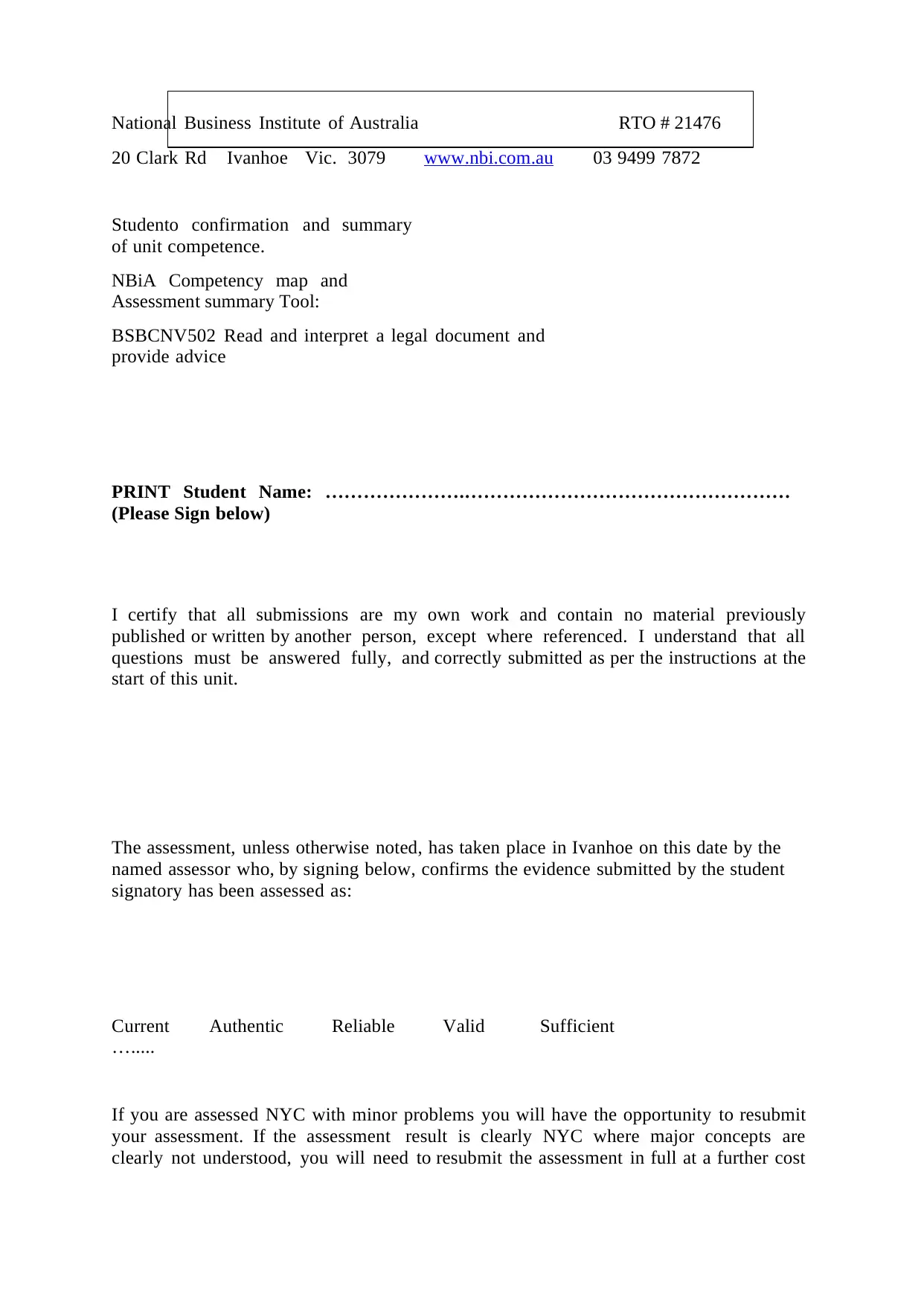
National Business Institute of Australia RTO # 21476
20 Clark Rd Ivanhoe Vic. 3079 www.nbi.com.au 03 9499 7872
Studento confirmation and summary
of unit competence.
NBiA Competency map and
Assessment summary Tool:
BSBCNV502 Read and interpret a legal document and
provide a dv ice
PRINT Student Name: ………………….……………………………………………
(Please Sign b el ow)
I certify that all submissions are my own work and contain no material previously
published or written by another person, except where referenced. I understand that all
questions must be answered fully, and correctly submitted as per the instructions at the
start of this un it.
The assessment, unless otherwise noted, has taken place in Ivanhoe on this date by the
named assessor who, by signing below, confirms the evidence submitted by the student
signatory has been assessed a s :
Current Authentic Reliable Valid Sufficient
….....
If you are assessed NYC with minor problems you will have the opportunity to resubmit
your assessment. If the assessment result is clearly NYC where major concepts are
clearly not understood, you will need to resubmit the assessment in full at a further cost
20 Clark Rd Ivanhoe Vic. 3079 www.nbi.com.au 03 9499 7872
Studento confirmation and summary
of unit competence.
NBiA Competency map and
Assessment summary Tool:
BSBCNV502 Read and interpret a legal document and
provide a dv ice
PRINT Student Name: ………………….……………………………………………
(Please Sign b el ow)
I certify that all submissions are my own work and contain no material previously
published or written by another person, except where referenced. I understand that all
questions must be answered fully, and correctly submitted as per the instructions at the
start of this un it.
The assessment, unless otherwise noted, has taken place in Ivanhoe on this date by the
named assessor who, by signing below, confirms the evidence submitted by the student
signatory has been assessed a s :
Current Authentic Reliable Valid Sufficient
….....
If you are assessed NYC with minor problems you will have the opportunity to resubmit
your assessment. If the assessment result is clearly NYC where major concepts are
clearly not understood, you will need to resubmit the assessment in full at a further cost
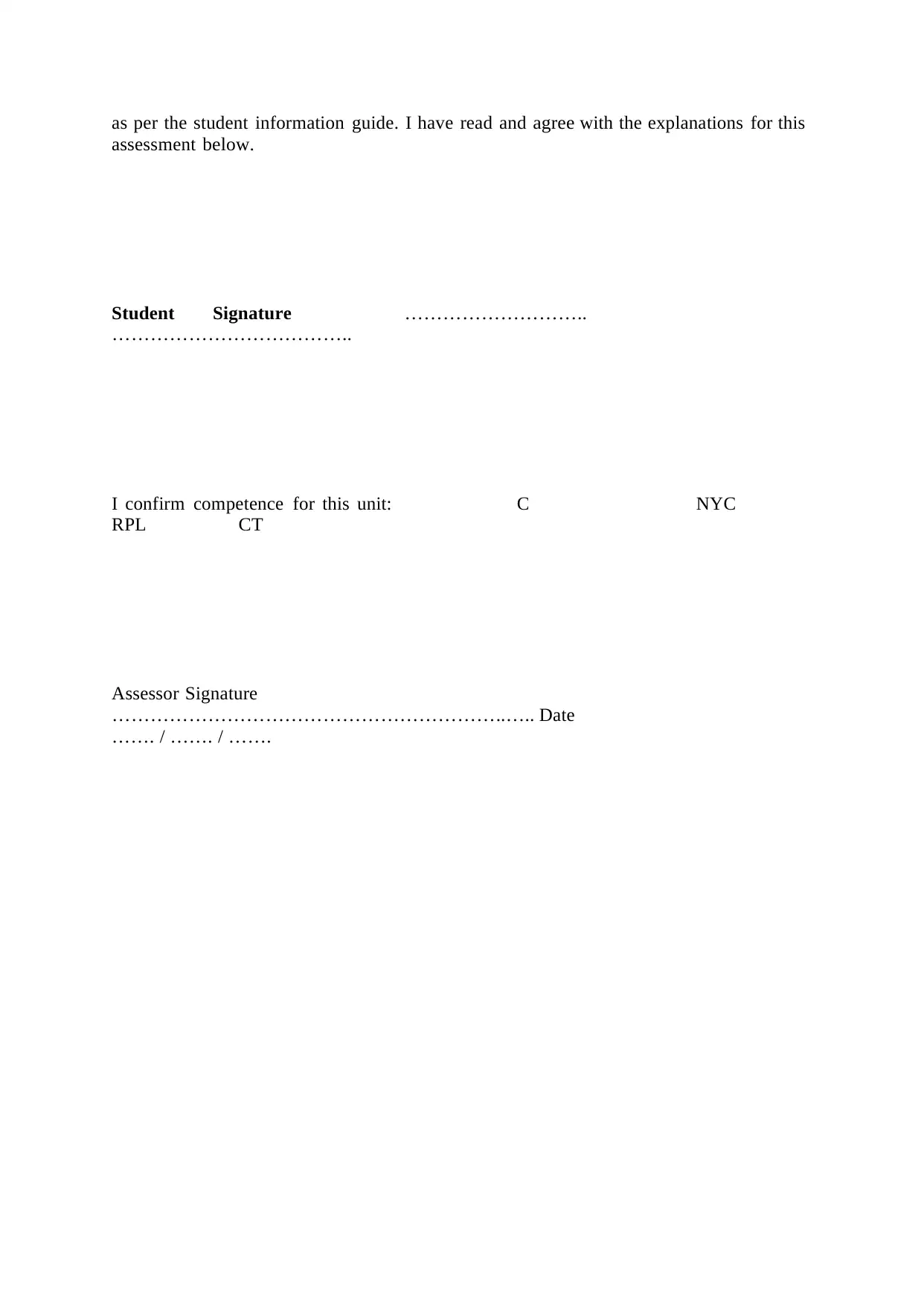
as per the student information guide. I have read and a gr ee with the explanations for this
assessment b el ow.
Student Signature ………………………..
………………………………..
I confirm competence for this unit: C NYC
RPL CT
Assessor Signature
……………………………………………………..….. Date
……. / ……. / …….
assessment b el ow.
Student Signature ………………………..
………………………………..
I confirm competence for this unit: C NYC
RPL CT
Assessor Signature
……………………………………………………..….. Date
……. / ……. / …….
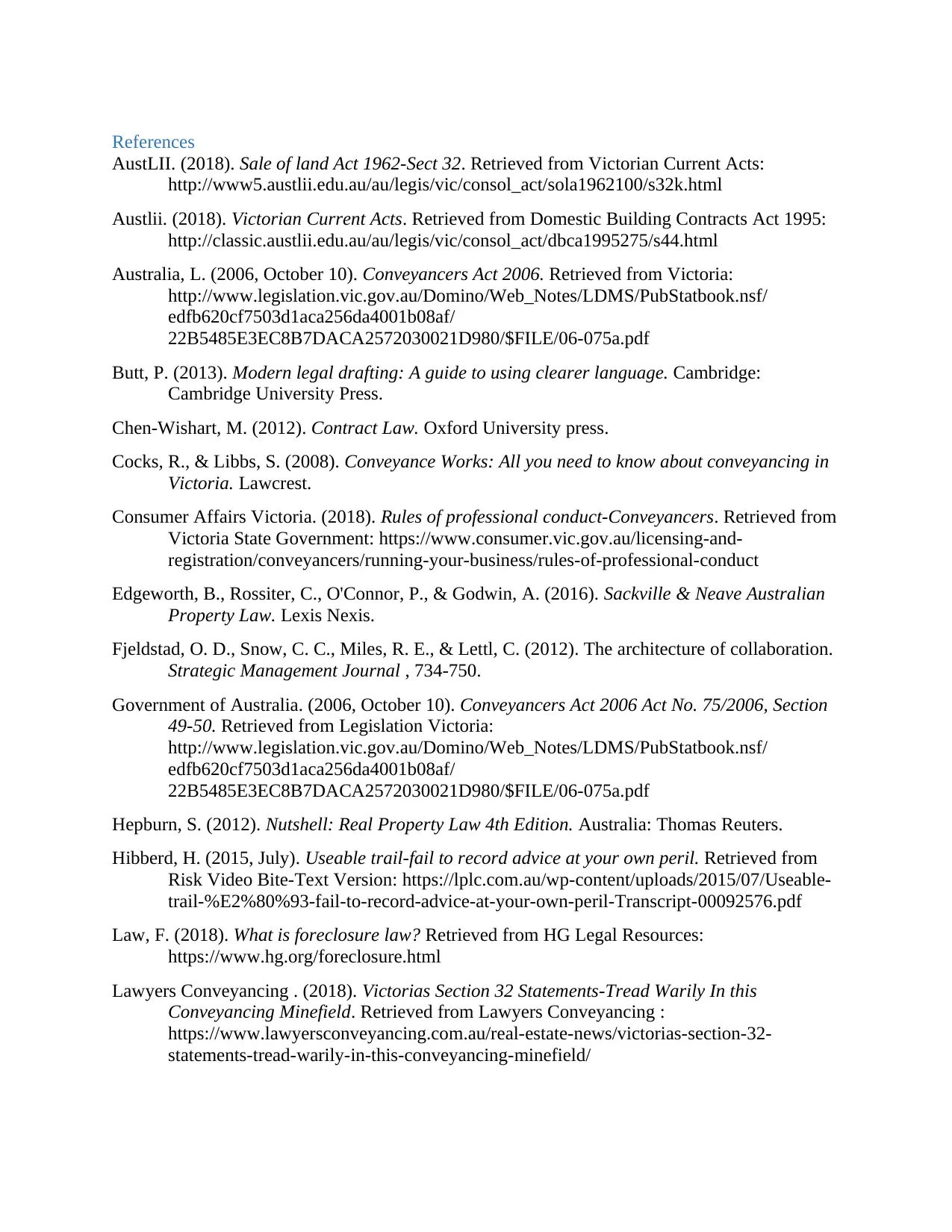
References
AustLII. (2018). Sale of land Act 1962-Sect 32. Retrieved from Victorian Current Acts:
http://www5.austlii.edu.au/au/legis/vic/consol_act/sola1962100/s32k.html
Austlii. (2018). Victorian Current Acts. Retrieved from Domestic Building Contracts Act 1995:
http://classic.austlii.edu.au/au/legis/vic/consol_act/dbca1995275/s44.html
Australia, L. (2006, October 10). Conveyancers Act 2006. Retrieved from Victoria:
http://www.legislation.vic.gov.au/Domino/Web_Notes/LDMS/PubStatbook.nsf/
edfb620cf7503d1aca256da4001b08af/
22B5485E3EC8B7DACA2572030021D980/$FILE/06-075a.pdf
Butt, P. (2013). Modern legal drafting: A guide to using clearer language. Cambridge:
Cambridge University Press.
Chen-Wishart, M. (2012). Contract Law. Oxford University press.
Cocks, R., & Libbs, S. (2008). Conveyance Works: All you need to know about conveyancing in
Victoria. Lawcrest.
Consumer Affairs Victoria. (2018). Rules of professional conduct-Conveyancers. Retrieved from
Victoria State Government: https://www.consumer.vic.gov.au/licensing-and-
registration/conveyancers/running-your-business/rules-of-professional-conduct
Edgeworth, B., Rossiter, C., O'Connor, P., & Godwin, A. (2016). Sackville & Neave Australian
Property Law. Lexis Nexis.
Fjeldstad, O. D., Snow, C. C., Miles, R. E., & Lettl, C. (2012). The architecture of collaboration.
Strategic Management Journal , 734-750.
Government of Australia. (2006, October 10). Conveyancers Act 2006 Act No. 75/2006, Section
49-50. Retrieved from Legislation Victoria:
http://www.legislation.vic.gov.au/Domino/Web_Notes/LDMS/PubStatbook.nsf/
edfb620cf7503d1aca256da4001b08af/
22B5485E3EC8B7DACA2572030021D980/$FILE/06-075a.pdf
Hepburn, S. (2012). Nutshell: Real Property Law 4th Edition. Australia: Thomas Reuters.
Hibberd, H. (2015, July). Useable trail-fail to record advice at your own peril. Retrieved from
Risk Video Bite-Text Version: https://lplc.com.au/wp-content/uploads/2015/07/Useable-
trail-%E2%80%93-fail-to-record-advice-at-your-own-peril-Transcript-00092576.pdf
Law, F. (2018). What is foreclosure law? Retrieved from HG Legal Resources:
https://www.hg.org/foreclosure.html
Lawyers Conveyancing . (2018). Victorias Section 32 Statements-Tread Warily In this
Conveyancing Minefield. Retrieved from Lawyers Conveyancing :
https://www.lawyersconveyancing.com.au/real-estate-news/victorias-section-32-
statements-tread-warily-in-this-conveyancing-minefield/
AustLII. (2018). Sale of land Act 1962-Sect 32. Retrieved from Victorian Current Acts:
http://www5.austlii.edu.au/au/legis/vic/consol_act/sola1962100/s32k.html
Austlii. (2018). Victorian Current Acts. Retrieved from Domestic Building Contracts Act 1995:
http://classic.austlii.edu.au/au/legis/vic/consol_act/dbca1995275/s44.html
Australia, L. (2006, October 10). Conveyancers Act 2006. Retrieved from Victoria:
http://www.legislation.vic.gov.au/Domino/Web_Notes/LDMS/PubStatbook.nsf/
edfb620cf7503d1aca256da4001b08af/
22B5485E3EC8B7DACA2572030021D980/$FILE/06-075a.pdf
Butt, P. (2013). Modern legal drafting: A guide to using clearer language. Cambridge:
Cambridge University Press.
Chen-Wishart, M. (2012). Contract Law. Oxford University press.
Cocks, R., & Libbs, S. (2008). Conveyance Works: All you need to know about conveyancing in
Victoria. Lawcrest.
Consumer Affairs Victoria. (2018). Rules of professional conduct-Conveyancers. Retrieved from
Victoria State Government: https://www.consumer.vic.gov.au/licensing-and-
registration/conveyancers/running-your-business/rules-of-professional-conduct
Edgeworth, B., Rossiter, C., O'Connor, P., & Godwin, A. (2016). Sackville & Neave Australian
Property Law. Lexis Nexis.
Fjeldstad, O. D., Snow, C. C., Miles, R. E., & Lettl, C. (2012). The architecture of collaboration.
Strategic Management Journal , 734-750.
Government of Australia. (2006, October 10). Conveyancers Act 2006 Act No. 75/2006, Section
49-50. Retrieved from Legislation Victoria:
http://www.legislation.vic.gov.au/Domino/Web_Notes/LDMS/PubStatbook.nsf/
edfb620cf7503d1aca256da4001b08af/
22B5485E3EC8B7DACA2572030021D980/$FILE/06-075a.pdf
Hepburn, S. (2012). Nutshell: Real Property Law 4th Edition. Australia: Thomas Reuters.
Hibberd, H. (2015, July). Useable trail-fail to record advice at your own peril. Retrieved from
Risk Video Bite-Text Version: https://lplc.com.au/wp-content/uploads/2015/07/Useable-
trail-%E2%80%93-fail-to-record-advice-at-your-own-peril-Transcript-00092576.pdf
Law, F. (2018). What is foreclosure law? Retrieved from HG Legal Resources:
https://www.hg.org/foreclosure.html
Lawyers Conveyancing . (2018). Victorias Section 32 Statements-Tread Warily In this
Conveyancing Minefield. Retrieved from Lawyers Conveyancing :
https://www.lawyersconveyancing.com.au/real-estate-news/victorias-section-32-
statements-tread-warily-in-this-conveyancing-minefield/
Paraphrase This Document
Need a fresh take? Get an instant paraphrase of this document with our AI Paraphraser
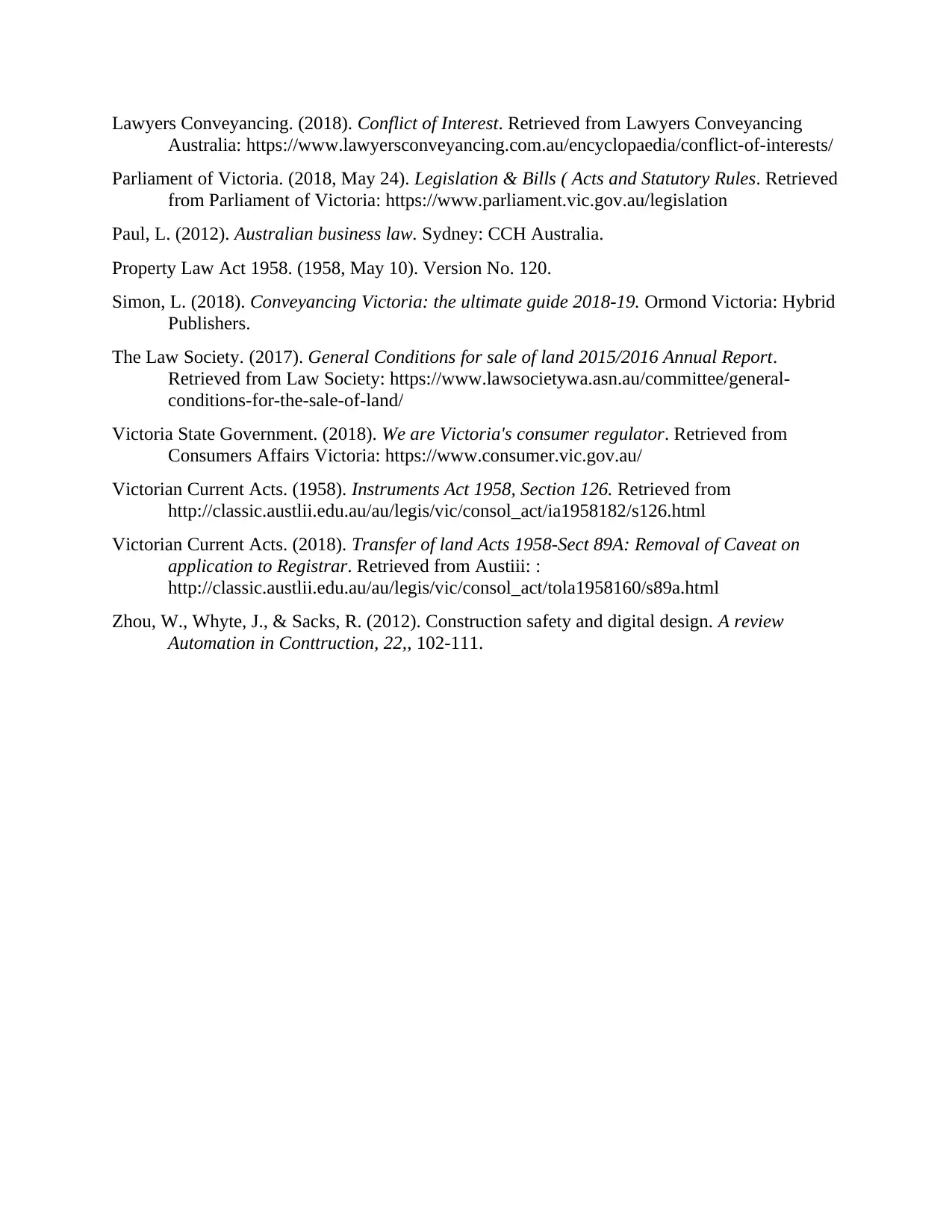
Lawyers Conveyancing. (2018). Conflict of Interest. Retrieved from Lawyers Conveyancing
Australia: https://www.lawyersconveyancing.com.au/encyclopaedia/conflict-of-interests/
Parliament of Victoria. (2018, May 24). Legislation & Bills ( Acts and Statutory Rules. Retrieved
from Parliament of Victoria: https://www.parliament.vic.gov.au/legislation
Paul, L. (2012). Australian business law. Sydney: CCH Australia.
Property Law Act 1958. (1958, May 10). Version No. 120.
Simon, L. (2018). Conveyancing Victoria: the ultimate guide 2018-19. Ormond Victoria: Hybrid
Publishers.
The Law Society. (2017). General Conditions for sale of land 2015/2016 Annual Report.
Retrieved from Law Society: https://www.lawsocietywa.asn.au/committee/general-
conditions-for-the-sale-of-land/
Victoria State Government. (2018). We are Victoria's consumer regulator. Retrieved from
Consumers Affairs Victoria: https://www.consumer.vic.gov.au/
Victorian Current Acts. (1958). Instruments Act 1958, Section 126. Retrieved from
http://classic.austlii.edu.au/au/legis/vic/consol_act/ia1958182/s126.html
Victorian Current Acts. (2018). Transfer of land Acts 1958-Sect 89A: Removal of Caveat on
application to Registrar. Retrieved from Austiii: :
http://classic.austlii.edu.au/au/legis/vic/consol_act/tola1958160/s89a.html
Zhou, W., Whyte, J., & Sacks, R. (2012). Construction safety and digital design. A review
Automation in Conttruction, 22,, 102-111.
Australia: https://www.lawyersconveyancing.com.au/encyclopaedia/conflict-of-interests/
Parliament of Victoria. (2018, May 24). Legislation & Bills ( Acts and Statutory Rules. Retrieved
from Parliament of Victoria: https://www.parliament.vic.gov.au/legislation
Paul, L. (2012). Australian business law. Sydney: CCH Australia.
Property Law Act 1958. (1958, May 10). Version No. 120.
Simon, L. (2018). Conveyancing Victoria: the ultimate guide 2018-19. Ormond Victoria: Hybrid
Publishers.
The Law Society. (2017). General Conditions for sale of land 2015/2016 Annual Report.
Retrieved from Law Society: https://www.lawsocietywa.asn.au/committee/general-
conditions-for-the-sale-of-land/
Victoria State Government. (2018). We are Victoria's consumer regulator. Retrieved from
Consumers Affairs Victoria: https://www.consumer.vic.gov.au/
Victorian Current Acts. (1958). Instruments Act 1958, Section 126. Retrieved from
http://classic.austlii.edu.au/au/legis/vic/consol_act/ia1958182/s126.html
Victorian Current Acts. (2018). Transfer of land Acts 1958-Sect 89A: Removal of Caveat on
application to Registrar. Retrieved from Austiii: :
http://classic.austlii.edu.au/au/legis/vic/consol_act/tola1958160/s89a.html
Zhou, W., Whyte, J., & Sacks, R. (2012). Construction safety and digital design. A review
Automation in Conttruction, 22,, 102-111.
1 out of 32
Your All-in-One AI-Powered Toolkit for Academic Success.
+13062052269
info@desklib.com
Available 24*7 on WhatsApp / Email
![[object Object]](/_next/static/media/star-bottom.7253800d.svg)
Unlock your academic potential
© 2024 | Zucol Services PVT LTD | All rights reserved.
